BULLETIN 244
EARLY PRINTED BOOKS c1497-1700
FIFTEENTH CENTURY

The Ontological Proof
1. ANSELM, Saint [1033-1109]. Opuscula [Opera]. small 4to. [ff. 208]. 2 columns. 49 lines & headline. gothic type. capital spaces with guide letters. later full vellum (front hinge cracked, dampstaining to upper portion of leaves, generally light to moderate, scattered light foxing, tear in upper blank margin of title repaired). [Basel: Johann Amerbach, not after 1497]. $7,000
Third Collected Edition of the works of the mediaeval philosopher, theologian, and church official, who held the office of Archbishop of Canterbury from 1093 until his death. Anselm is regarded as the founder of scholastic theology. He was canonized in 1494. Included here are his three most famous works, the Cur Deus Homo, a treatise on the atonement, and the Proslogion, and the Monologion, which contain his formulation of the ontological proof of the existence of God (God is that than which nothing greater can be conceived; that than which nothing greater can be conceived must exist; therefore God exists). Although it attracted little interest at the time, the argument has long generated intense debate among philosophers, being taken up by Descartes and Leibnitz, and rejected by Hume and Kant.
BM III 759. Goff A-761. GW 2033. Hain Copinger 1136. Pellechet 799. Polain (B) 230. Proctor 7648.
SIXTEENTH CENTURY

2. AESCHYLUS, SOPHOCLES, EURIPIDES. Tragoediae selectae… 2 Parts in 1 volume. 16mo. pp. 2 p.l.,279 [ i.e. 379], [2 blank leaves]; 955. text in Greek & Latin. woodcut printer’s device on title. contemporary vellum (binding held on by one cord only, ink deletion on title obscuring printer’s device, light dampstain to lower inner margin of first half of text). [Geneva]: Henri Estienne, 1567. $1,350
A pocket edition of eight Greek tragedies: one by Aeschylus (Prometheus), three by Sophocles (Ajax, Electra, Antigone), and four by Euripides (Hecuba, Iphigenia in Aulis, Medea, Alcestis). “Each play (except Prometheus) is accompanied by two Latin versions, one in verse, and one in prose; for Prometheus, only the prose version (by M. Garbitius) is given. The translations are by Erasmus, Melanchthon, G.Buchanan, Joachim Camerarius, and G.Rotallerus. The four plays of Euripides represent the only tragedies of Euripides printed by Henri Estienne, who never published an edition of that author – a lacuna which his son Paul was to fill in 1602.” (Schreiber)
Adams A269. Renouard p. 130, no. 5. Schreiber 169. Brunet V 913-14.
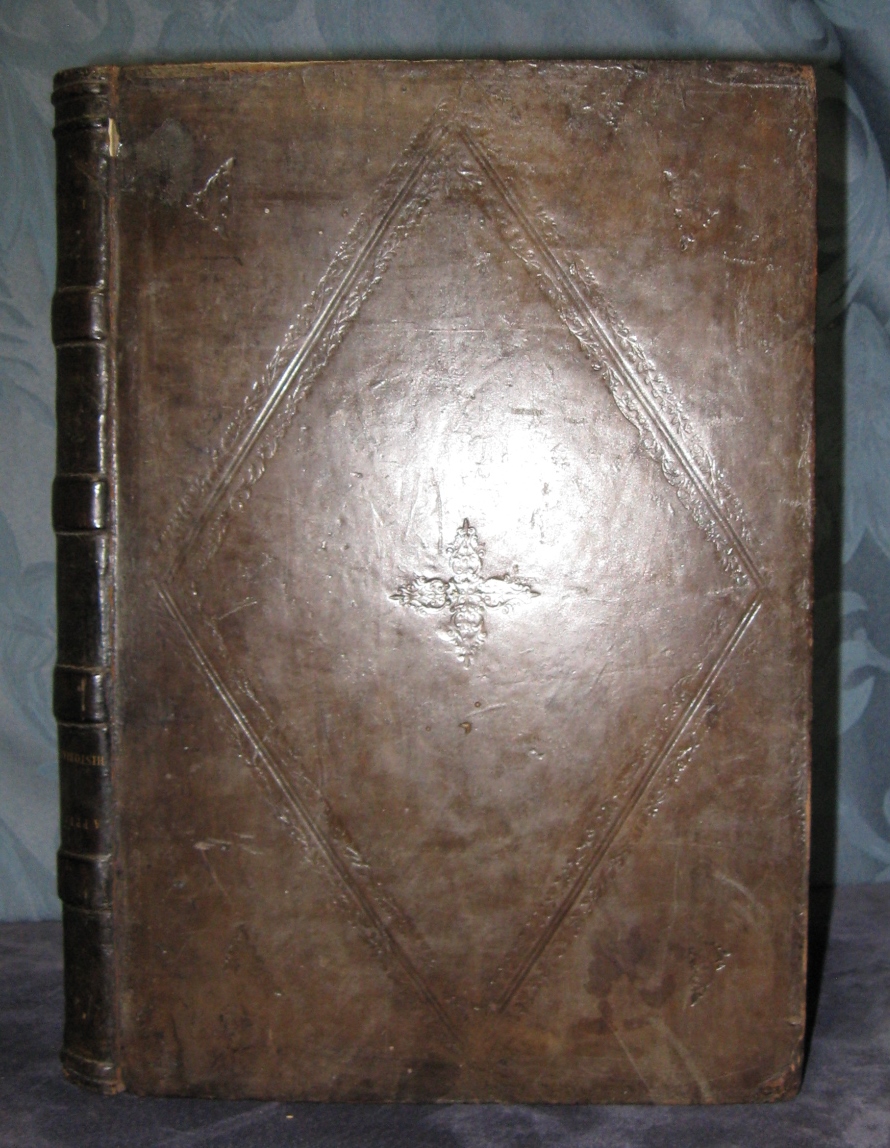
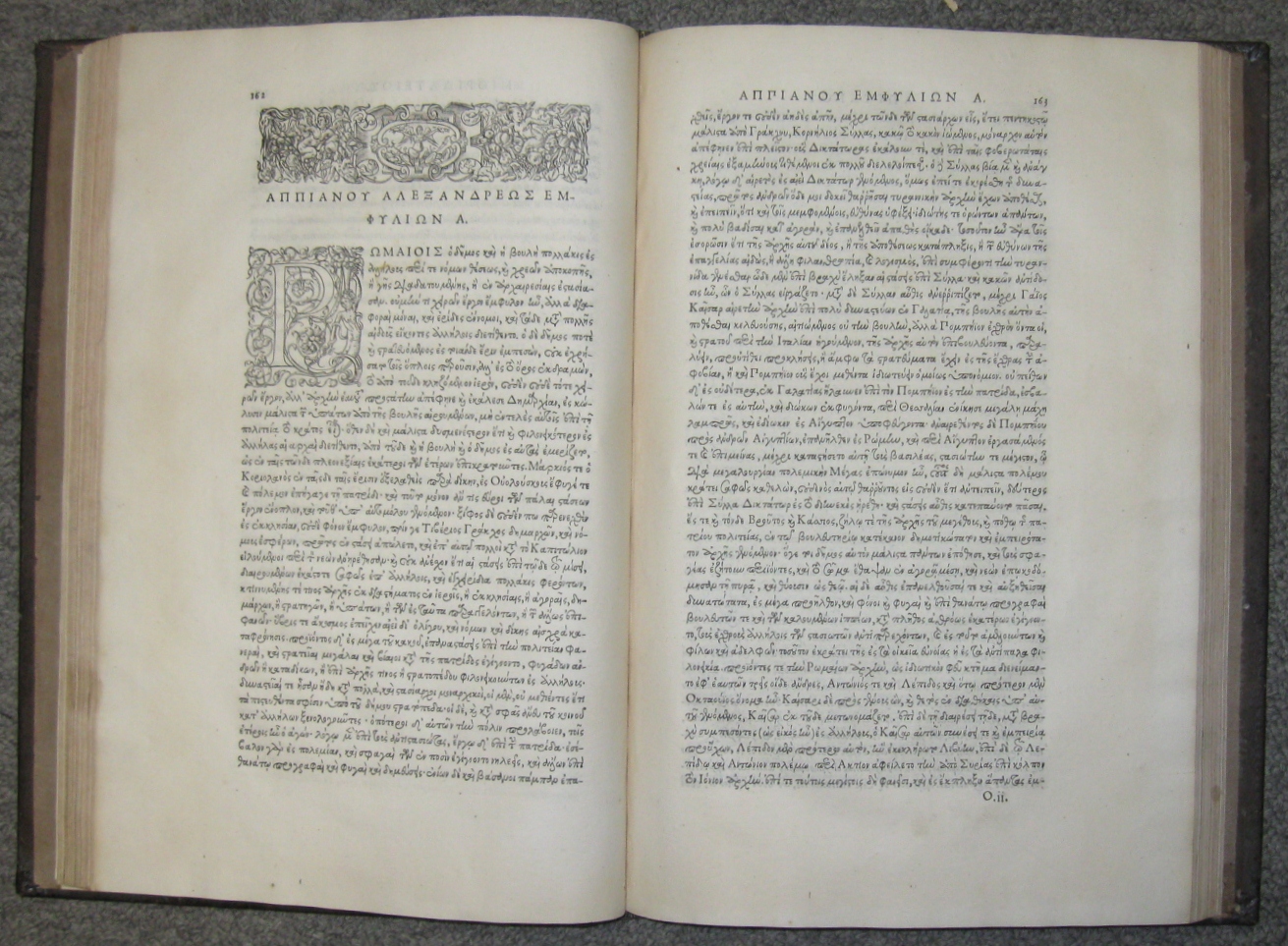
“There are few Greek volumes of more beautiful execution
than this Editio Princeps of Appian.”
3. APPIAN, of Alexandria [c95-c165]. [Greek Title]…Romanarum Historiarum…Ex Bibliotheca Regia. folio. pp. 393, [2]. Greek letter. Estienne’s basilisk device as king’s printer for Greek texts on title. foliated & grotesque woodcut ornaments & initials by Geoffrey Tory. An attractive copy in 19th century blind-tooled calf in 16th century style (private library stamp on front flyleaf). armorial bookplate of L.K.Elmhirst. Paris: Charles Estienne, 1551. $6,000
Editio Princeps of the Appian’s history of Rome to the time of the accession of Vespasian in 70 A.D., a work of particular value for containing the only comprehensive and detailed information available for the period of the civil wars. It is one of a series of Greek texts printed by the Estiennes from manuscripts in the royal library, but the first of only two Greek works to bear Charles Estienne’s imprint. The project was initiated by his brother Robert but completed by Charles following Robert’s departure from Paris. Unfortunately Charles was not a businessman by inclination, and after only ten years as head of the press, he was reduced to poverty and died in debtor’s prison.
“This volume is generally cited as the supreme example of the use of the Royal Greek types; it is, in fact, the first classical text printed in all three sizes of [Garamond’s] “grecs du roi” (first used together the preceding year in the New Testament…”. (Schreiber) ”One of the most exquisite books printed from these fonts is Charles and Robert Estienne's Greek edition of Appian…All three sizes of type are used in it. The type in mass, and the proportion and imposition of the type-page, are very splendid, and there is another reason for looking at it. The superb decorations and initials by [Geoffrey] Tory are wonderful, in their accord with the colour of the Greek text, in their printable qualities and in their grace of design.” (D. B. Updike, Printing Types I, 23-8) “There are few Greek volumes of more beautiful execution than this Editio Princeps of Appian.” (Dibdin)
Adams A-1340. BM STC French p. 21.Dibdin (4th Edn.). I pp. 279-80.Renouard 102.4. Mortimer, French 16th Century Books, 29. Schreiber 126. Brunet I 356.


4. ARISTOTLE. L'Ethica...Tradotta In Lingua Vulgare Fiorentina Et Comentata Per Bernardo Segni. 4to. pp. 547, [11]. title within elaborate architectural woodcut border. several diagrams in the text. historiated initials. A fine copy in 19th century vellum, overlapping fore-edges (covers slightly bowed). Florence: [Lorenzo Torrentino], 1550. $3,300
First Edition of the celebrated Italian Translation, with commentary, by Bernardo Segni [d. 1558]. "On ne trouve pas facilement cette traduction; elle a du mérite, au moins pour le style, puisqu'elle est citée dans le Vocabulaire de la Crusca..." (Brunet) The work is dedicated, as most of Segni's vernacular translations, to Cosimo de' Medici.
BM STC Italian p. 46. Brunet I 467. Cranz 108.176. Gamba 87. Graesse I 218. Moss I p. 181. Riley 111. Not in Adams.

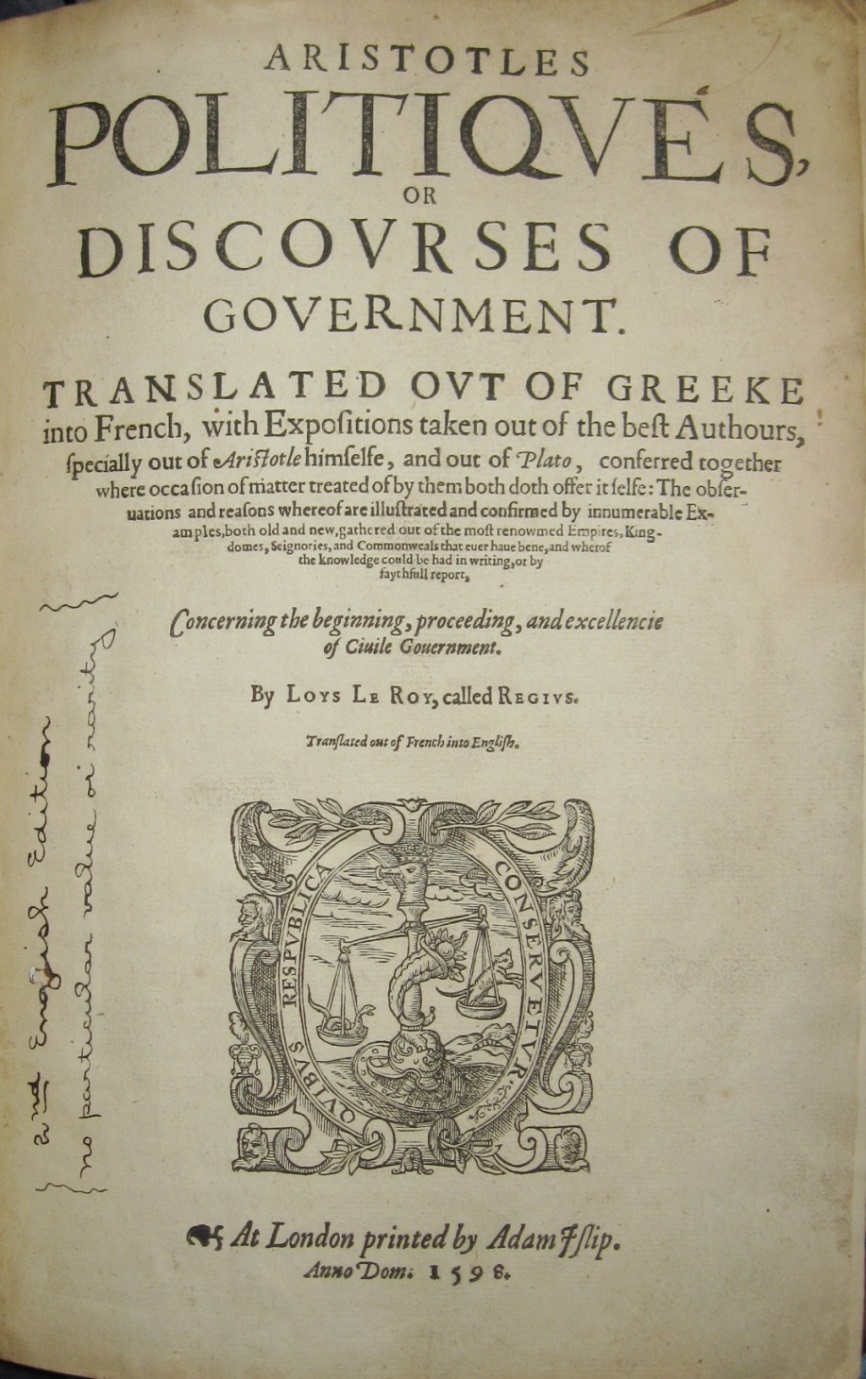
5. ARISTOTLE. Politiques, Or Discourses Of Government. Translated Out Of Greeke into French, with Expositions taken of the best Authours…By Loys Le Roy, called Regius. Translated out of French into English [By I.D.]. folio. pp. 15 p.l., 393, [5]. lacks first & last blanks. woodcut printer’s device on title. woodcut ornaments & initials. new half calf over 18th century marbled bds. (lower corner of Ffiiii torn away with loss of several letters of text, sidenotes shaved on Hvi, staining to lower inner margins in last gatherings, a few leaves browned and/or foxed, ink notation & small hole in blank portion of title). London: Printed by Adam Islip, 1598. $16,500
First Edition of the English Translation of Aristotle’s Politics in which he discusses the theory of constitutions, oligarchy, democracy, commonwealth, and tyranny, the various powers of government, revolution and the means of preserving states, the different offices of the state, and the right form of constitution. “Aristotle is not only one of the great classical philosophers, the master of every branch of ancient knowledge: his method still underlies all modern thinking.” (PMM)
“The Politics…may be compared with Adam Smith’s Wealth of Nations for its union of analytic theory with knowledge of historical and contemporary data. Aristotle had prepared descriptions of one hundred and fifty-eight ‘polities’ or constitutions (all now lost except one, the Constitution of Athens…)…Aristotle’s political principles have entered into the subsequent course of social thought. He taught that the state was natural and that man was naturally a political being. He taught that law was sovereign and that the magistrates were servants of the laws; he distinguished ‘normal’ forms of states from ‘perverted’ forms and taught succeeding ages the difference between monarchy and tyranny; he investigated the deserts and capacities of the people, and while he criticized democracy he argued none the less that the people, especially because of their capacity for collective judgment, should elect their officers and call them to account. These were not ignoble lessons; and the whole history of political theory to the close of the Middle Ages shows how steadily they were conned. St. Thomas Aquinas, Dante and Marsiglio of Padua were all pupils of Aristotle in politics; and if the school of natural rights and social contract introduced a new line of approach in the seventeenth century, it did not in all respects improve upon Aristotle and in some it simply continued his teaching.” (Ernest Barker, Encyc. of Social Sciences)
Cranz 110. Graesse I 221. NCBEL I 2166. Pforzheimer 10. Printing and the Mind of Man 38n. Riley 203. STC 760.


6. [BENEDICT, Saint, Abbot of Monte Cassino] [c480-c544].La tresample et vraye exposition de la Reigle monsieur Sainct Benoist: tres Utile et nécessaire à toutes gens de Religion... [by Thibaud Arthauld]. folio. ff. [176]. complete with final blank. Vostre's large shield device on title, large woodcut of the crucifixion on verso. fine criblé initials throughout. printed in bâtard type in double columns. A very nice (washed) copy (occasional light foxing), handsomely bound in full blind & gilt-stamped brown morocco in antique style, all edges gilt, by the French binders, Garden City, New York, ‘H.Hardy, relieur, 1939, G.Pilon, doreur'. contemporary ownership inscription of the Celestine Monks of St. Malo on the second leaf. Kalbfleisch leather ex-libris. Paris: [Pierre Vidoue for] Simon Vostre, [1510?]. $6,500
An exposition of the Benedictine Rule, which became the foundation of the monastic system in the West. Saint Benedict established his monastery at Monte-Cassino, near Naples, about 529, and instituted as the rule of his order, in addition to religious duties, various kinds of manual labour, the instruction of the young, and the transcription of valuable manuscripts. He eliminated the elements of Oriental asceticism, extreme bodily austerity, and eremitism from monastic life, insisting upon moderation, community life and family spirit. "[The Benedictine Rule] holds the first place among monastic legislative codes, and was by far the most important factor in the organization and spread of monasticism in the West." (Catholic Encyclopedia)
BM STC French p. 47. Not in Adams.
7. BIBLE. ENGLISH. The Bible, That Is, The holy Scriptures… 4to. ff. [3], 190, 127, [1]blank; 121, [11]; [55]. lacking A1 (blank?). 3 Volumes in 1 (the first in 2 parts). New Testament title within elaborate woodcut border. lacking general title with woodcut border. numerous woodcut text illus. (incl. 1 map & title vignette). woodcut ornaments & initials. early paneled calf (old repairs, leather worn & cracked, smooth surface layer of leather wanting from spine, lacking free-endpapers, occasional stains & dampmarks, several rust holes in last few leaves affecting several letters of text, small hole in blank margin of title, lower outer corner of fo. 39 in NT torn away with some loss). ownership entry of Jonathan Parker, dated Feb. 3, 1768, with several notes in his hand. London: the Deputies of Christopher Barker, 1599. $3,000
Geneva Version; with Tomson’s NT, but with Junius’ Revelation. This copy agrees with Herbert 248 (based on Pocock, 1883), identified as the earliest of this group of quarto bibles with 1599 Barker imprint as it abounds with gross errors. All were apparently printed in the Low Countries for surreptitious import into England. Herbert suggests that this edition was perhaps printed at Amsterdam about 1599. STC on the other hand (citing The Library, 1954) suggests that it was printed at Amsterdam by J.F.Stam, after 1640(?).
Darlow & Moule 188. Herbert 248. Pforzheimer 60. STC 2174 with 2499 [The Book of Psalmes, Amsterdam: J.F.Stam, after 1640?].

Illustrated Bible
8. BIBLE. LATIN. Biblia cum concordantiis veteris & novi testamenti… folio. ff. [14], 317, [26]. with blank R6 but without final blank. title in red & black with elaborate woodcut border, large vignette incorporating arms of Lyons & with red fleur de lys. numerous woodcuts in the text (2 full-page; 2 cuts inexpertly coloured). numerous woodcut initials. each page of text with woodcut border at top & bottom. text in double columns. black letter. full modern calf (some staining to outer leaves, some underlining & marginal notes, 2 small rust holes in title & following leaf with very slight loss). armorial bookplate of Henry James Grasett [1808-82], Rector of St. James Cathedral (1847-82) & Dean of Toronto (1867-82). [Colophon on R5v:] Lyons: Printed by Jacques Saçon for Anton Koberger of Nuremberg, 1521. $6.500
One of a series of attractively illustrated editions printed by Jacques Saçon for Anton Koberger of Nuremberg. The woodcuts, many of which were also used by Jean Marion for two editions printed for Koberger in 1520, were the work of Hans Springinklee and Erhard Schön. The two full-page cuts depict the six days of creation and the nativity - the latter is reproduced in Mortimer.
Adams B1001. Baudrier XII pp. 357-58. BM STC French p. 53. Darlow & Moule 6101 (incomplete). cfMortimer, 16th Century French 63.
9. BIBLE. LATIN. Biblia Sacra Ex Sebastiani Castalionis postrema recognitione… 2 Parts in 1. folio. [ff. 8], 1445 numbered columns, [1 page]; col. 404, [blank leaf], [ff. 32]. first title within elaborate woodcut border. large woodcut device on second title & at end. woodcut text illus. & diagrams. woodcut initials. contemporary blind-stamped pigskin (soiled & worn but solid, corners damaged, short splits in upper joints, scattered light foxing & marginal stains, edges of first leaves bit chipped, title soiled). Basel: Peter Pera, [August] 1573. $2,000
Fourth Edition of Sebastien Châteillon’s scholarly annotated Latin Translation (first 1551). The French theologian was one of the first Reformers to propound religious toleration, and freedom of conscience and thought. “Châteillon aroused bitter hostility among Calvin’s followers by the publication of his Latin and French translations of the Bible. He defended these in a text published at Basel in 1562, to which Beza replied in 1563. A striking characteristic of Châteillon’s Latin version is his use of classical substitutes for recognized ecclesiastical terms…”. (Darlow & Moule)
Adams B1083. BM STC German p. 87. Copinger 459. Darlow & Moule 6159.
10. BONARDO, Gio[vanni] Maria. La Grandezza, Larghezza, E Distanza Di Tutte Le Sfere ridotte a nostre miglia… 8vo. ff. 132, [4]. full-page woodcut portraits of the author & of Luigi Grotto Cieco D’Adria, who wrote the notes. woodcut device on title. woodcut ornaments & initials. modern vellum, overlapping fore-edges (light dampstaining to outer leaves). Venice: Fabio & Agostino Zoppini, 1589. $850
Fifth Edition (first: 1563). Houzeau & Lancaster state that in his notes Grotto regards spheres as being originally in equilibrium in space, and that they move as a result of magnetic attraction produced by more distant bodies.
Adams B2379. Houzeau & Lancaster 2618. This edition not in BM STC Italian.
11. CAMDEN, William [1551-1623]. Britannia Sive Florentissimorum Regnorum, Angliae, Scotiae, Hiberniae, Et Insularum adiacentium ex intima antiquitate Chorographica descriptio... 2 Parts in 1 with continuous pagination. 8vo. pp. 8 p.l., 648, [21]index, [1]errata. woodcut ornament & cartouche on first title, ornament on 2nd title. woodcut ornaments & initials. later paneled calf (spine dry & flaking, front joint cracked, corners worn, some light foxing & browning). 2 early ownership entries on title. from the library of Thomas Cushing Aylwin [1806-71], lawyer, politician and high court justice of Lower Canada. London: Ralph Newbery, 1587. $1,500
Second Edition (first published the previous year). The great Elizabethan topographical-historical description of England consumed ten years' travel, study and effort. Camden had to learn Welsh and Anglo-Saxon in order to read both native and other historians, many still in manuscript, and to carefully peruse the public records. The work went through five London editions plus another at Frankfort by 1600, although it was not translated into English until 1610.
STC 4504. cfRead 302. cfPrinting and the Mind of Man 101.
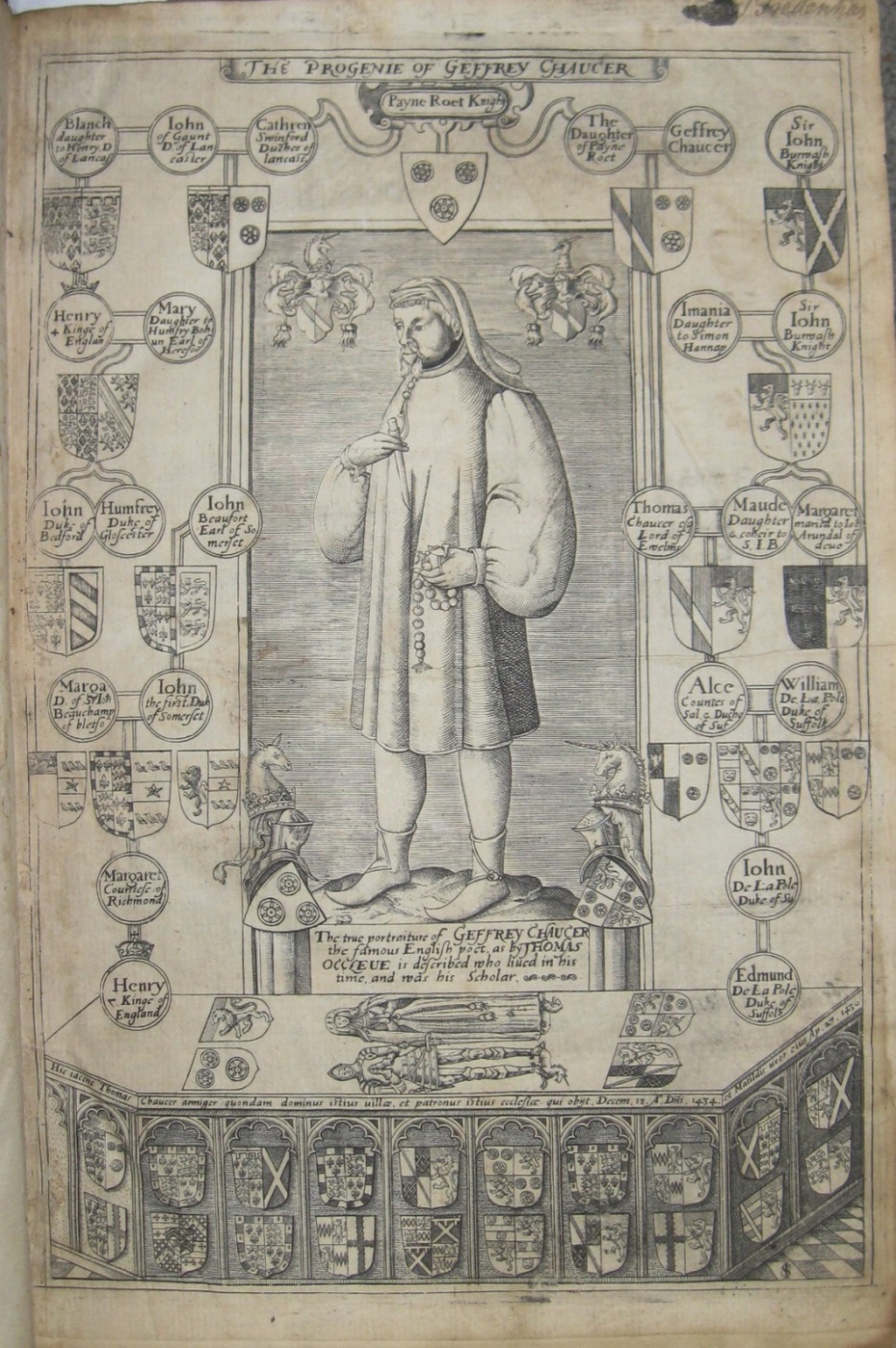
12. CHAUCER, Geoffrey [c1343-1400].The Workes… folio. irregular foliation: ff. 1-232, 232, 232-235, 242-243, 246, 243-245, 241, 241-246, 248-300, 302-308, 308-309, 311-314, 321, 317-337, 340-344, 339, 348-358, 358, 360-392, 395, 394. lacking folio 300 (Iii1) & portion of folio 301 (Iii2) & last 15 leaves containing the glossary and errata. 1 leaf misbound. black letter. general title & 2 divisional titles within woodcut borders. engraved portrait of Chaucer by John Speed after Thomas Hoccleve surrounded by armorial devices & a family tree. full-page woodcut of Chaucer’s coat of arms. large woodcut headpiece of a knight on horseback. woodcut initials. full leather, c1900 (worn but solid, some browning & occasional stains, corners of several leaves torn away with slight loss, repair to folio 336 with some loss, outer margin of title frayed & repaired with slight loss of border, several other marginal repairs, first divisional title shaved at outer edge). a few old ms. notes. London: Printed by Adam Islip for Thomas Wight, 1598. $7,500
Sixth Edition, the first to be edited by Thomas Speght; issue with Wight imprint. This edition contains the first portrait of Chaucer, the first life of Chaucer printed in English (albeit largely fictitious), some previously unpublished material, Chaucer’s English translation of Boethius’ Consolation of Philosophy, and several works incorrectly attributed to Chaucer.
“[Chaucer] is the first great figure of modern English literature, the first great humorist of modern Europe, and the first great writer in whom the dramatic spirit, so long vanished and seemingly extinct, re-appears. Except Dante, there is no poet of the middle ages of superior faculty and distinction.” (DNB) Among his many works, which include The Book of the Duchess, the House of Fame, the Legend of Good Women and Troilus and Criseyde, he is best known today for The Canterbury Tales. Chaucer championed the use of the vernacular, Middle English, at a time when the dominant literary languages in England were French and Latin. In the sixteenth and seventeenth centuries, he was printed more than any other English author, and he was the first English author to have his works printed in single-volume collected editions.
STC 5079. Pforzheimer 177. cfGrolier 1.
13. CHYTRAEUS, Nathan [1543-1598]. Oratio De Astronomia seu Uranoscopium Christianum… 8vo. unpaginated. woodcut printer’s device on title. modern bds. (paper embrowned). Rostock: Myliander, 1591. $800
First Edition. An extremely rare treatise and scarce imprint. Poet, philologist, and theologian Nathan Chytraeus, was the younger brother of the theologian David Chytraeus, a disciple of Philip Melanchton. Nathan was a professor first at the University of Rostock, where he is credited with founding the library in 1569, and later at the Gymnasium in Bremen.
Not in Adams or BM STC German.
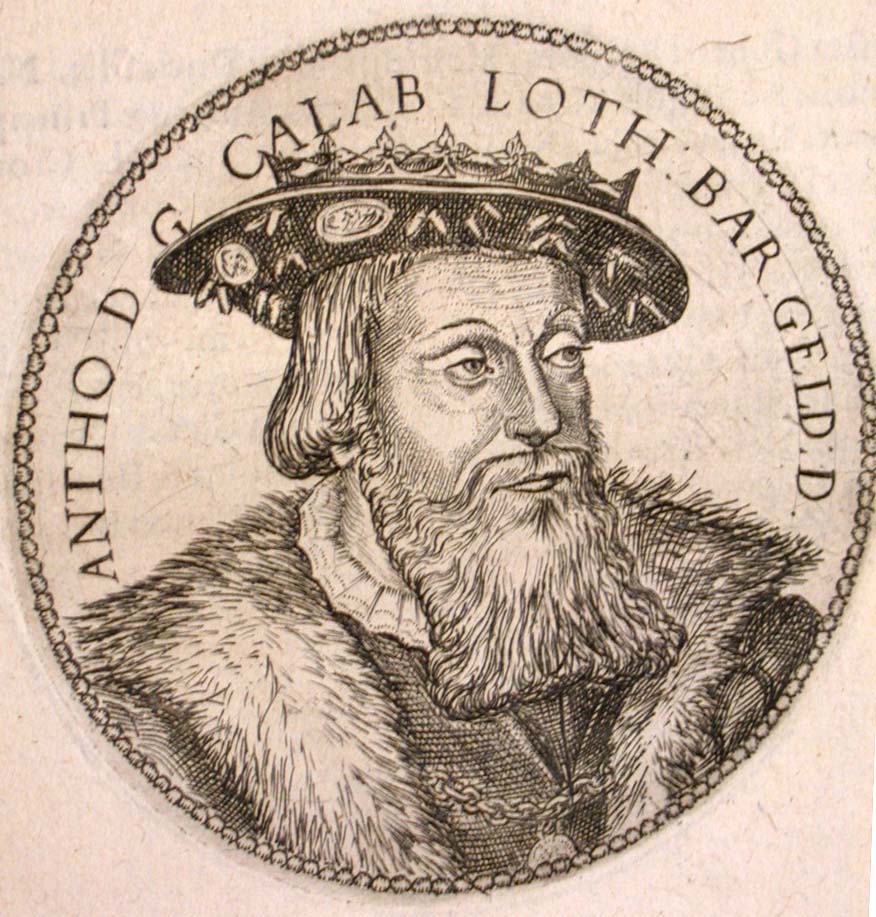
14. CLÉMENT, Nicolas. Austrasiae Reges Et Duces Epigrammatis. small 4to. pp. 4 p.l., 130. large engraved title vignette, & 63 engraved portrait medallions by P.Woeiriot. woodcut initials & tailpiece. later vellum (covers warped, occasional light foxing, the centre of title vignette, which is blank, has been cut out & backed with paper). Cologne: 1591. $2800
First Edition (a French translation was published the same year). Collection of finely engraved portrait medallions of the Dukes of Lorraine by Pierre Woeiriot de Bouzey [c1531-1596]. Woeiriot was for a time sculptor to the Duke of Lorraine. After studies in Italy, he settled in Lyons in 1555 as an engraver, producing many historical plates and portraits, as well as a large number of patterns for goldsmiths. He is particularly noted for his skill at portraiture. Each portrait is accompanied by a Latin epigram and a short biographical sketch, also in Latin. At the end are five distiches on Louis III of Outremer by François Guibaudet, who edited the work for publication after the author’s death, and fifteen hexameter verses addressed to Prince Henry of Lorraine by N.Lombard. Prefixed are a Latin epistle by François Guibaudet, six distiches by Clément, and Clément’s dedicatory epistle dated 2 June 1573 to Duke Charles III of Lorraine.
Brunet II 97. Picot, Rothschild, III 2335. Robert-Dumesnil XI p. 344. Not in Adams.
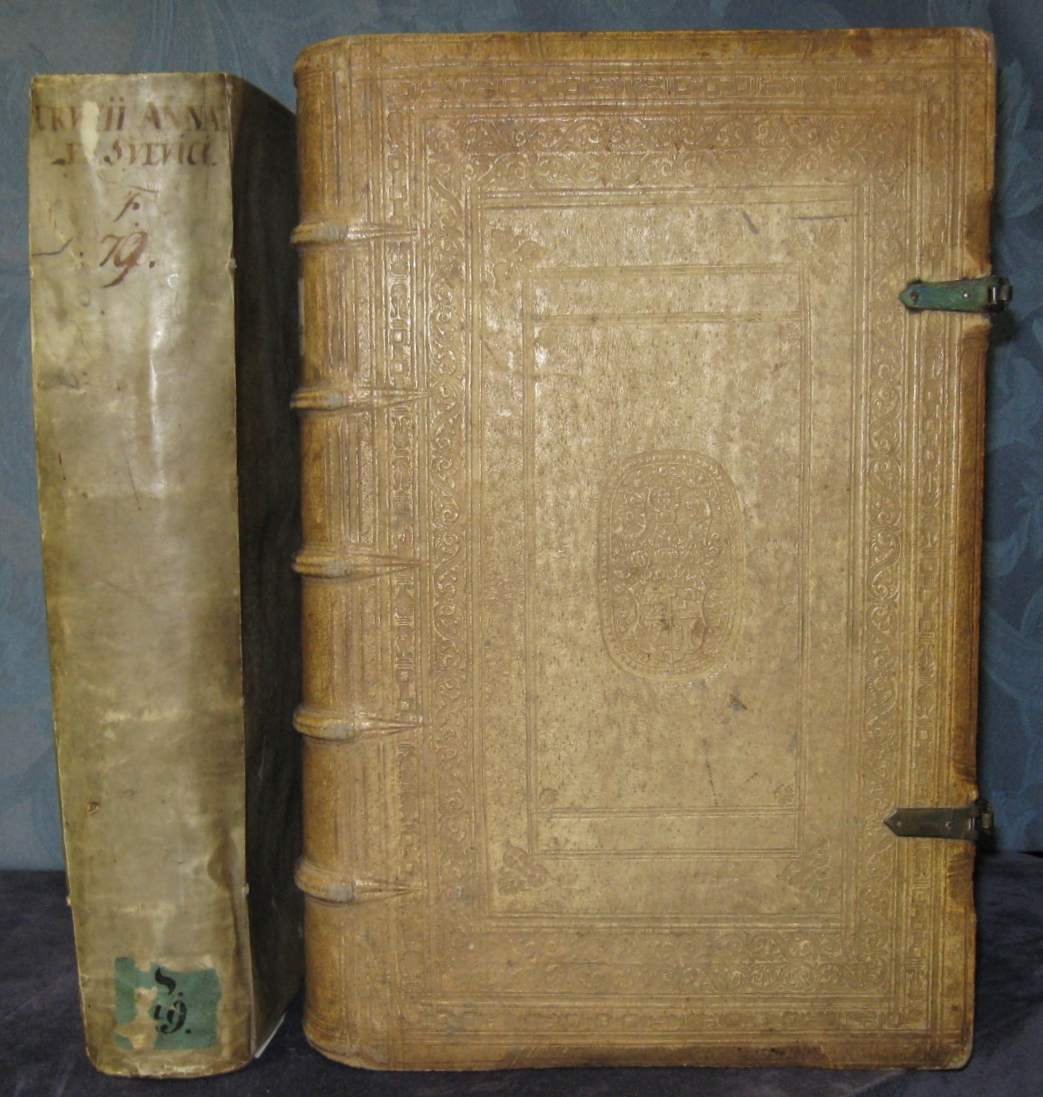
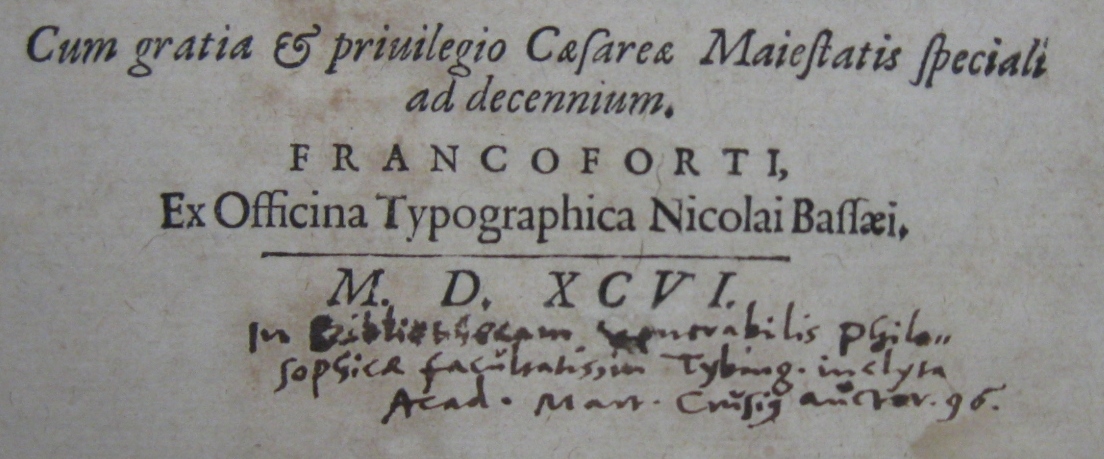
15. CRUSIUS, Martin [1526-1607]. Annales Suevici sive Chronica Rerum Gestarum Antiquissimae Et Inclytae Suevicae Gentis... 4 Parts in 2 Volumes. folio. pp. 6 p.l., 338, [18]; 4 p.l., 574, [25]; 6 p.l., 846, [44], [blank leaf]; 3 p.l., 131, [5], [1 leaf]. first title in red & black with woodcut vignette. woodcut portrait of the author on verso of first title, recto of each of the other 3 titles & on Aaaaa3v. large woodcut printer's device on recto of final leaf of supplement. several woodcuts in third part. woodcut ornaments & initials. the first 2 parts bound in contemporary limp vellum, the final 2 parts bound in contemporary blind-stamped pigskin over wooden bds. with the Würtemberg arms on the covers, brass clasps (1 original) & catches (uniform foxing & browning throughout, some marginal dampstaining in Vol. I & first part of Vol. II, but generally a nice set). Frankfurt: Nikolaus Bassée, 1595-96. $6,600
First Edition of the Annals of Swabia (Württemberg, Hesse, and Western Bavaria), complete with the important supplement. The second volume, handsomely bound in blind-stamped pigskin over wooden bds., is a presentation copy, inscribed by Crusius on the title-page to the Faculty of Philosophy at Tübingen University in 1596. This is one of the principal works of Crusius, professor of Greek at Tübingen and the first man to teach modern Greek in Germany. Book III concerns the author's own time and is considered to be a significant source for the history of the Reformation. Complete copies with all four parts rarely appear on the market. NUC records only the University of Vermont copy, lacking Volume II.
Adams C3006. BM STC German p. 230. Graesse II 305.
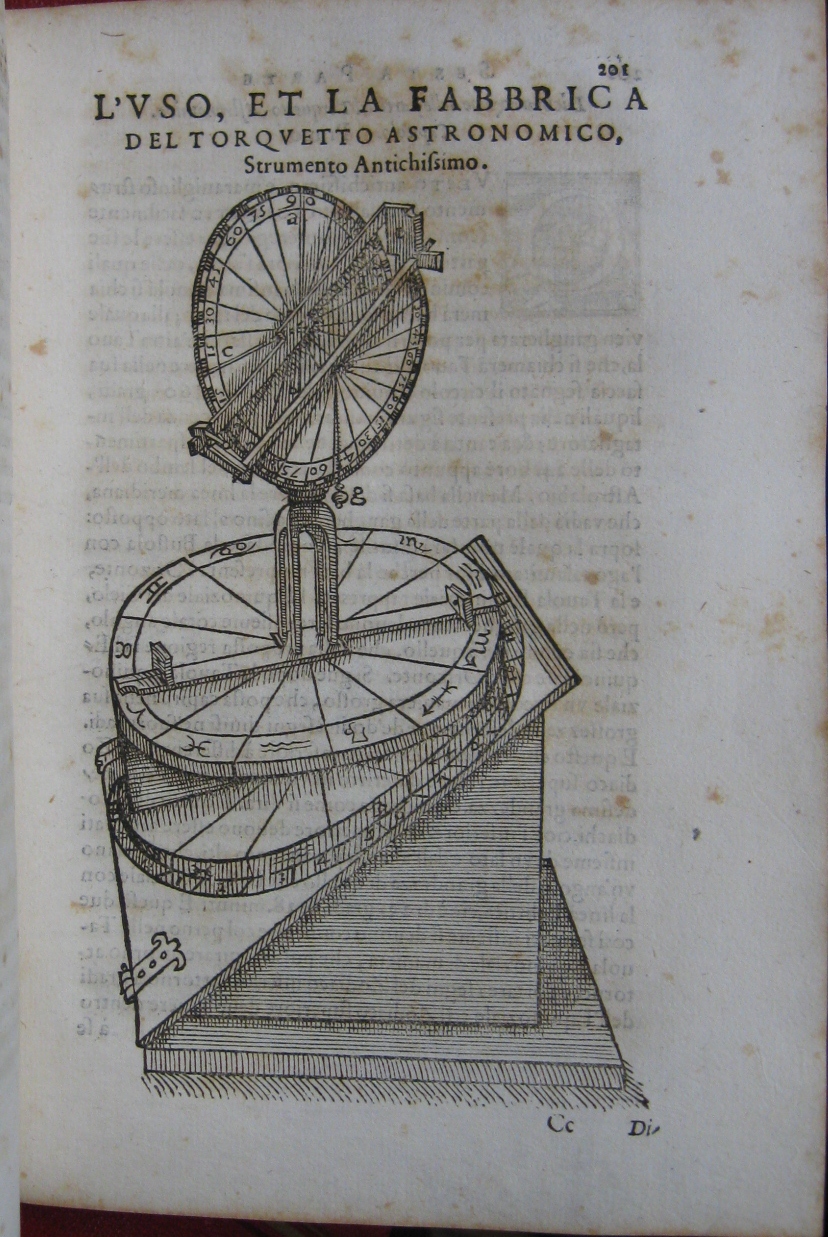
The First Important Book on the Astrolabe in the Italian Language
16. DANTI, Egnatio [1537-1586]. Primo Volume Dell’Uso Et Fabbrica Dell’Astrolabio, Et del Planisferio…Nuovamente ristampato, & accresciuto in molti luoghi, Con L’Aggiunta Dell’Uso, & Fabbrica di nove altri istromenti Astronomici… [All Published]. small 4to. pp. 8 p.l., 325, [1]errata, [1 leaf]colophon. numerous woodcut text illus. (some full-page). woodcut initials. woodcut arms on title & woodcut printer’s device at end. contemporary vellum (large patch on rear cover, ties defective, some light spotting). Florence: Giunta, 1578. $6,500
Second and Best Edition, Greatly Enlarged (first: 1569) of the first important book on the astrolabe in the Italian language. The author was mathematician, astronomer, and cosmographer to Cosimo I de’ Medici until the latter’s death in 1574. In 1580 he was called to Rome by Pope Gregory XIII to work on reforming the calendar. His major works included the construction of an astronomical quadrant and an equinoctial armillary on the façade of the church of Santa Maria Novella in Florence, a large gnomon in the church of San Petronio in Bologna, and a meridian inside the Torre de’ Veneti at the Vatican.
Newly added in this edition are descriptions of nine other astronomical instruments, all illustrated with woodcuts, including the armillary sphere of Ptolemy, the diptric of Hipparchus, the astronomical gnomon, and the vertical anemoscope, an instrument for showing the direction of the wind. Danti also gives an account of how he was able to observe the vernal equinox of 1574 using the equinoctial armillary which he constructed on the façade of the church of Santa Maria Novella, thereby correcting the discrepancy between the length of the year according to the Julian calendar and the true course of the sun.
Adams D124. BM STC Italian p. 210. Houzeau & Lancaster 3288. Riccardi I 389. cfPettas p. 249.
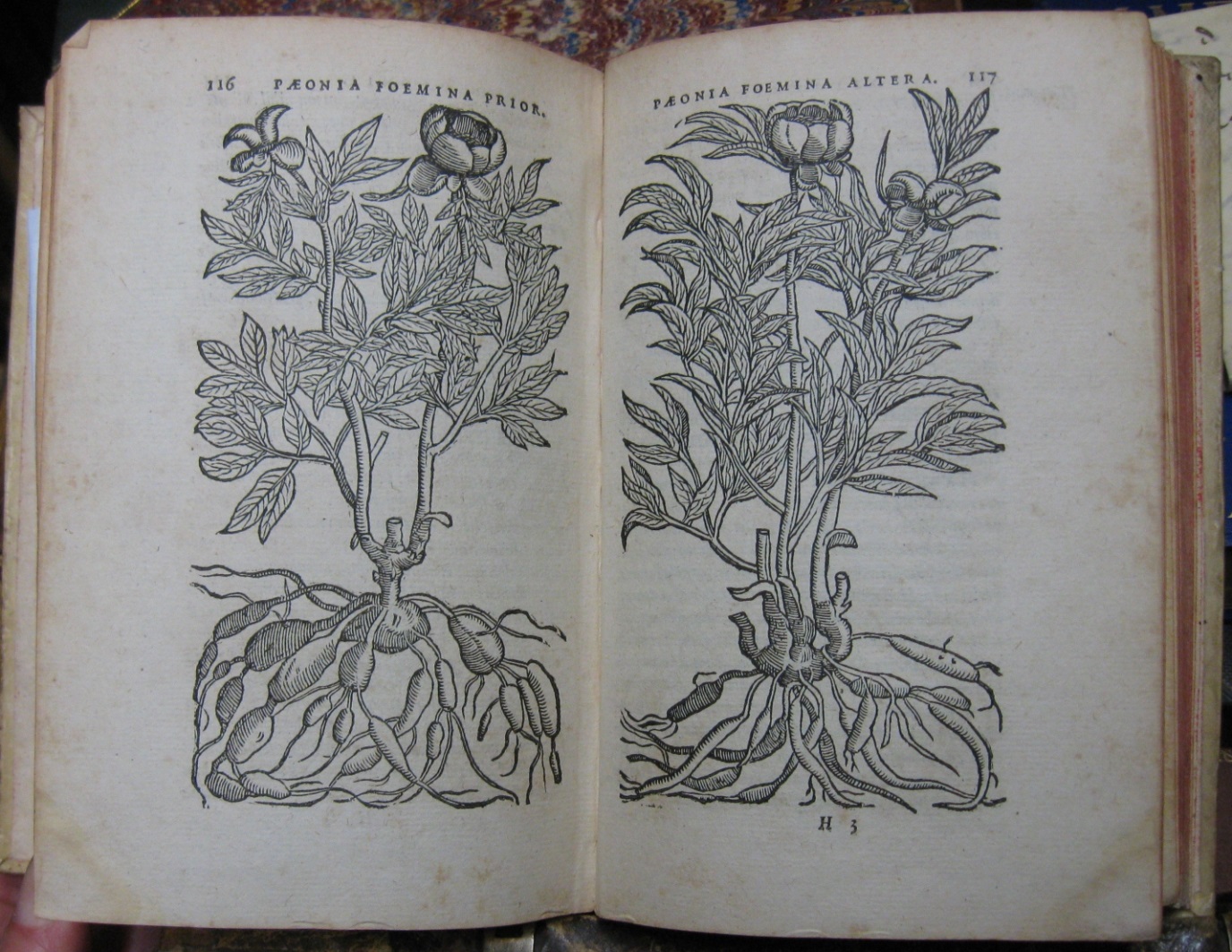
The First of the Great Flemish Botanists
17. DODOENS, Rembert [1516-1585]. Purgantium Aliarumque Eo Facientium, Tum Et Radicum, Convolvulorum ac deleteriarum herbarum historiae Libri IIII. 8vo. pp. 505, [6]. 221 full-page woodcuts in the text. woodcut printer’s device on title & appendix title.woodcut initials.later vellum (front hinge weak, significant foxing & browning throughout). Antwerp: Christophe Plantin, 1574. $8,700
[BOUND WITH:] DODOENS, Rembert. Florum, Et Coronariarum doratarumque Nonnullarum Herbarum Historia…Altera Editio. 8vo. pp. 309, [8]. 109 full-page woodcuts in the text. woodcut printer’s device. woodcut ornaments. (some foxing & browning throughout). Antwerp: Christophe Plantin, 1569.
First Edition; Second and Best Edition. The first work describes plants with purgative properties, those with medicinal roots, climbing plants, and poisonous plants. The second is devoted to plants which were considered to be remarkable for their flowers or their scent, many of them recently introduced from Asia Minor. “ Dodoens' Florum, et coronarium was devoted to those flowers, ranging from herbaceous annuals and perennials to rare bulbous plants, that were traditionally used in the sixteenth and seventeenth centuries to form garlands and wreaths, 'coronae'; in fact, a garden planted with such flowers was sometimes referred to in this period as a 'hortus coronarius'. Among the flowers he describes are the rose, violet, lily, marguerite, marigold, amaranth, iris, narcissus, anemone and carnation and sweet-smelling herbs such as thyme, marjoram, lavender and lavender cotton.” (Tomasi). The second edition also includes descriptions of the tulip, the ‘Flos africanus’ or tagetes, and the ‘Chrysanthemum perunianum’ or sunflower, native to Peru and other American regions. The majority of the woodblocks in both works were cut by Gerard Janssen van Kampen after drawings by Peeter van der Borcht. The second edition of the second work contains five new woodcuts, of which four are replacements. Notably the two books were printed by Christophe Plantin, himself an amateur botanist, from whose presses were issued some of the most important botanical texts of the sixteenth and seventeenth centuries.
Dodoens practised medicine in his native Mechelen (Malines) and then served for several years as physician to Emperor Maximilian II and Rudolph II in Vienna and Prague. On his return to Holland in 1582, he accepted the chair of medicine at the University of Leyden. The first of the great Flemish botanists, Dodoens contributed to the tremendous progress made in the field of the natural sciences in the sixteenth century, continuing the work of classification and identification begun by Brunfels, Fuchs and Bock.
Voet 1099 & 1098. Hunt 116 & 101. Nissen 515 & 514. Tomasi, An Oak Spring Flora, 39, pp. 154-58. Durling 1181 & 1175. Wellcome 1821 & 1820.
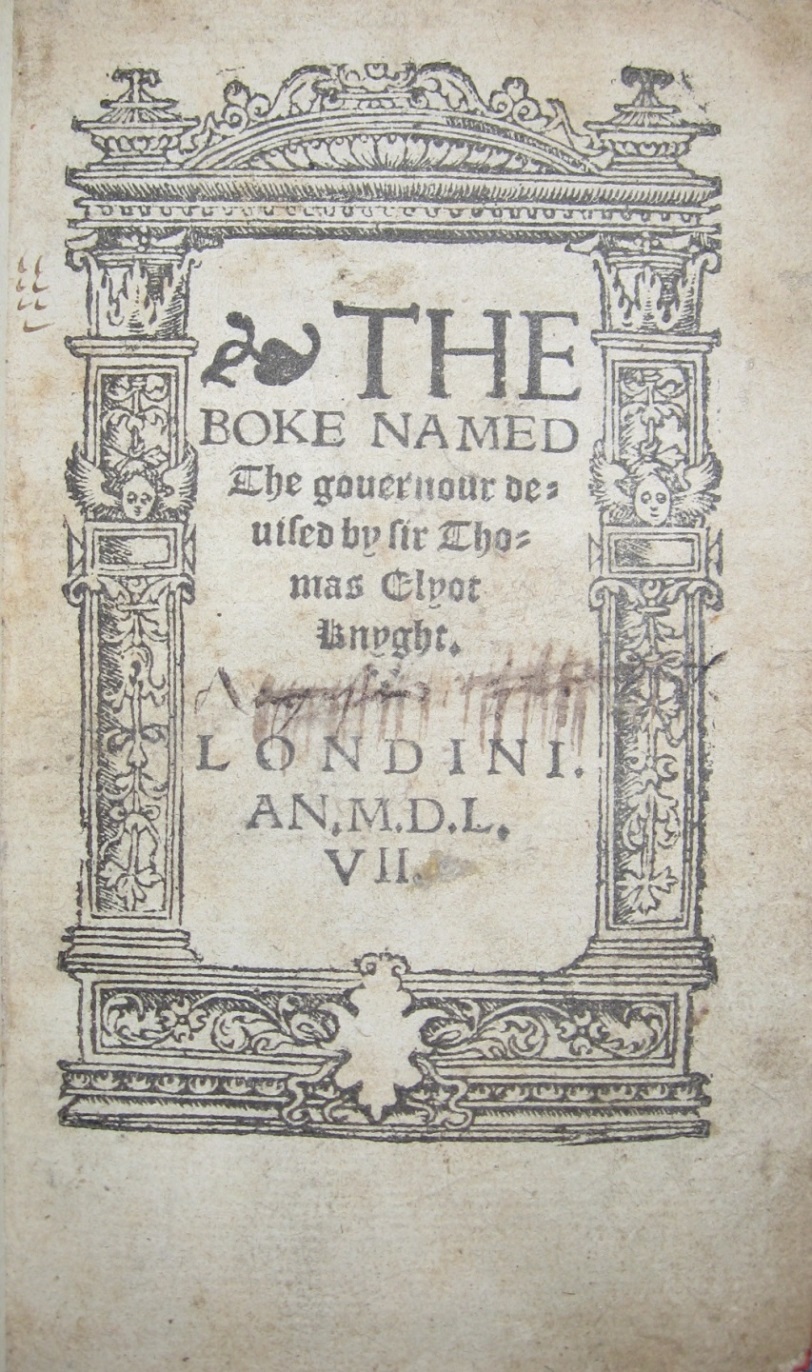
The Earliest English Treatise on Moral Philosophy in English
18. ELYOT, Sir Thomas [1490?-1546]. The Boke Named The governour. small 8vo. ff. [8], 216. title within woodcut architectural border. woodcut initials. black letter. modern half calf (occasional spotting, dampstain to lower outer corner of some leaves, title lightly soiled & with early ownership entry inked out). London: [T.Marsh], 1557. $8,500
Sixth Edition (first: 1531).The author was clerk of the Privy Council and was twice sent as ambassador to the Emperor Charles V by Henry VIII, to whom the present work is dedicated. “His most famous book…was The Boke named the Governour, which went through edition after edition all through the sixteenth century. It achieved this fame for many reasons. It is the first work in recognizably modern English prose, to which Elyot added many new words. It provided influential advocacy for the study of the classics, from which he quotes extensively. The principal cause of its popularity was the current vogue for its subject – it is a treatise on moral philosophy, laying down the lines on which the education of those destined to govern should be directed, and inculcating the high moral principles which should rule them in the performance of their duties. There was nothing very original or revolutionary in the thoughts expressed: Elyot acknowledges his debt to the Institutio Principis Christiani of Erasmus and Castiglione’s Il Cortegiano, though not that to Francesco Patrizzi, Bishop of Gaeta at the end of the fifteenth century, whose De Rego et Regis Institutione was certainly the model for The Governour. Nevertheless it remained a textbook for behaviour for generations and had a lasting effect on the writing of English.” (PMM)
“This book is not only the earliest treatise on moral philosophy in English but the first of an imposing array which introduced into England the cultural and political ideals of the Renaissance.” (Pforzheimer)
STC 7640. cfPrinting and the Mind of Man 61. cfGrolier, Langland to Wither, 94. cfPforzheimer 354.
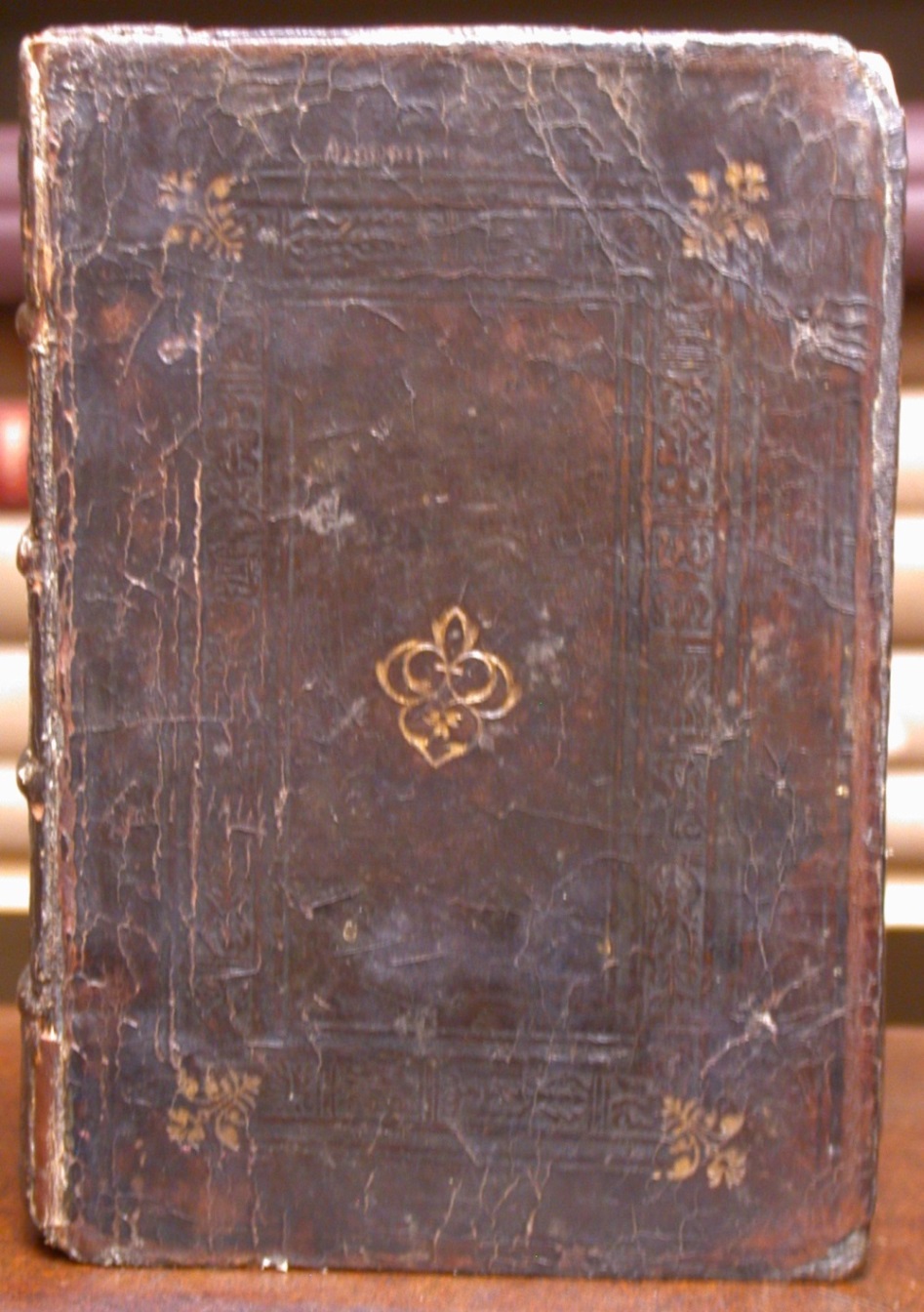
Source for Popular English Proverbs
19. ERASMUS, [Desiderius] [1466?-1536]. Apophthegmes, that is to saie, prompte, quicke, wittie and sentencious saiyings, of certain Emperours, Kynges, Capitaines, Philosophers and Orators, as well Grekes, as Romaines…translated into Englyshe by Nicolas Udall. small 8vo. ff. [20], 345, [12]. first 2 leaves (title & first leaf of Udall’s address to the reader) in good quality facsimile. woodcut printer’s device on title – a different one at end. woodcut initials. black letter, with some italic & Greek. A very good copy in contemporary blind & gilt-stamped paneled calf, rebacked with spine mounted (corners worn, occasional light soiling or marginal dampstains). bookplate of Sir Thomas Brooke. [London]: Richard Grafton, [September] 1542. $15,000
First Edition of the English Translation by dismissed Eton schoolmaster, playwright and scholar, Nicholas Udall [1505-1556], author of the earliest extant English comedy, Ralph Roister Doister (1552).The translation is of books three and four (of eight), and includes famous sayings attributed to Socrates, Aristippus, Diogenes, Philippus, Alexander the Great, Antigonus, Augustus Caesar, Julius Caesar, Pompey the Great, Phocion, Cicero, and Demosthenes. Many phrases that became popular English proverbs find their source here: “to call a spade a spade”, “he who fights and runs away may live to fight another day”, “to have well begun is a thing half done”, &c.
STC 10443. cfGrolier, Langland to Wither, 252 (2nd Edn., 1564).
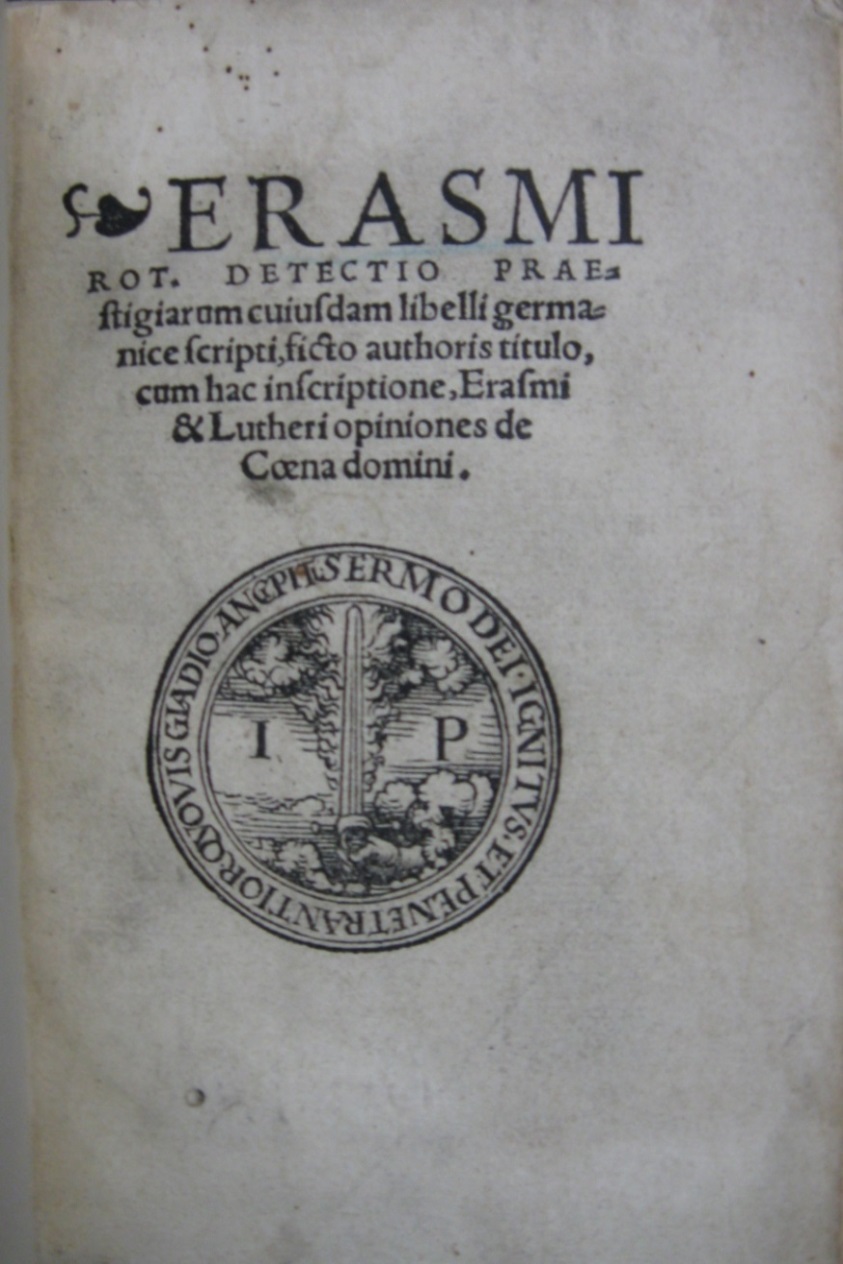
20. ERASMUS, [Desiderius] [1466?-1536]. Detectio Praestigiarum cuiusdam libelli germanice scripti, ficto authoris titulo, cum hic inscriptione, Erasmi & Lutheri opiniones de Coena domini. small 8vo. [ff. 32]incl final blank. woodcut device on title. A very nice copy, recently bound in old vellum (small wormhole in lower blank margin). [Nuremberg: Joannes Petreius, June 1526. $2,500
First Edition. Rare. An angry response to an anonymously published German pamphlet by Swiss Reformer Leo Jud, in which Jud expressed his concern for religious lay education and juxtaposed the eucharistic views of Erasmus and Luther.
Adams E624.BM STC German p. 281. Vander Haeghen p. 74.
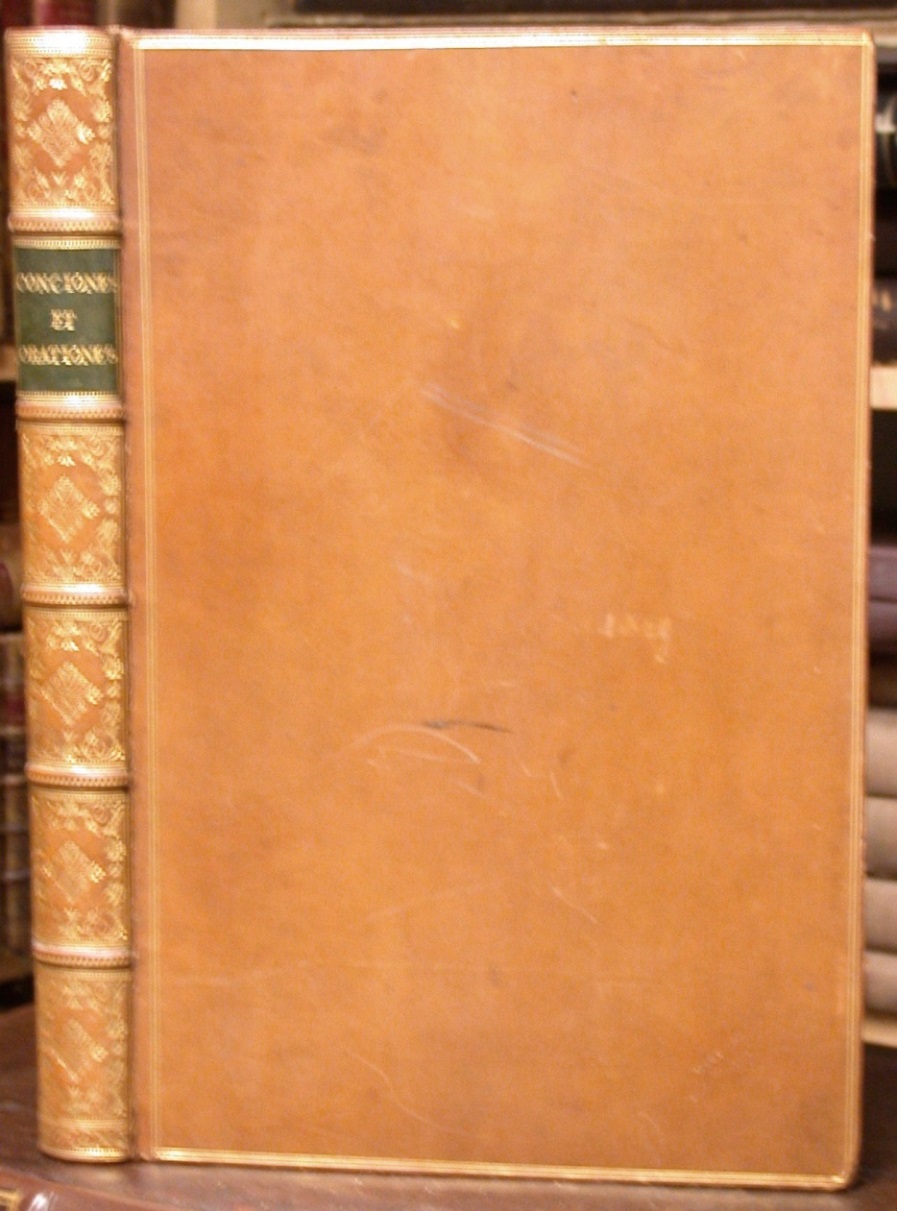
21. ESTIENNE, Henri [1531-1598]. Conciones Sive Orationes Ex Graecis Latinisque historicis excerptae… 2 Parts in 1. folio. pp. 10 p.l., 278 [i.e. 292], [4]index; 194. without the final blank. greek & roman letter. Estienne’s woodcut device on title. woodcut initials. A very good copy in 19th century calf, gilt back (light dampstaining in upper margin through second half). double slipcase. from the library of English deist, Edward Herbert, first Baron Herbert of Cherbury [1583-1648], with his cypher & price notation on title. armorial bookplate of Edward Herbert, Viscount Clive [1785-1848]. [Geneva]: Henri Estienne, 1570. $2,000
First Edition, First Issue, with p. ‘288’ incorrectly numbered ‘278’. “Henri Estienne published this collection of the speeches and exhortations found in the Greek and Roman historians, for the use of politicians, lawyers, and all those who had a need of the art of persuasion. The Greek texts are accompanied by Latin translations (the majority by Estienne himself, others by Valla, Iobus Veratius, Politianus, et al.). The Greek historians include Herodotus, Thucydides, Xenophon, Polybius, Arrian, and Herodian; among the Roman historians are Sallust, Livy, Tacitus, Quintus Curtius, and Ammianus Marcellinus.” (Schreiber)
Adams C2486. Brunet II 212. Renouard pp. 133-34, no. 3. Schreiber 176.
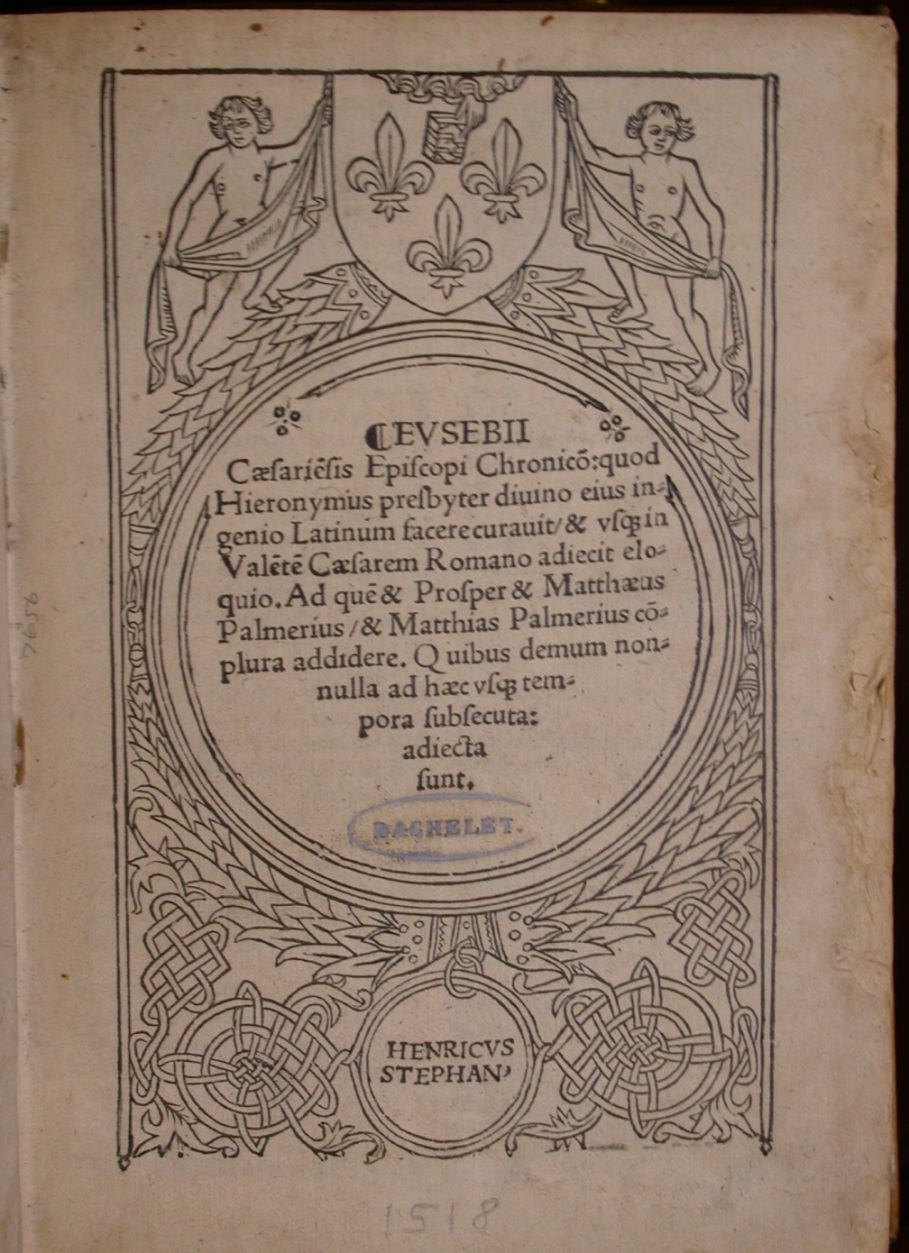
22. EUSEBIUS [PAMPHILI], Bishop of Caesarea] [266-340]. Chronicon quod Hieronymius presbyter divino eius ingenio Latinum facere curavit… 4to. ff. [20], 175 [i.e. 173]. lacking final blank. title within woodcut border with arms of the University of Paris & 2 putti at head & Estienne’s name set in type in a circle at the foot. criblé initials in 3 sizes. printed in red & black throughout except for title & index. old vellum (fore-margin of first few leaves frayed, outer margins in last 3 gatherings cropped with some text shaved on last 6 leaves). [Paris]: Henri Estienne], 30 October 1518. $2,500
Second Estienne Edition (first: 1512) of St. Jerome’s Latin version of Eusebius’s chronicle (extended to 381), with the continuations of Prosper of Aquitaine (to 448), Matteo Palmieri (to 1449), Mattia Palmieri (to 1481), and Joannes Multivallis (to 1512). Of special interest are the reference to the invention of printing by Gutenberg under the year 1457 and a passage relating to America on folio 172v under the year 1509. This latter is generally agreed to be the earliest printed reference to Canadian aboriginals, describing the arrival in Rouen of seven savages from “that island which is called Terra Nova’ (probably Micmacs or Beothuks brought back from his 1508 voyage to the New world by Thomas Albert, the Dieppe pilot. The event is visually recorded in a work in bas-relief which is still preserved in the church of St. James in Dieppe. The aboriginals are vividly described as having, “hair dark and coarse like a horse’s mane; no beard through their whole life…not any hair on their whole body except that of the head and eyebrows…their boat is of bark and one man can carry it on his shoulders.”
Adams E-1074. Renouard p. 20 no.9. Schreiber 28. Mortimer, Harvard 16th Century French, 217. Alden 518/3. JCB I 69-70. BM STC 158. cfSabin 23114.
23. FABRICIUS (or GOLDSCHMIDT), Georg [1516-1571]. Roma…Liber unus… 2 Parts in 1 with separate titles. 8vo. pp. 188, [4]incl final blank; 90, [30index. woodcut initials. 17th century vellum (title backed repairing 2 marginal holes resulting from erasures, light dampstaining in first gatherings, some light foxing & a few underlines). [Colophon on m7r:] Basel: Joannes Oporinus, March 1551. $1,500
First Edition (?) of this important early guide to the antiquities of the city of Rome by the Protestant German poet, historian, and archaeologist from Chemnitz. Although possibly preceded by an undated edition believed to have been published in 1550 it is the earliest edition listed in the bibliographies.
Adams F94. BM STC German p. 296. Graesse II 543.
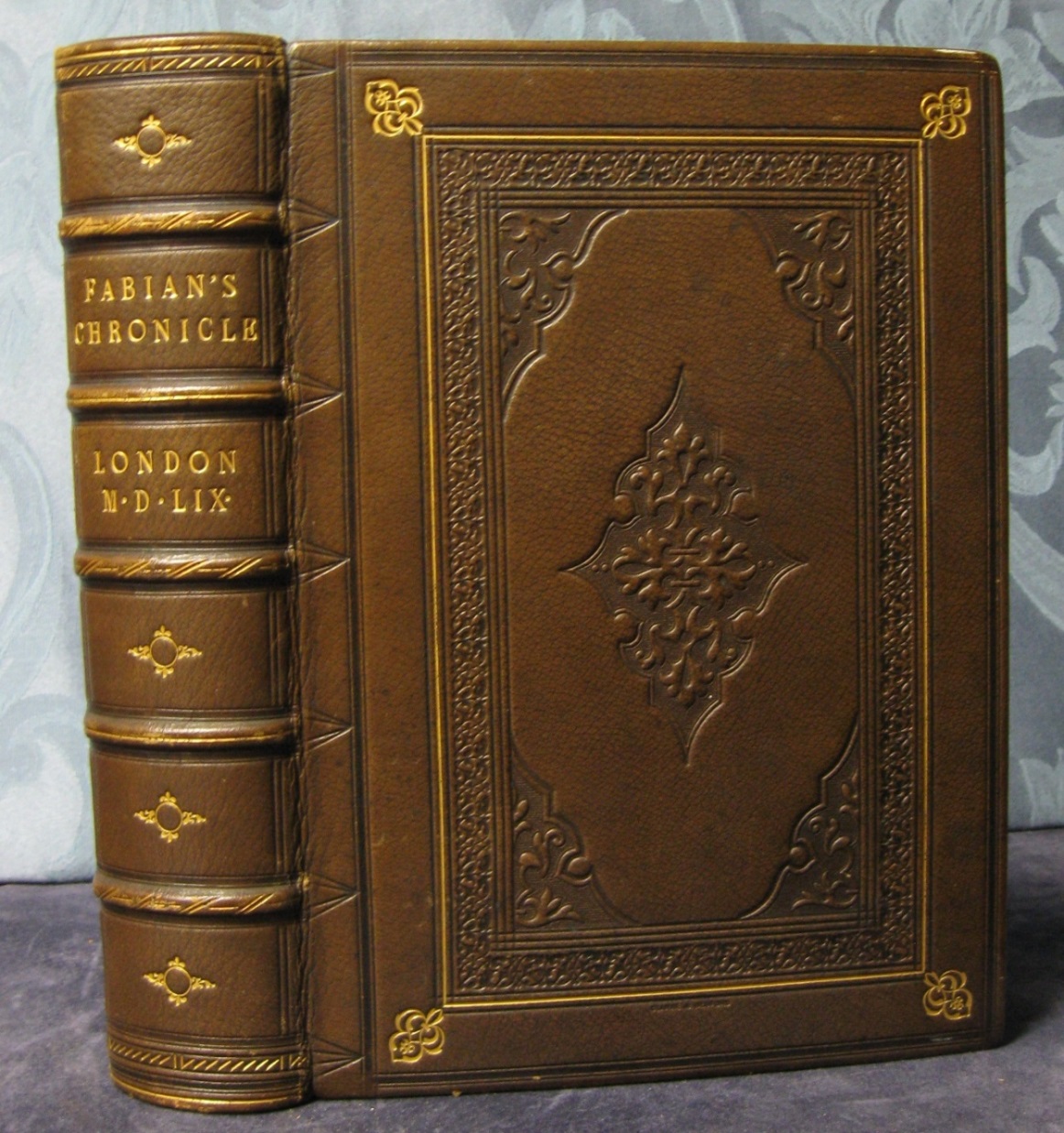
24. FABYAN, Robert [d. 1513]. The Chronicle of Fabian, whiche he nameth the concordaunce of histories, newly perused. And continued from the beginnyng of Kyng Henry the seventh, to the ende of Queen Mary. […The seconde volume…conteinyng the Chronicles of Englande & of Fraunce from the beginning of the reigne of king Richard the firste, until the eande of the reigne of Charles the nineth.]. 2 Volumes in 1. folio. pp. 12 p.l., 369; 1 p.l., 571. titles within woodcut border (McKerrow & Ferguson 67). woodcut initials. black letter. double columns. A fine lightly washed copy in antique-style blind & gilt-tooled paneled morocco, gilt edges, by Clarke & Bedford (light rubbing to lower edge of covers, a few neat repairs). London: Jhon Kyngston, April, 1559 $12,000
Fourth and Best Edition of this famous chronicle, the second issue, with continuation bringing the history forward to May 8, 1559. While the earlier portion of the chronicle, up until the Norman Conquest, is a rather uncritical compilation based on the works of other historians, for the period covered by Fabyan’s lifetime it is a valuable authority. Beginning with the accession of Richard I, the work assumes the form of a London chronicle, with the years divided by the names of the mayors and sheriffs. Fabyan was a member of the Drapers’ Company, and at one time a sheriff in London, and his chronicle contains much detail regarding public events and celebrations. His work was an important source for Shakespeare’s plays.
The very rare first edition of 1516, which ends with the reign of Richard the Third, is said to have been ordered to be burned by Cardinal Wolsey because it contained critical remarks on the worldliness of the clergy. The second edition, 1533, printed by Rastell, incorporated an autobiographical note and some religious verses, as well as a continuation to 1509, which is presumed to be Fabyan’s work. A third, revised and expurgated edition, was published in 1542. To this fourth edition has been added a further continuation to 1559 written by an unknown hand.
Brunet II 5. STC 10664. Grolier, Langland to Wither, 95. cfRead 305.
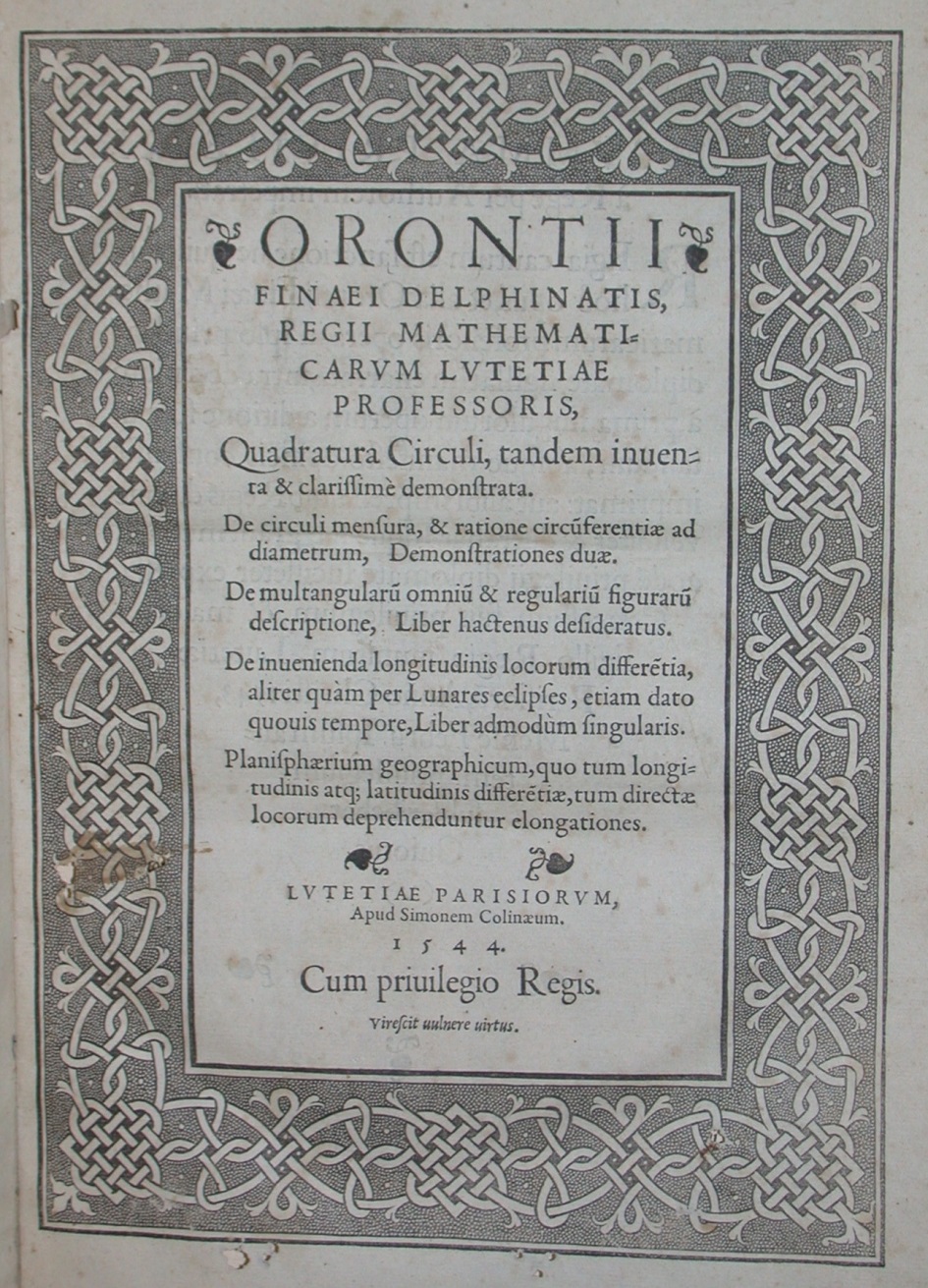
Quadrature of the Circle
25. FINÉ, Oronce [1494-1555]. Quadratura Circuli... folio. pp. 6 p.l., 107. criblé title border of strapwork ornament & 42 woodcut text illus. & diagrams decorated with florets. criblé initials & headpieces. modern decorated bds. (few small holes in title & last leaf, some light foxing, but a crisp copy with good margins). the Philip Hofer-Harvard Library copy (discreet release stamp on Hofer's book label). Paris: Simon de Colines, 1544. $6,500
First Edition of this collection of writings by French mathematician, astronomer, and cosmographer, Oronce Finé, regius professor of mathematics at the Collège Royal. The essays deal respectively with Finé's attempt to compute the ratio of circumference to diameter and solve the quadrature of the circle, with the measurement of longitude, and with the astrolabe.
The splendid title border, woodcut text illustrations, dedication headpiece, and criblé initial were probably all designed by Finé, the other Colines initials being attributed to Geoffroy Tory. Several of the illustrations depict scientific instruments (the 'triquetrum' and astrolabe) and their use. For a discussion of Finé's contribution to book design and examples of his work, see Mortimer, 225. and following: "[Finé's] work as a designer is closely related to his major fields of mathematics, astronomy, and geography, and his contribution is particularly interesting in extending beyond the illustration to the ornamentation of scientific texts."
Adams F479. BM STC French p. 166. Gallois, Finé, pp. 76-77. Johnson, Finé, p. 109. Mortimer, Harvard French 16th Century Books, 229 (this copy). Morrison, Four Centuries of Fine Printing, p. 126. Renouard, Colines, pp. 393-95.
26. [FLEETWOOD, William] [1535?-1594].Annalium tam Regum Edwardi quinti, Richardi tertii, & Henrici septimi, quàm Henrici octavi Titulorum Ordine Alphabetico digestorum, Elenchus. small 8vo. unpaginated. black letter. contemporary calf (worn but solid, head of spine damaged). London: Richard Tottel, 1579. $850
First Edition. Index to the law reports of the reigns of Edward V, Richard III, Henry VII and Henry VIII. Fleetwood, recorder of London and M.P. for the city, was famous for his vigorous enforcement of the laws against vagrants and papists.
STC 11034. Sweet & Maxwell I.311.4.
27 GIOVIO, Paolo, Bishop of Nocera [1483-1552]. Elogia virorum bellica virtute illustrium veris imaginibus supposita, quae apud Musaeum spectantur. folio. 00. 340, [3]. Torrentino’s woodcut device of the Medici arms on title. woodcut initials. 18th century calf, rebacked & repaired (covers worn, scattered foxing – generally light, dampstain to outer margin of outer leaves, repair to upper inner blank margin of first leaves). Florence: Lorenzo Torrentino, 1551. $2,000
First Edition. With corrected reading on x3v but original reading on x4v. Accounts of the lives of illustrious men, whose portraits Giovio maintained in his private collection at his villa at Lake Como, including Christopher Columbus and Hernando Cortés as well as Alexander the Great, Attila the Hun, Cesare Borgia, Emperor Charles V, Cosimo de’ Medici, Elizabeth of Aragon, Francisco Gonzaga, Henry VIII of England, Louis XII of France, Mahomet II of Turkey, Matthias Corvinus of Hungary, King Robert of Naples, King Sigismund of Poland, Solyman, Emperor of the Turks, Tamerlane, &c.
Adams G639. Alden 551/23. BM STC Italian p. 304. Brunet III 584. Graesse III 490. Mortimer, Italian 16th Century Books, 213.
28. HOMER. [Greek Title] Opus Utrumque Homeri Iliados Et Odysseae, Diligenti per Iacobi Micylli & Ioachimi Camerarii recognitum. 2 Volumes in 1. folio. pp. 12 p.l., 394 [i.e. 410], [1 leaf]; 237 [i.e. 307], [1]. Greek text. woodcut printer’s device on titles & on last page of each part. woodcut initials. contemporary blind-stamped pigskin over wooden bds., brass catches & 1 (of 2) clasps (rubbed, leather missing from head of spine & top & bottom of rear bd., repair to upper front bd., some dampstaining to outer margins of last leaves, clean tear in 1 leaf – no loss, lower blank outer corner of title torn away). a few old marginal ms. notes. ownership entry of Baltasar Stangius, 1684. [Basel: Johann Herwagen, 1541]. $4,000
Second Herwagen Edition of Homer in the original Greek, being the second recension by Joachim Camerarius [1500-1574]. The text is greatly improved over the first of 1535 and Camerarius was aided in editing by Jacob Micyllis [Jakob Moltzer] [1503-1558]. This edition also contains the ancient scholia of Didymus and the important Homeric criticism and allegorical readings of Porphyry.
Adams H750. BM STC German p. 412. Brunet III 270. Dibdin (4th Edn.) II p. 47. Graesse III 327. Moss I p. 484.
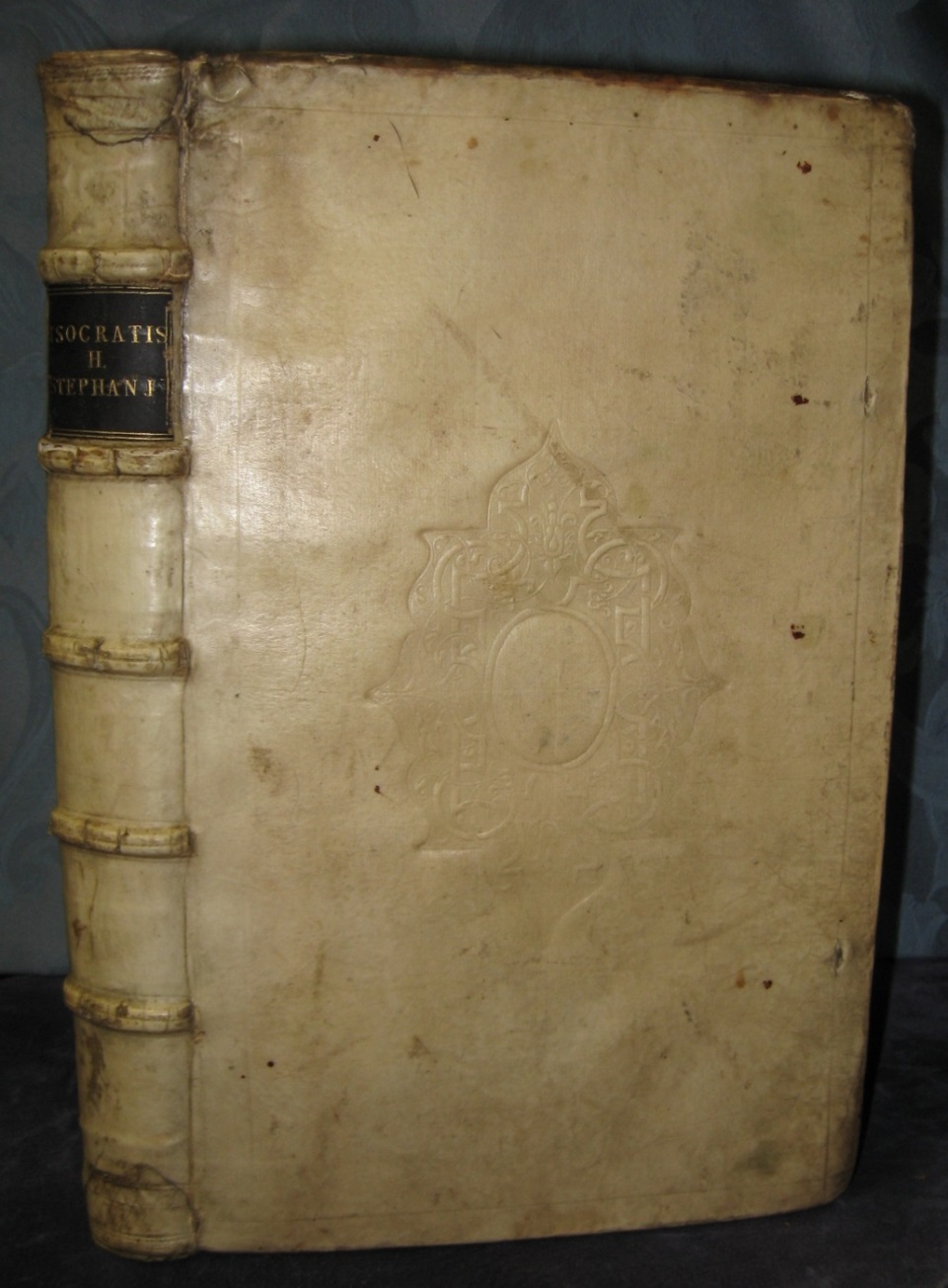
Henri Estienne’s Last Major Work
29. ISOCRATES. [Greek Title]…Orationes et Epistolae Cum Latina Interpretatione Hier. Wolfii, ab ipso postremum recognita. Henr. Steph. In Isocratem Diatriba VII: quarum una observationes Harpocrationis in eundem examinat. Gorgiae Et Aristidis quaedam, eiusdem cum Isocraticis argumenti. Guil. Cantero interprete. folio. pp. 14 p.l., 427, 131, xxxiiii, [blank leaf], [8], 31, [18]index. Greek & Latin text in parallel columns. woodcut printer’s device on title. woodcut ornaments & initials. contemporary vellum, large blind-stamped arabesque ornament on centre covers (head & foot of spine & upper front joint neatly repaired, staining to lower rear cover, upper edge of rear cover worn). [Paris]: Henri Estienne, 1593. $2,500
First Estienne Edition. “This important edition of the great Athenian orator Isocrates (436-338 B.C.), with Hieronymus Wolf’s text revised by Estienne, who has contributed 7 useful Diatribae, or Dissertations, represents Henri’s last major work – the Concordantiae of the following year had been compiled in great part by his father – and constitutes his last folio edition of a classical text. It is also the only book to issue from his press that year. Estienne nostalgically recalls more prosperous days in his preface, addressed to Marcus Fugger, whom he reminds of his family’s former generosity towards him.” (Schreiber)
Appended is the Greek text of the speeches of Aristides, the famous Greek rhetorician of the second century A.D., edited with parallel Latin translation by Dutch humanist Willem Canter [1542-1575].
Renouard p. 155. Schreiber 224. Hoffmann II 473. Adams I-219. Brunet III 467. Dibdin (4th Edn.) II p. 126.
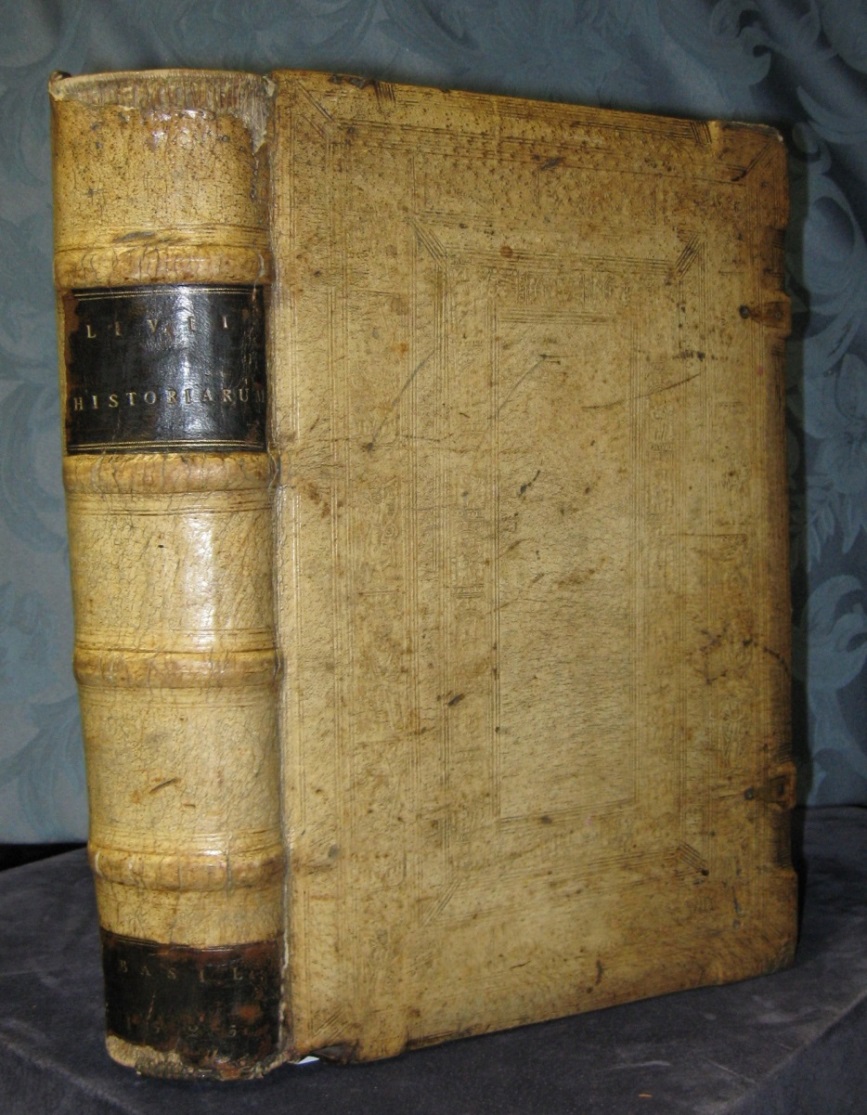
30. LIVIUS, Titus. Historiae Principis Decades Tres cum dimidia…Beati Rhenani & Sigismundi Gelenii adiunctae Annotationes. Addita est Chronologia Henrici Glareani… 7 Parts in 1. folio. pp. 69, [3 leaves]; 244; 243; 211; 91, [1]; [39]; [96]. woodcut printer’s device on first title, on title & at end of Book 5, on title & at end of the Chronologia, & at the end of the text. historiated woodcut initials. A nice copy, bound in contemporary blind-stamped pigskin, later spine labels (lacking clasps & catches, extremities worn & chipped, some light foxing & browning). Basel: In Officina Frobeniana [Hieronymus Froben & Nicolaus Episcopius], 1535. $3,500
A handsome and important folio edition, based on the Basel Froben edition of 1531, the first to incorporate the first five books of the Fifth Decade (Books 41-45), sourced from a manuscript discovered by German humanist Simon Grynaeus [1493-1541] in the Benedictine abbey of Lorsch in 1527. This edition reprints the 1531 dedicatory preface by Erasmus, and the improved chronology by Swiss humanist, Heinrich Glareanus [1488-1563], and also incorporates important new commentary and revisions by Beatus Rhenanus and Sigismund Galenius.
Adams L1330. BM STC German p. 521 (5 Parts). Graesse IV 227.
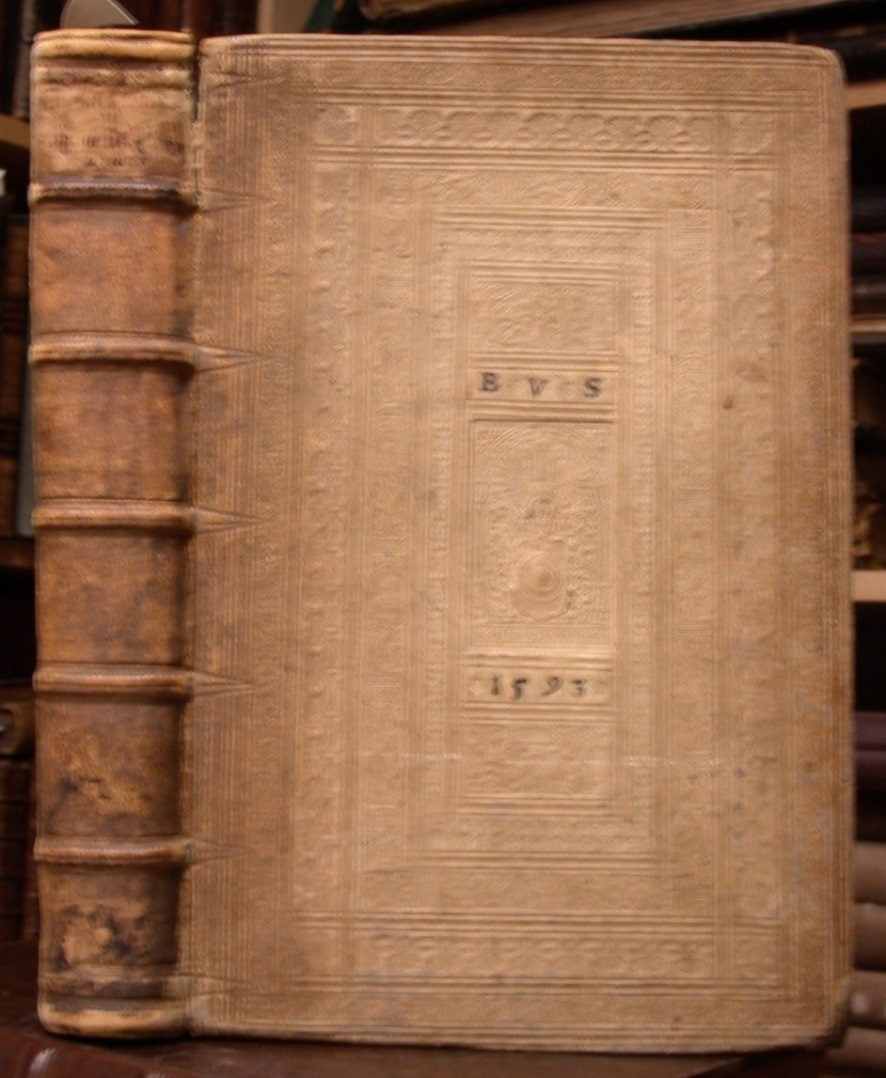
31. [MAFFEI], Raffaele [1451-1522]. Commentariorum Urbanorum Raphaelis Volaterani, Octo Et Triginta Libri...Item Oeconomicus Xenophontis, ab eodem Latio donatus. folio. pp. 30 p.l., 935, [1]. woodcut printer's device on title & on verso of last leaf. woodcut initials. several woodcut text illus. 16th century blind-stamped pigskin, the centre panel on upper cover containing arms & initials 'IWAGV', above & below the initials 'BVS' and date '1593' (corners worn, short split in upper front joint, paper faintly embrowned). ownership inscription on title & ms. notes on pp. 830-35. Basel: [Hieronymus] Froben [& Nikolaus Episcopius], 1559. $2,700
An attractive copy in dated pigskin binding of this famous Renaissance encyclopaedia of geography, anthropology, and philology by Italian humanist Raffaele Maffei. The chapter entitled Loca Nuper Reperta, describing Spanish and Portuguese voyages of discovery to the Indies, contains a reference to Columbus and the New World (p. 278). First published in 1506.
Adams M104. BM STC German p. 585. This edition not in Alden: cfAlden 530/27 (1530 Edn.). cfBell M46-48. cfHarrisse 43. cfJCB I p. 207. cfSabin 43767-68.
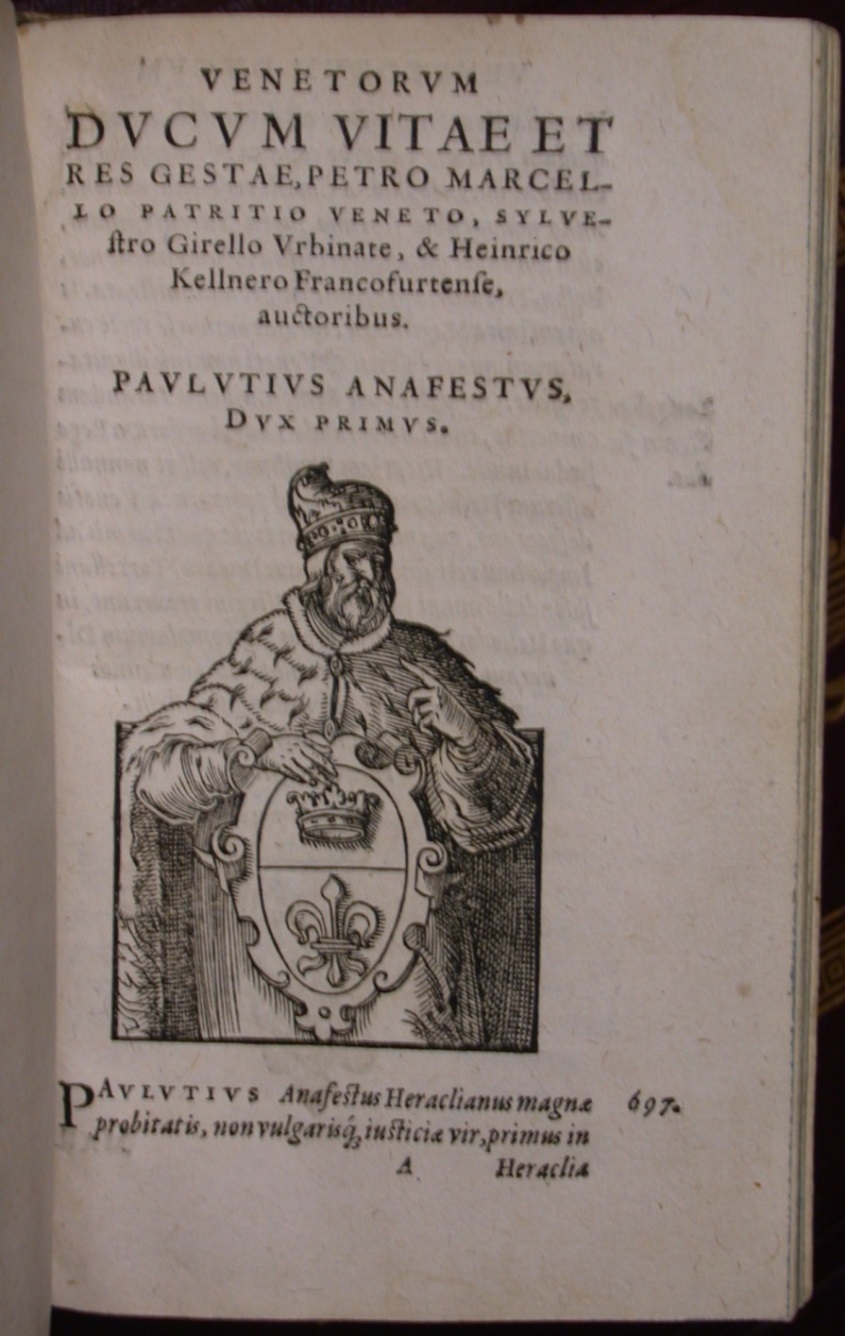
32. MARCELLO, Pietro, Silvestro GIRELLO & Heinrich KELLNER. De Vita, Moribus, Et Rebus Gestis Omnium Ducum Venetorum… 8vo. ff. [8 - the last blank], 218[i.e. 219], [1]. woodcut ornaments & initial. woodcut device on title. 83 half-page woodcut portraits of Venetian doges with their coats-of-arms & 20 half-page woodcuts of their tombs (including some repeats), all by Jost Amman. contemporary vellum (ties wanting, covers little stained, strip torn from lower blank margin of title, light dampstains to several leaves). [Frankfurt am Main: Paul Reffeler, at the expense of Sigismund Feyerabend], 1574. $4,000
First Illustrated Edition in Latin. As with the folio German translation published the same year, the text is illustrated by a series of three-quarter length woodcut portraits of the Doges and their coats of arms, and views of some of their tombs, all executed by the noted German illustrator Jost Amman. The first part of the work, beginning with a biography of Paolo Luccio Anafesto, appointed Doge in 697, and ending with that of Agostino Barbarigo, elected in 1486, was written by the Venetian nobleman, Pietro Marcello, and first published in 1502 in Venice. The second part, by Silvestro Girello, covers the years from 1501 to 1544 (Leonardo Loredan to Pietro Lando), and was first added in the edition of 1554. Heinrich Kellner, who was the editor and translator of the German edition, wrote the third part, which ends with the 84th Doge, Alvise Mocenigo, elected in 1570. Appended are verses on various events in the history of the Venetian Republic by Venetian poet Bernardo Giorgio, followed by a chronological list of the Doges.
Adams M532. BM STC German p. 593. Andresen 274n (citing incorrect date, 1573). Becker 18b. Fairfax-Murray II 284. Brunet, Suppt., I 939-40. Graesse IV 381.
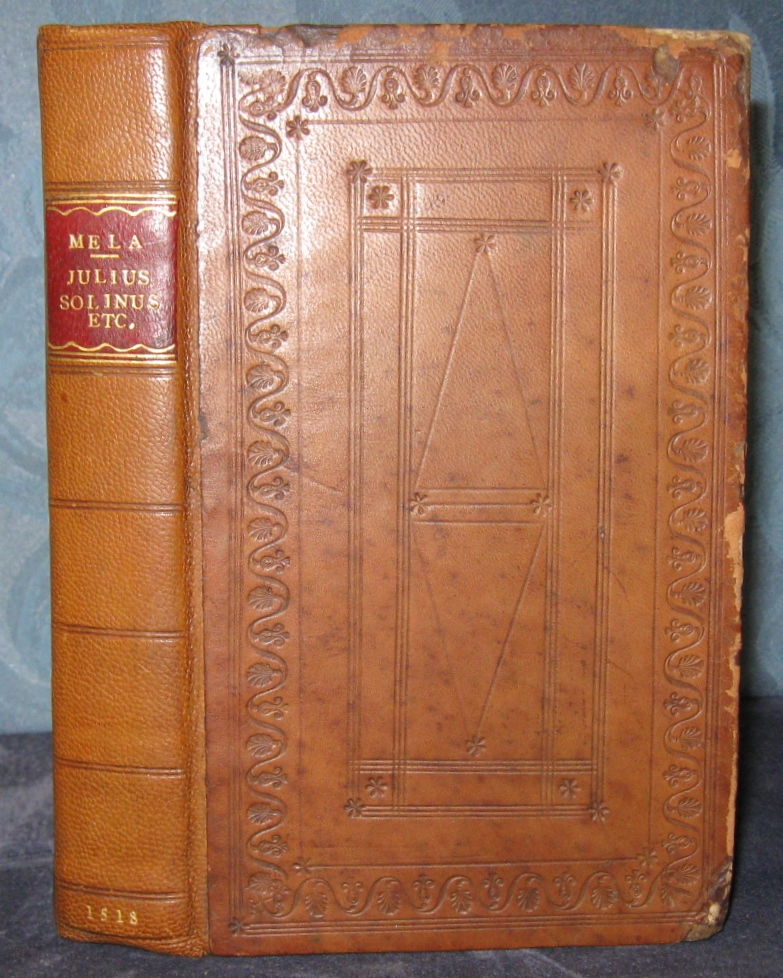
“The first extant geographical work in Latin”
33. MELA, Pomponius Et Al. Pomponius Mela. Iulius Solinus. Itinerarium Antonini Aug. Vibius Sequester. P. Victor de regionibus urbis Romae. Dionysius Afer de situ orbi, Prisciano Interpret. 8vo. ff. 233, [3]. complete with the 2 blanks, B8 & G3. Aldine woodcut device on title & verso of last leaf. Colophon on G2r: [Venice: In Aedibus Aldi, Et Andreae Soceri, October 1518]. $5,500
First Aldine Edition of this collection of ancient geographical texts. Mela’s was “the first extant geographical work in Latin and the only Roman treatise of the classical period devoted exclusively to that subject.” (DSB) His descriptive survey of the habitable world (Europe, Africa, and Asia) includes remarks on manners and customs, details on spectacular phenomena, and speculation on the causes of tides. “Despite his general inferiority as a geographer, Pomponius knew more than Strabo about the positions of Britain, Ireland, and the coasts of Gaul and north Germany; he was also the first to mention the Orkney Islands. Pomponius exerted a considerable influence on early medieval authors, both on his own account, and because Pliny used and cited his work.” (Ibid.) Solinus’s description of the classical world was based on Pliny’s Natural History and Mela’s geography. The Itinerarium compiled by Antoninus provides a brief survey of the whole of the Roman Empire. Vibius Sequester lists the names of the principal rivers, mountains, etc. known to the Romans. Victor’s work on the topography of ancient Rome, which appears here for the first time, is an important source for the identification of Roman ruins. The last text is Dionysius Afer’s treatise on cosmography.
Renouard I 198.9. Adams M1053. BM STC Italian p. 432. JCB I p. 71.
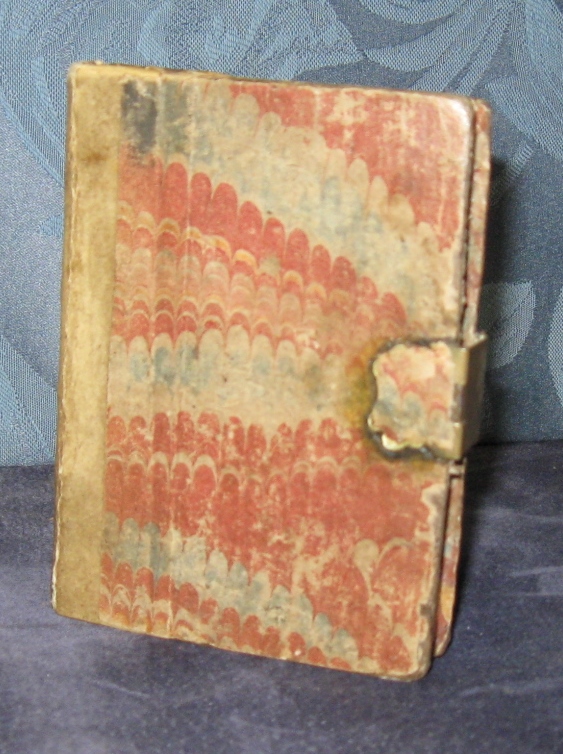
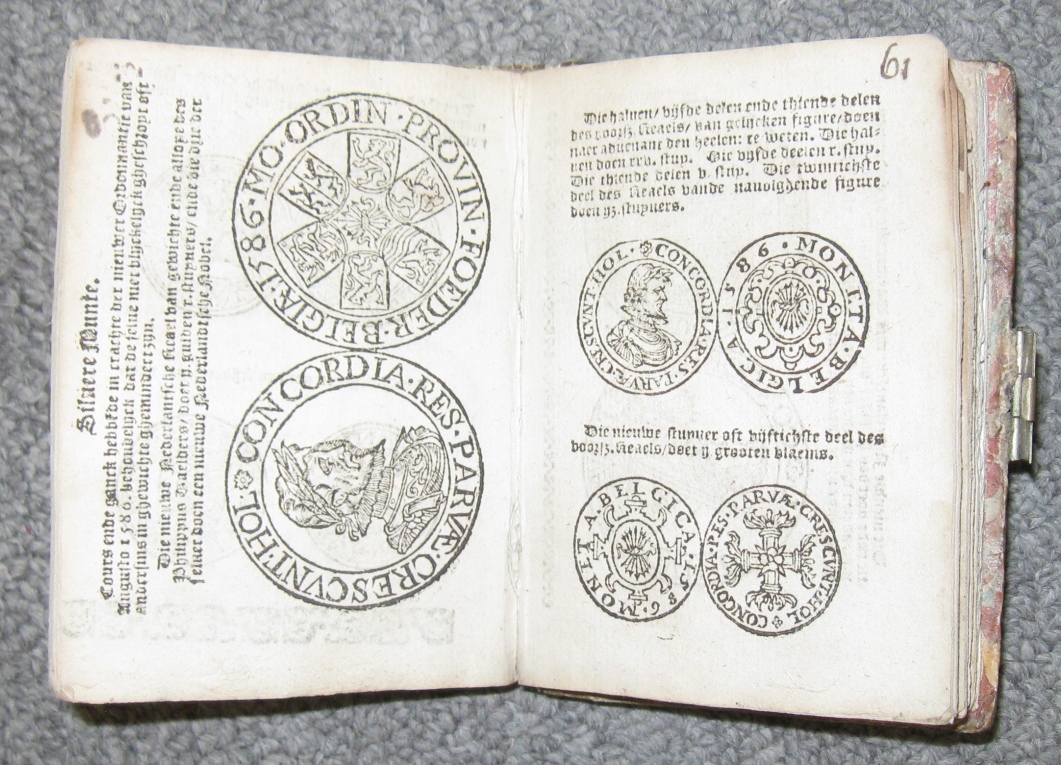
34. NETHERLANDS. UNITED PROVINCES. (DUDLEY, Robert, Earl of Leicester, Governor). Beeldenaer ofte Figuerboeck dienende op die nieuwe Ordonantie vande Munte…4 Augusti 1586… 8vo. [ff. 108]. leaves numbered incorrectly in ms. lacking final leaf (blank?). numerous woodcuts of coins throughout. 18th century quarter vellum over marbled bds., metal clasp & catch (repairs to title with loss of a few letters, wormhole in last 4 leaves affecting text & images). armorial bookplate of Maurice Edward Wingfield. ms. index on endleaves. Amsterdam: Cornelis Claesz., 1586. $1,000
Ordinance issued in 1586 under the governorship of Robert Dudley, Earl of Leicester, designating the gold and silver coins allowed in circulation in the United Netherlands and their values.
BM, STC Dutch, p. 155. Goldsmiths’ 233 (incorrect pagination).
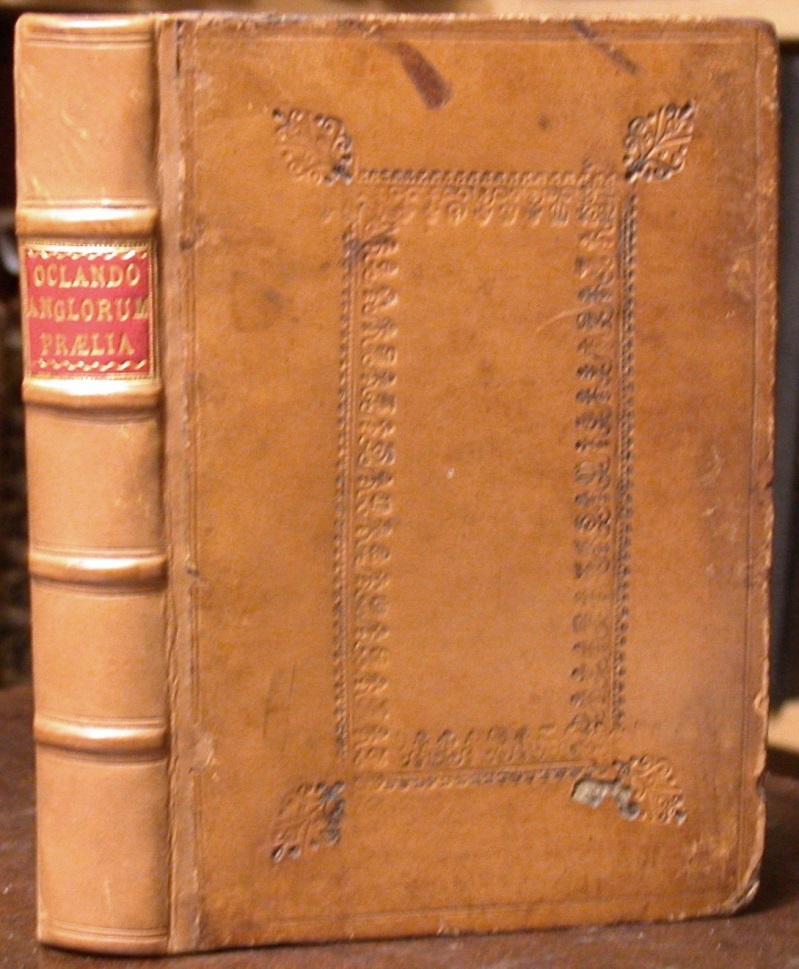
35. OCKLAND, Christopher [d. 1590?]. Anglorum Praelia ab anno Domini. 1327...usque ad annum Domini. 1558. Carmine summatim perstricta. Item. De pacatissimo Angliae statu, imperante Elizabetha, compendiosa Narratio...Haec duo Poemata...Hiis Alexandri Nevilli Kettum... 3 Parts with separate titles. 8vo. [ff. 64]; [ff. 24]incl. blank M4; pp. 8 p.l., 97, [7]. woodcut royal arms on A3v. printer's device on titles. woodcut ornaments & initials. 18th century paneled calf, rebacked (title & last leaf soiled & with small marginal tears, hole in blank M4). from the library of antiquary and book-collector Maurice Johnson [1688-1755].few old ms. notations. London: Ralph Newbery, assign of Henry Bynneman, 1582. $1,300
One of several editions dated 1582, this one distinguished by the last line on N1v beginning 'meis'. Ockland's historical poem on the battles of England, originally published in 1558, was appointed by Queen Elizabeth and her privy council to be received and taught in every grammar and free school throughout the country "for the removing of such lascivious poets as are commonly read and taught in the said...schools" (see Ames, Typographical Antiquities). Also included here are Ockland's poem, new in 1582, on Queen Elizabeth's pacification of England, and of Alexander Neville's verse-history of Kett's Rebellion.
STC 18774. NCBEL I 1131.
Early Greek Work on Fishing
36. OPPIAN. [Greek Title] De Piscatu libri V. De Venatione libri IIII. small 4to. pp. 2 p.l., 207, [7], [1 leaf]colophon. woodcut title device. woodcut headpieces & initials. text in Greek. 17th century calf, rebacked & recornered (light dampstain to upper portion of a few leaves). Paris: Adrian Turnebus, 1555. $2,400
The celebrated Greek poet, Oppian of Cilicia, flourished in the latter half of the second century, and dedicated his Fishing (in five books) to Marcus Aurelius and his son, Commodus. The didactic poem deals with the habits and characteristics of fish as well as giving instructions for fishing. While displaying considerable knowledge of natural history the work also incorporates numerous errors and absurdities. The second poem, The Chase, dedicated to Caracalla, is inferior in style and composition and may be the work of a Syrian imitator. It is divided into four books, the first dealing with the huntsman's horses and hounds, the three remaining being devoted to the hunting of wild animals, including the lion and the hare.
Adams O204. BM STC French p. 329. Westwood & Satchell p. 163.
37. PALLADIUS, Rutilius Taurus Aemilianus [fl. 4th Cent. A.D.].De Re Rustica Libri XIIII. 8vo. pp. 186, [6]. woodcut device on title. modern calf (some headlines cropped, minor marginal dampstain to a couple of leaves). Paris: Robert Estienne, 1543. $700
The third volume (of five) in Robert Estienne’s collection of the Latin writers on agriculture (Scriptores Rei Rusticae). According to Schreiber each of the five parts was originally issued separately, and it is most uncommon to find complete sets. Palladius was a specialist on agriculture and possessed estates in both Italy and Sardinia. His work, which gives detailed monthly instructions for the typical activities on an average Roman farm, was well known in the Middle Ages.
Adams P111. BM STC French p. 335. Renouard p. 55, no. 2. Schreiber 70c.
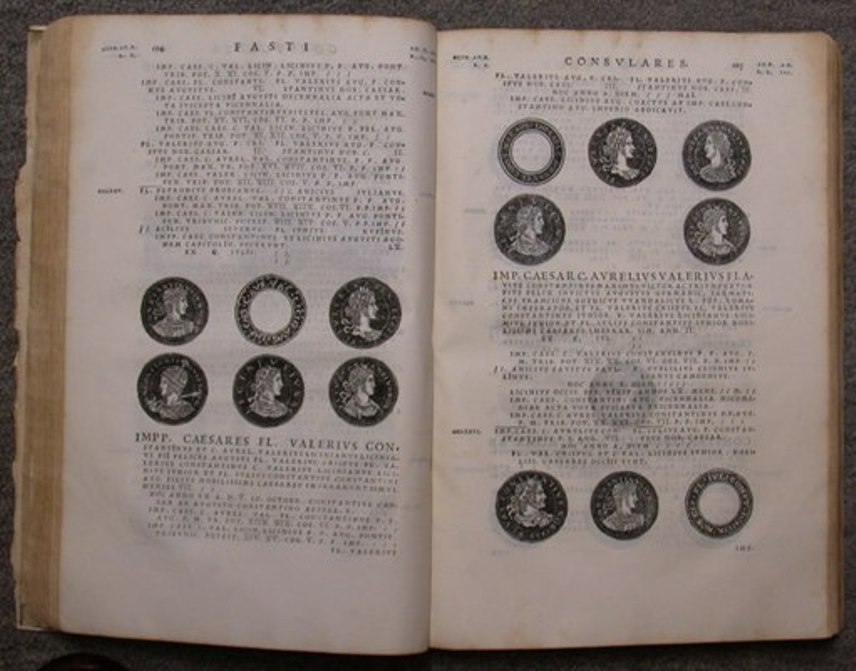
38. PANVINIO, Onofrio [1529-1568]. Fasti Et Triumphi Roma Romulo Rege Usque ad Carolum V. Caes. Aug.… folio. pp. 8 p.l., 228, [197]index. 369 medallion woodcuts (incl. repetitions) in text. large woodcut device on title. several woodcut initials. text partly printed in red. later vellum (covers lined & extended at fore-margin with vellum strips, some scattered foxing, marginal dampstains to outer leaves, tears in 2 leaves of index with small piece missing in 1 resulting in slight loss of text on 9 lines of 1 column on recto & several letters on verso). Venice: Jacobus de Strada, 1557. $1,500
First Edition, Second Issue. Dedicated by Strada to Maximilian, King of Bohemia, later Emperor Maximilian II. Mortimer notes that the medallion woodcuts (white on black ground) representing ancient coins and medals were selected from the set of blocks cut for de Tournes’s Lyons edition of Strada’s 1533 Epitome.Author Panvinio, an eminent Italian antiquary and historian, and voracious collector of inscriptions and medals, was patronized by Cardinal Farnese.
Adams P195. Mortimer, 16thC Italian, 355. Graesse V 123. cfBM STC Italian p. 88.
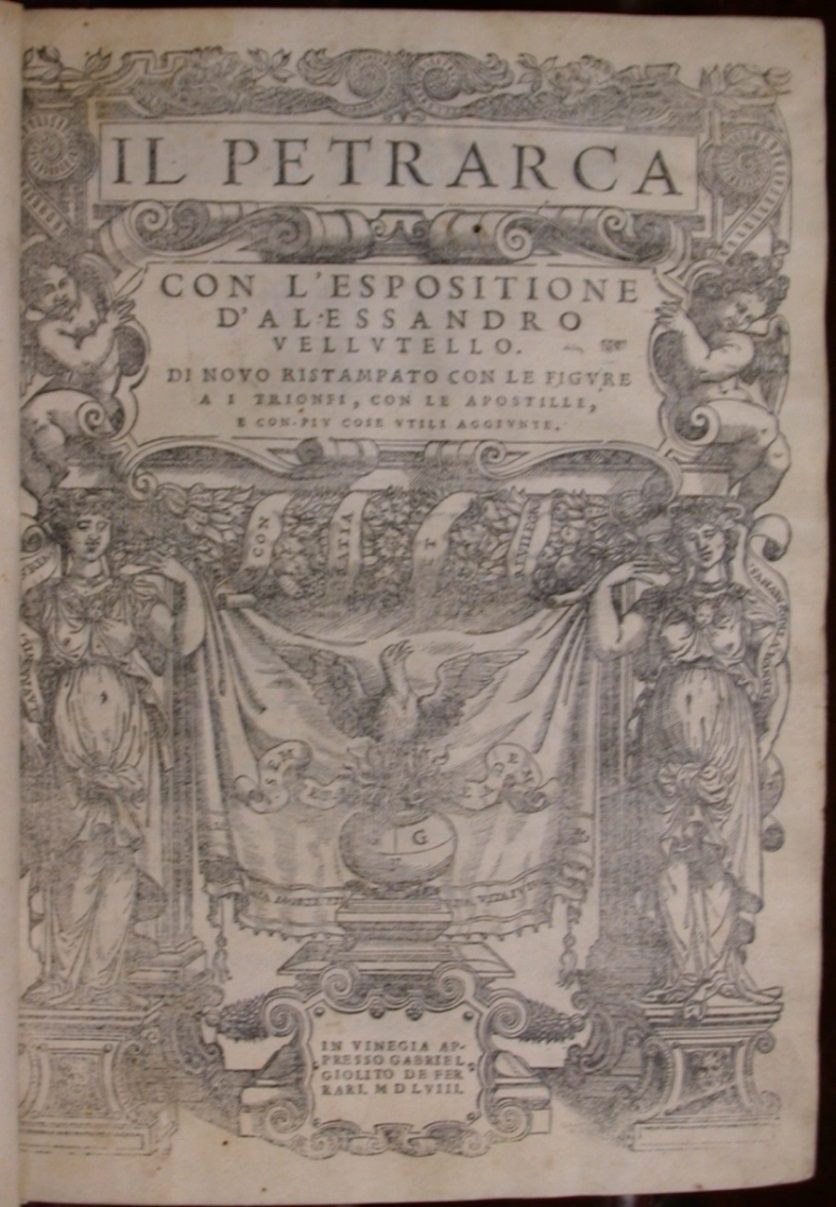
39. PETRARCA, [Francesco] [1304-1374]. Il Petrarca Con L’Espositione D’Alessandro Vellutello… 4to. ff. [12], 216. several text woodcuts incl. full-page map & double portrait of Petrarca & Laura. woodcut architectural border on title with printer’s device. woodcut printer’s device at end. woodcut ornaments & historiated initials. 19th century calf, rebacked (corners repaired with cloth tape, light dampstaining in outer gatherings, repair to inner blank margin of final leaf, few passages on pp. 142-43 crossed out). a few old ms. notes in margins. Venice: Gabriel Giolito De Ferrari, 1558 [colophon: 1560]. $850
The first Giolito edition with these particular woodcuts appeared in 1544 (colophon dated 1543). “When we attempt to estimate Petrarch’s position in the history of modern culture, the first thing which strikes us is that he was even less eminent as an Italian poet than as the founder of Humanism, the inaugurator of the Renaissance in Italy. What he achieved for the modern world was not merely to bequeath to his Italian imitators masterpieces of lyrical art unrivalled for perfection of workmanship, but also and far more, to open out for Europe a new sphere of mental activity. Standing within the threshold of the middle ages, he surveyed the kingdom of the modern spirit, and, by his own inexhaustible industry in the field of scholarship and study, he determined what we call the revival of learning...”. (Encyc. Britan., 11th Edn.)
Adams P823. BM STC Italian p. 505. Brunet IV 551. cfEssling I 105. cfMortimer, 16th Century Italian, 375.
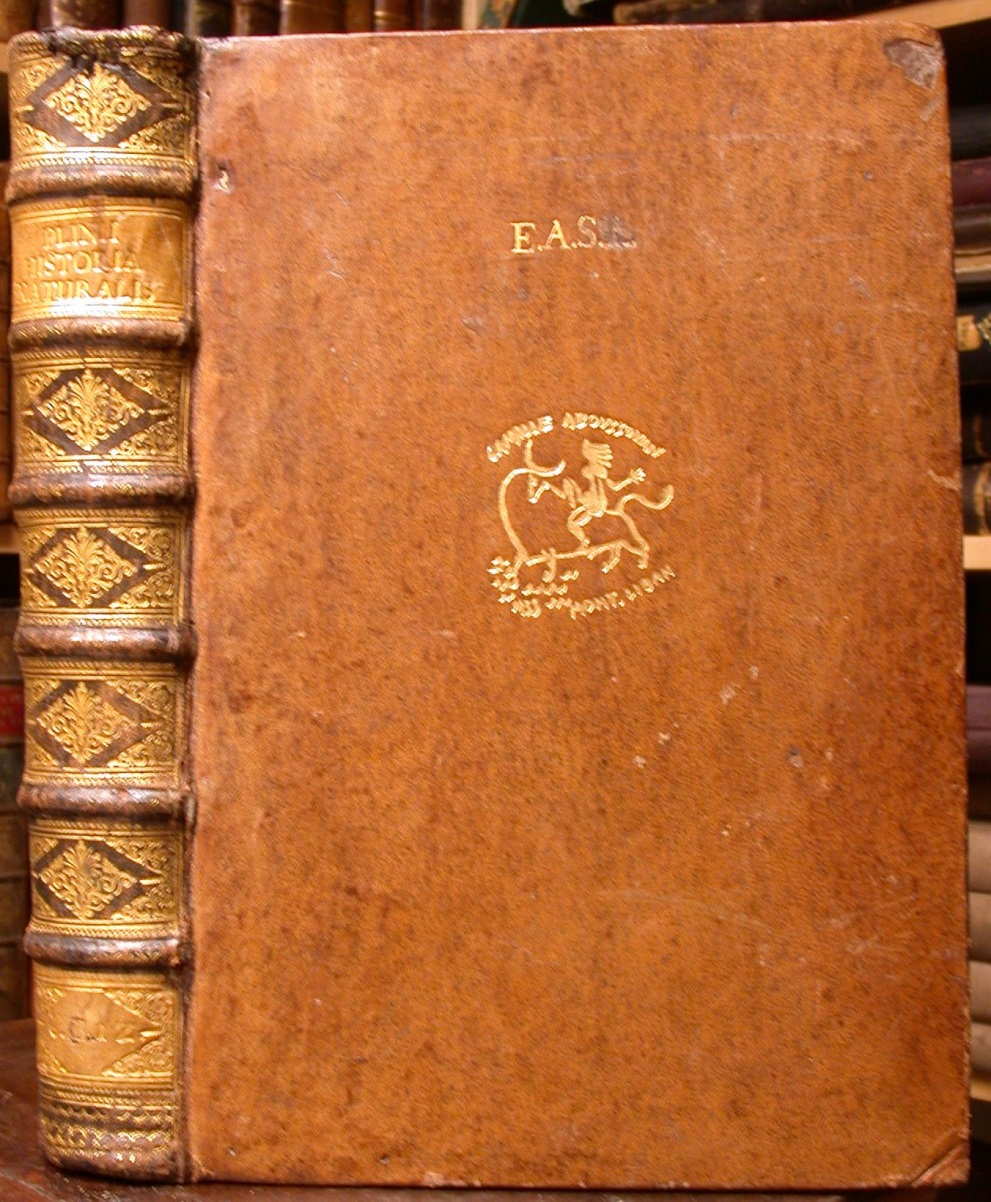
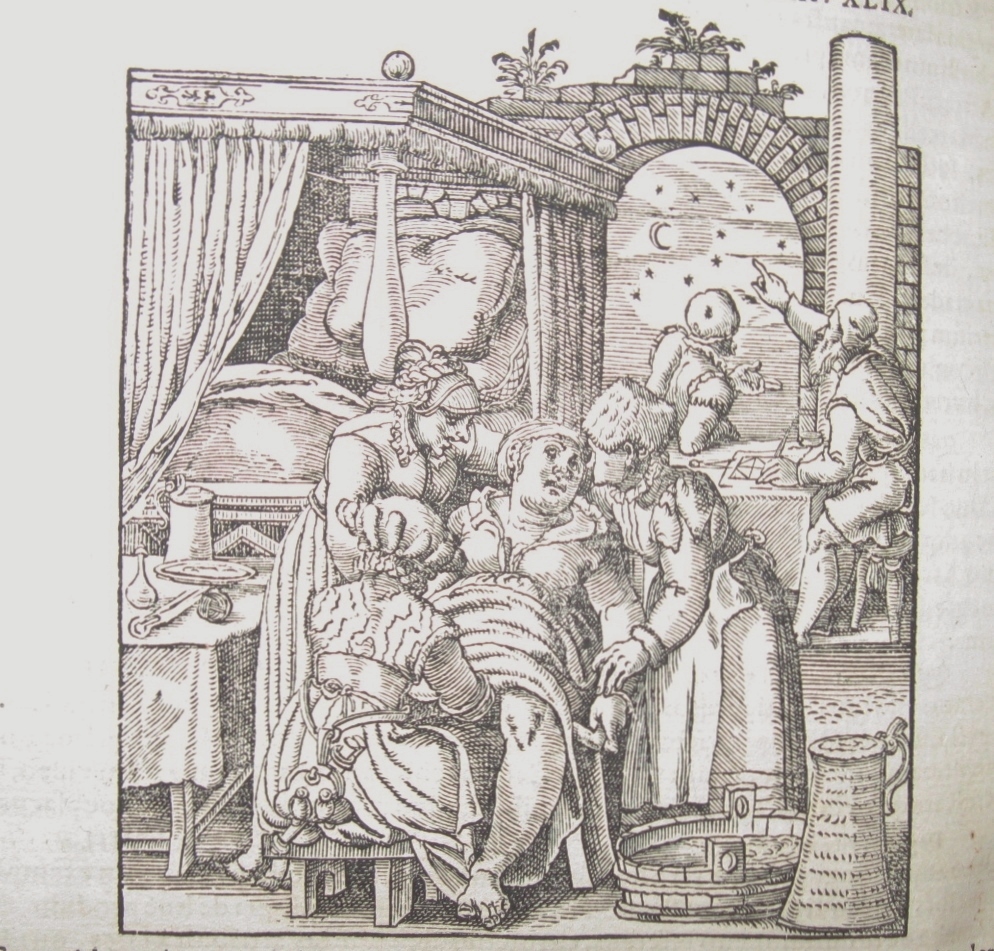
The Most Ancient Encyclopaedia Extant
40. PLINIUS SECUNDUS, Gaius [PLINY THE ELDER]. Historia mundi naturalis… folio. pp. 18 p.l.(incl 2 blanks), 528, [52], [183]index. index with separate title. woodcut coat of arms & 50 woodcuts in the text. woodcut ornaments & initials. woodcut printer’s device on titles. first title in red & black. An attractive copy in old sprinkled calf (c1700), gilt back (slight wear to head of spine, lower rear joint starting to crack, some gatherings browned, repaired tear in 2 preliminary leaves – one blank – with no loss). from the library of Camille Aboussouan, with library arms on covers and bookplate. Frankfurt am Main: [Martin Lechler for Sigmund Feyerabend], 1582. $7,200
Attractively illustrated edition of the most ancient encyclopaedia extant. Pliny's work, containing all that was known in ancient Roman times concerning mathematics, physics, cosmography, astronomy, geography, anthopology, physiology, medicine, zoology, agriculture, botany, mineralogy, commerce, and the history of art, remained the major source of knowledge throughout the Middle Ages. It was first printed in 1469 by Johannes de Spira of Venice. The fifty text woodcuts illustrating the present edition were executed by Jost Amman, Hans Burgkmair, Hans Weiditz and others.
Adams P1579. Andresen 239n. BM STC German p. 705. Wellcome I 5122. cfDibner 75. cfDurling 3686ff. cfGarrison & Morton 89. cfPrinting & Mind of Man 5. cfStillwell 684.
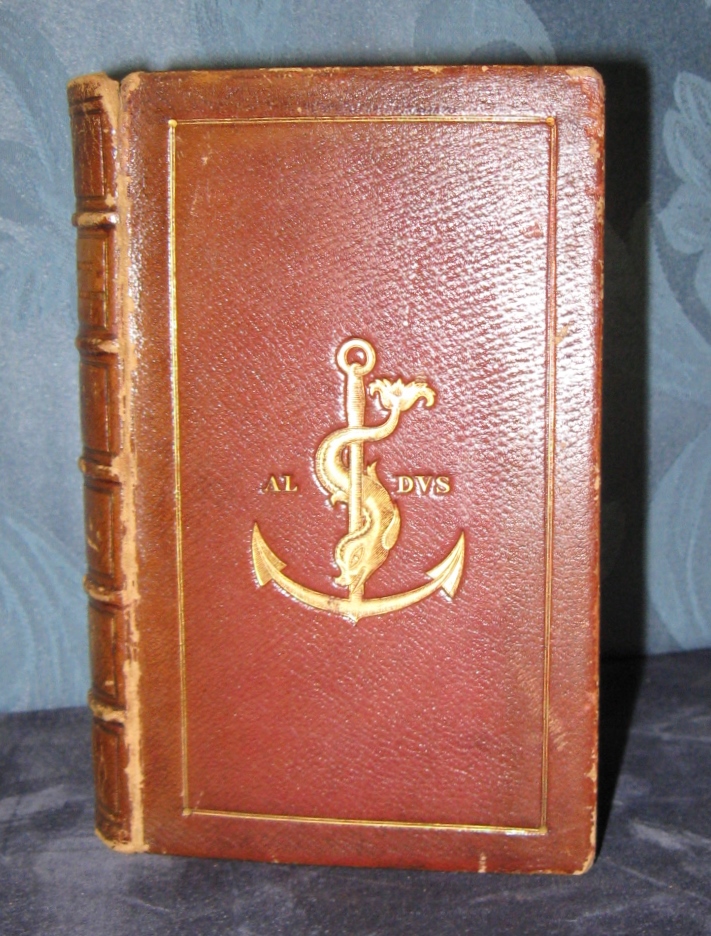
41. Plinius Secundus, [Gaius Caecilius] (PLINY THE YOUNGER) [62-113]. Epistolarum lbri X… 8vo. pp. 26 p.l., 525, [1 leaf]. Aldine anchor device on title & at end. 19th century red morocco, Aldine anchor device in gilt on covers, all edges gilt (rubbed, title lightly toned & with small paper repair in lower margin, ‘x’ in colophon date erased with tiny hole). probably from the Syston Park Library of Sir John Thorold. [Colophon on kk7r:] Venice: In Aedib. Aldi, Et Andreae Asulani Soceri, June 1518. $2,500
Second Aldine Edition. The letters of the consul and Governor of Bithinia, friend of Tacitus and Suetonius, provide an interesting view of the varied interests of a cultivated Roman gentleman. “The etiquette of the imperial circle, scenes from the law-courts and the recitation-room, the reunions of dilettanti and philosophers, the busy life of the capital or of the municipal town, the recreations of the seaside and of the country – all these he brings vividly before our eyes”. (Encyc. Britan., 11th Edn.) Topics range from his Tuscan villa, happy memories of Lake Como, love for his wife, Calpurnia, dreams, ghost-stories, the beauties of the Clitumnus and the floating islands of the Vadimonian lake, the eruption of Vesuvius in connection with the last days and death of Pliny the Elder, the deaths of Silius Italicus and Martial, the principles that should guide a Roman governor in Greece, the government of Bithynia, and the relations between the governor and the Emperor. “The Letters are models of graceful thought and refined expression each of them dealing with a single topic and generally ending with an epigrammatic point.” (Ibid.) The whole of Book 8 was first published in its proper place by Aldus Manutius in 1508.
Adams P1538. BM STC Italian p. 525. Renouard I 195.4. Dibdin (4th Edn.) II p. 330. Moss II pp. 493-94.
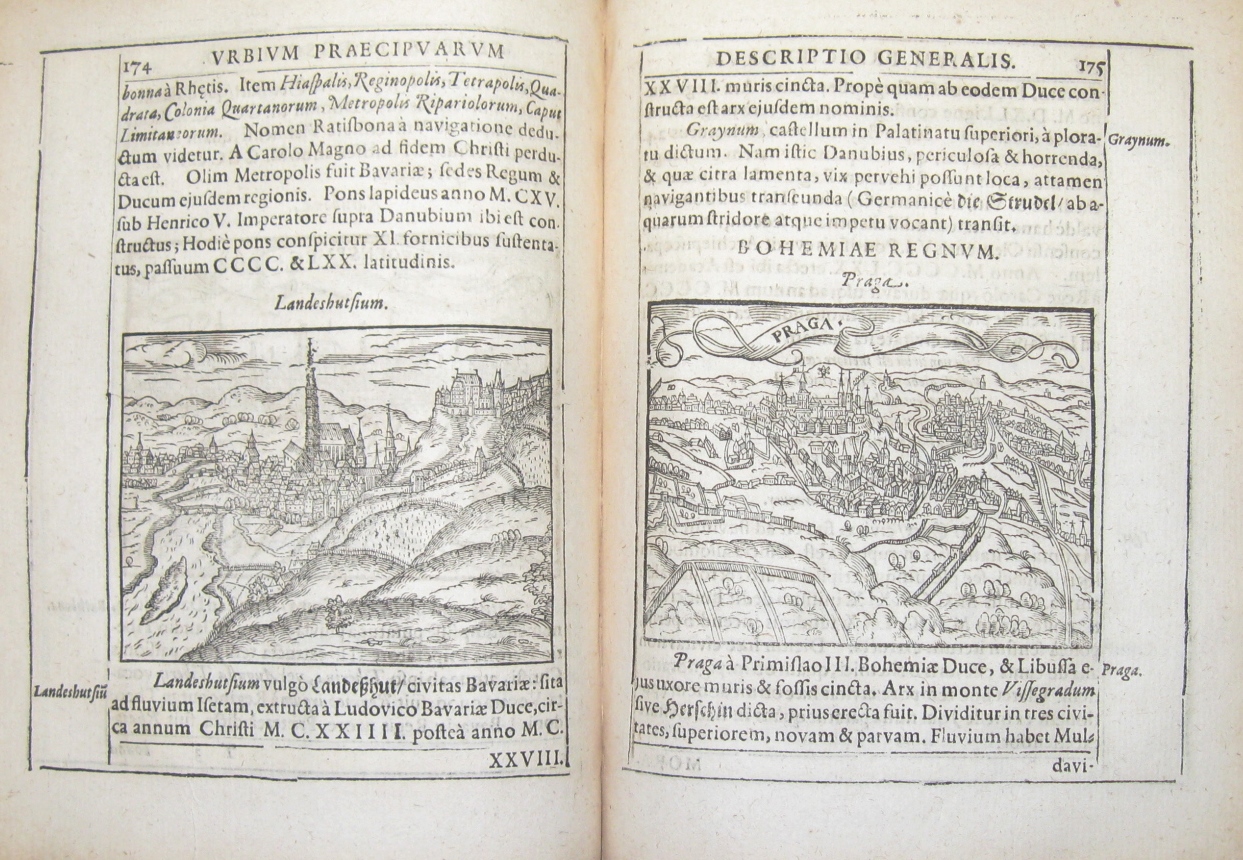
42. ROMANUS, Adrianus [1561-1615].Parvum Theatrum Urbium sive Urbium Praecipuarum Totius Orbis Brevis Et Methodica Descriptio. small 4to. pp. 4 p.l., 365 [ie. 371], [25]. title in red & black with woodcut printer's device. 67 text woodcuts (mostly town views, 2 full-page: Rome & Jerusalem). woodcut initials. contemporary calf (worn & oxidized, joints cracked, hinges repaired, internally very good). contemporary Latin ownership inscription on title of Thomas Hatcher, gifted to him by William ,Lytton of Knebworth, 1606. Frankfurt: Nicolai Bassaei, 1595. $7,600
First Edition. A collection ofbrief descriptions of European, Asian, African, and American cities, translated from the indices of the German edition of Braun and Hogenberg's Civitates Orbis Terrarum (1586). The attractive woodcuts mainly depict European cities (Geneva, Lyon, Paris, Antwerp, Wittemberg, Lubeck, Hamburg, Frankfurt, Basel, Ulm, Nuremberg, Vienna, Rome, Venice, Riga, &c.), but there are also views of Constantinople and Jerusalem. De Novo Orbe, sive India Occidentali, pp. 359-365, is devoted to America: Florida, New France, New Spain, Nova Galicia, Yucatan, Cuba, Brazil, Peru, &c.
Adams R694. Alden 595/65. Bell R306. BM STC German p. 745. Muller 1376. Phillips, Atlases, 65. Sabin 73000. Shaaber R192.
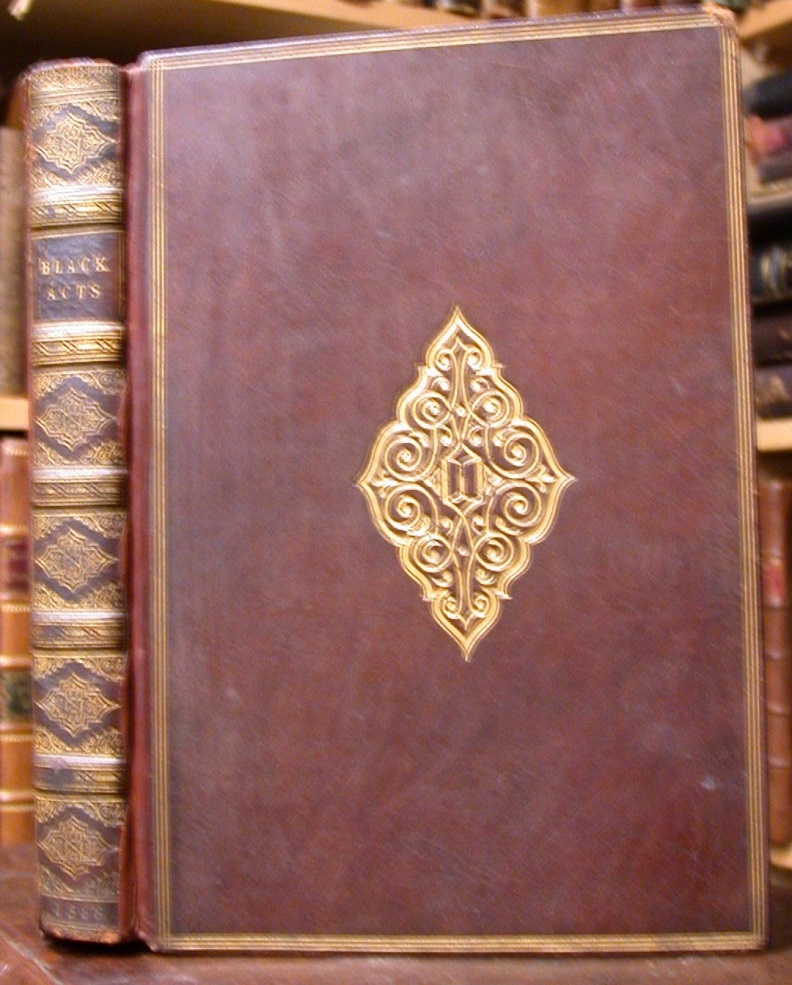
43. SCOTLAND. LAWS & STATUTES. The Actis And Constitutiounis of the Realme of Scotland maid in Parliamentis haldin be the rycht excellent, hie and mychtie princeis Kingis Iames the First, Secund, thrid, Feird, Fyft, and in tyme of Marie now Quene of Scottis, viseit, correctit, and extractit furth of the registers be the Lordis depute be hir Maiesteis speciall commissioun thairto. Anno Do. 1566. folio. ff. [14], ii-cxxii, cxxiiii-cxlv, [1], cxlvi-clviii, [2], clix-clxviii, [2], clxix-clxxxii. lacking initial blank & blank c4. woodcut title. woodcut initials. black letter. 19th century russia, gilt centre ornaments, gilt inside dentelles (joints repaired, head & foot of spine chipped, some of first few leaves apparently supplied from another copy, title cropped & repaired at corners with part of lower outer corner supplied in facsimile, marginal repairs to other prelims, occasional light soiling, light dampstaining in second part). a few old marginal notes. [Edinburgh: Robert Lekpreuik, 28 November, 1566. $7,500
First Edition, variant issue, of the earliest collection of Scottish acts and statutes, compiled by James Balfour and others, and edited by Edward Henryson. The commission to compile and publish the laws, known as the ‘Black Acts’, was appointed by Queen Mary largely through the advice of John Leslie, Bishop of Ross. The work, covering the period from the accession of James I in 1424, to the current reign of Mary, 1564, is an important source for the political history of the period. Also of interest here are the early printed references to the game of golf.
This copy corresponds to STC 21876, which combines elements of STC 21875 and 21876A, with cancels for folios 113, 118, 132, and 145, the latter followed by an unnumbered leaf; 2 unnumbered leaves following 158 and 168; 181 replaced by 2 leaves, including the new colophon dated 28 November; and 133 cancelled and not replaced, but with the earlier state of the title-page, line 3 ending with the word ‘the’.
Aldis 51. STC 21876.
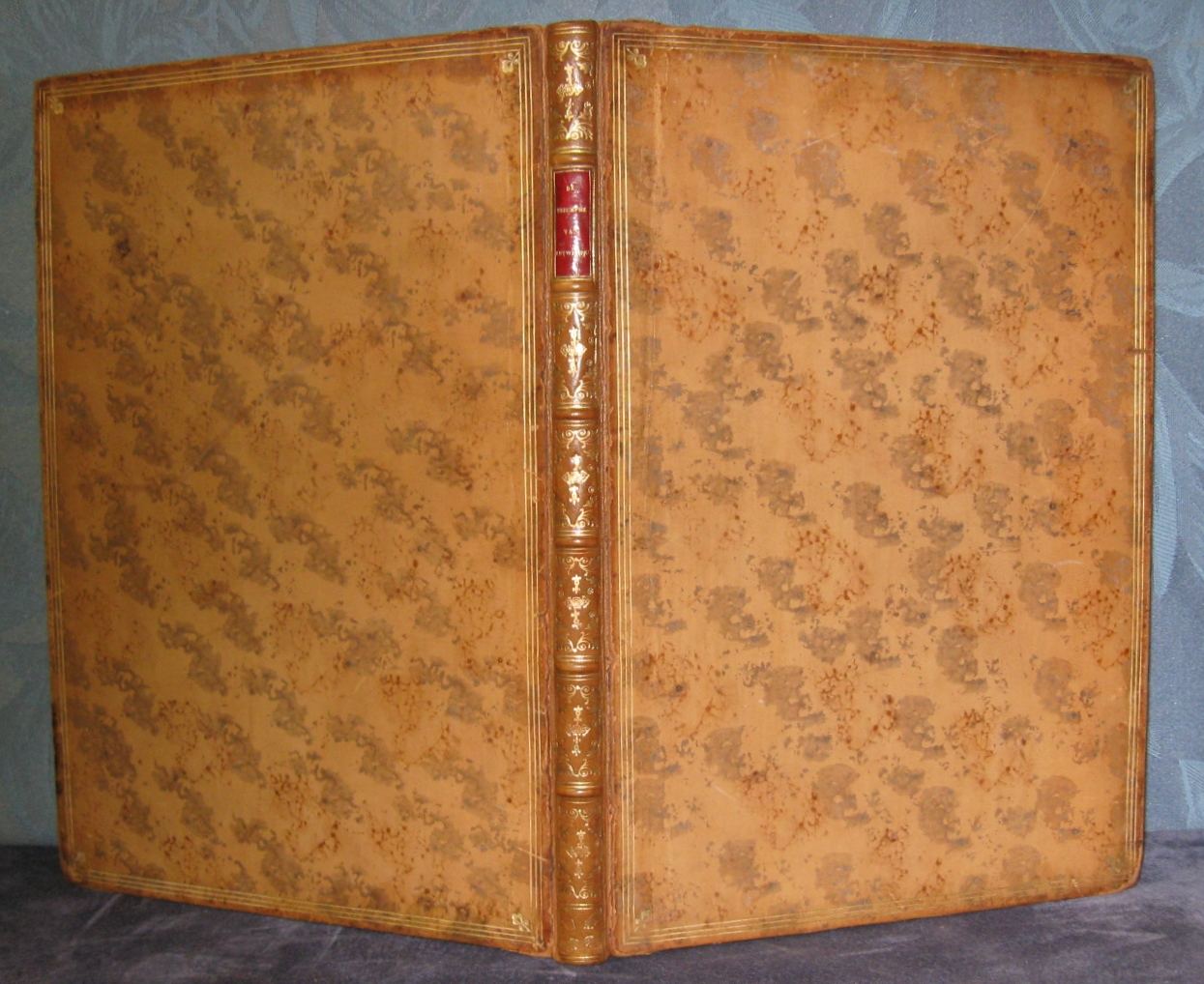
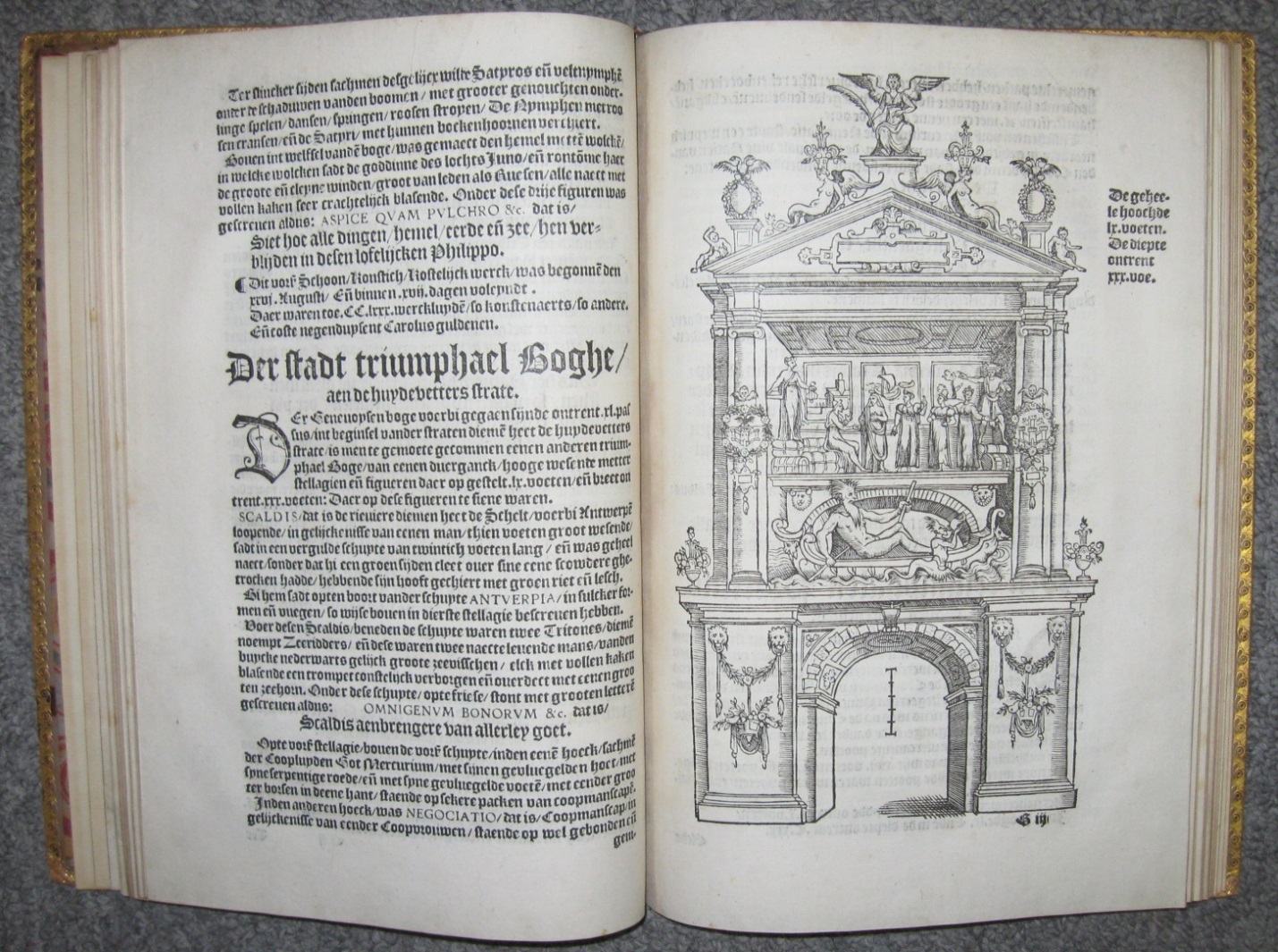
One of the Great Antwerp Renaissance Fête Books
44. [SCRIBONIUS], Cornelius, Grapheus [1487-1558].[De Triumphe van Antwerpen]. De seer wonderlijcke schoone Triumphelijcke Incompst, van den hooghmogenden prince Philips, Prince van Spaignen, Caroli des vijfden, Keysers sone. Inde stadt van Antwerpen, Anno M.CCCCC.XLIX.]. folio. [ff. 56]. half-title & title within large woodcut borders in the style of Vredeman de Vries. 29 woodcuts in the text (1 large 3-page folding, some double-page). A near fine copy in modern mottled calf, rebacked preserving endpapers, corners renewed (folding leaf repaired in fold, lower outer corner of a few leaves repaired). [Colophon on O3v:] Antwerp: Gillis van Diest for Pieter Coecke van Aelst, 1550. $9,500
First Edition of the Dutch Translation attributed to Gillis van Diest of one of the great Antwerp Renaissance fête books. The work celebrates the entry of Philip II of Spain, into Antwerp, as hereditary sovereign of the Low Countries. This magnificent and costly reception was the most splendid of the century. Illustrating the text are twenty-nine woodcuts showing the triumphal arches erected by the many foreign workers resident in Antwerp, and theatrical decors executed by Flemish painter, Pieter Coecke van Aelst [1502-50], court painter to Emperor Charles V and father-in-law of Pieter Bruegel the Elder. “Coecke…is a key figure in the promotion of the renaissance style in the Netherlands but tempered with concessions to local tradition. We can see this in the design of his arches, which embroider onto classical forms the strapwork, cartouches and other flourishes which were to become the hallmark of Antwerp mannerism.” (Roy Strong, Art And Power Renaissance Festivals 1450-1650, p. 90)
Landwehr 25.Adams S763. BM STC Dutch p. 185. Berlin Kat. 2938. Vinet 557. Graesse III 137. Muller 403. cfBrunet II 1710-11.
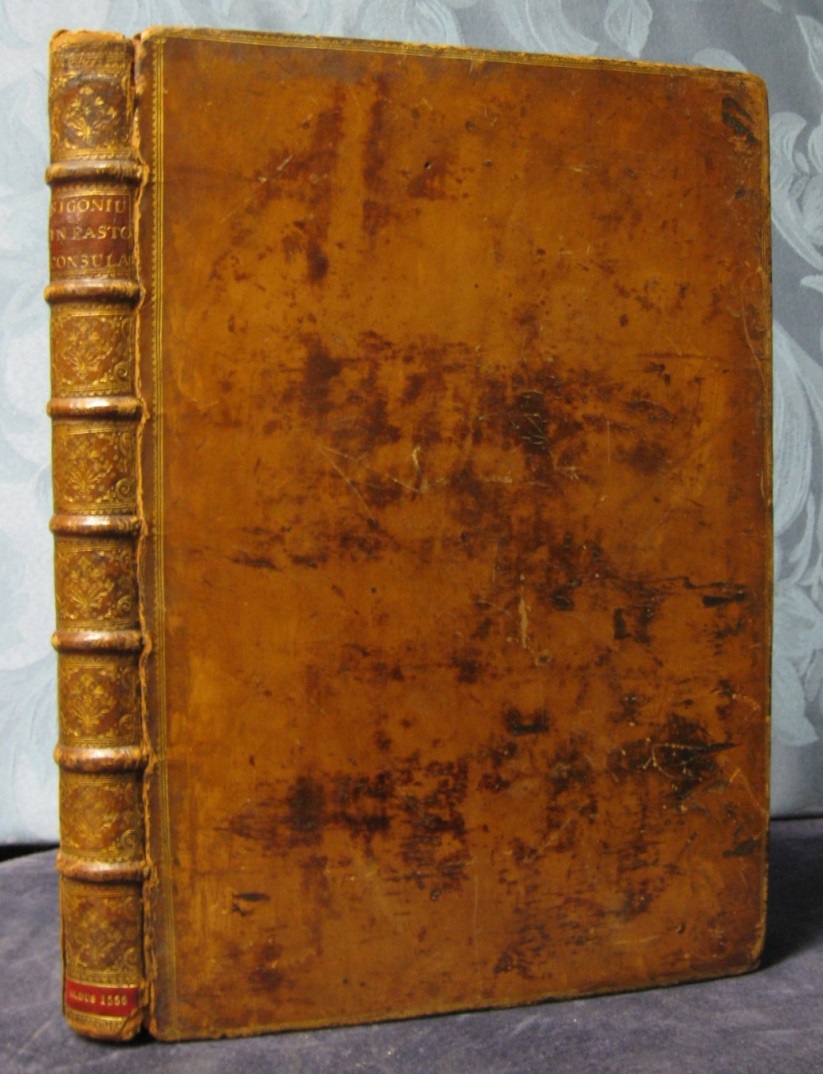
45. SIGONIUS, Carolus [Carlo SIGNONIO] [c1542-1584]. Fasti Consulares, ac triumphi acti A Romulo Rege Usque Ad Ti. Caesarem. Eiusdem In Fastos, Et Triumphos, Id Est In Universam Romanam Historiam Commentarius… 2 Parts in 1, the chronological tables, of which the title is given, bound after commentary. folio. ff. 16; 169 [i.e. 165; ff. 165-168 omitted in foliation], [1]. Aldine woodcut device on titles. 17th century calf, gilt back (front joint cracked, spine ends worn, covers scuffed, titles soiled & with erased ownership entries, occasional light spotting). Venice: Paulus Manutius, Aldi F, 1556. $2,750
Second and Best Aldine Edition, Greatly Enlarged, of this work by the distinguished Italian historian and antiquary, Carlo Sigonio, who was professor of Greek literature at Modena and later held the chair of eloquence at Padua. “Sigonius’s reputation chiefly rests upon his publications on Greek and Roman antiquities, which may even now be consulted with advantage: Fasti consulares (1550)…with commentary, from the regal period to Tiberius, the first work in which the history of Rome was set forth in chronological order, [is] based upon some fragments of old bronze tablets dug up in 1547 on the site of the old Forum.” (Encyc. Britan., 11th Edn.) The first edition of 1550 and the first Aldine edition of 1555 did not include the extensive commentary but consisted of only the chronological tables.
Renouard I p. 408, no. 16. Adams S1115. BM STC Italian p. 626. Brunet V 380. Graesse VI 403.
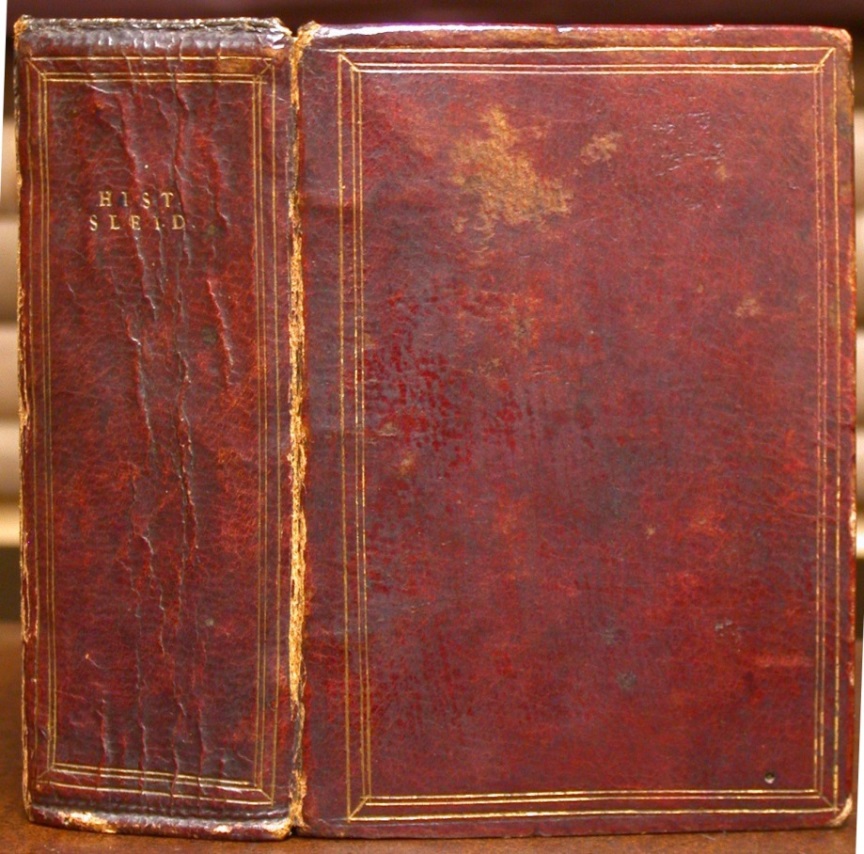
46. SLEIDAN, Johann [1506?-1556]. De Statu Religionis Et Reipublicae, Carolo quinto, Caesare, Commentarii. Additus est Liber XXVI... [BOUND WITH:] ...De Quatuor Summis Imperiis, Babylonico, Persico, Graeco, & Romano, Libri tres. 2 Volumes in 1. 16mo. ff. 458, [14]index; 50, [6]index. woodcut printer's device on titles. woodcut initials. ruled in red throughout. early red morocco, all edges gilt (joints rubbed, neat repair to first title, dampstain just visible at lower edge of some leaves, spotting to last gatherings of second title). bookplates of P.J.B.Despaux & William Stirling Maxwell. [Geneva]: Conrad Badius, 1559. $1,400
An appealing copy of this early edition of "the most important single source of the Reformation era" (Thompson), written by the great German humanist diplomat. Sleidan, whose real name was Johann Philippson, was appointed historian of the Reformation by the Schmalkaldic League in 1542. His monumental chronicle was first printed at Strassburg in 1555, one year before his death. Despite his Protestant convictions, Sleidan strove to achieve the utmost impartiality in his history. "It was [in fact] so impartial that it pleased no one, not even Melanchthon." (Encyc. Brit., 11th Edn.)
These editions not in Adams. Thompson I, pp. 528-29.
47. STANFORD, Sir William [1509-1558]. An exposition of the Kinges Prerogative, collected out of the great Abridgement of Justice Fitzherbert, and other olde writers of the lawes of England… small 4to. ff. 85. woodcut initials. partly black letter. modern half calf (title soiled & with old ms. notes, first initial inexpertly coloured). London: Imprinted by Richard Tottel, [1577]. $1,400
Fourth Edition (first: 1567). The King’s Prerogative referred to those rights and powers enjoyed exclusively by the monarch that acknowledged his superior position and enabled him to discharge the task of governing. Stanford, a learned lawyer who became a justice of the bench of Common Pleas in 1554, discusses, among other matters the king’s rights with regard to wardship, idiots and lunatics, distribution and seizure of land from tenants-in-chief (primer seisin), &c.
STC 23216. Sweet & Maxwell I.119.79. Beale T495. Winfield p. 319. cfMarvin pp. 662-63. cfRead 1518.
48. THEODORIC, Sebastian, of Windsheim. Novae Quaestiones Sphaerae, Hoc Est, De Circulis Coelestibus & primo mobili… 8vo. pp. 8 p.l., 320. woodcut sphere on title. woodcut diagrams in the text. 3 folding tables. old wrs., spine strengthened with strip of vellum (text embrowned, dampstaining to some leaves, some old marginalia on several leaves). Wittenburg: 1573. $1,100
Third Edition (?) of this scarce elementary treatise on astronomy. “[The author] cites Copernicus as well as Ptolemy for the relative magnitudes of earth and sun. He gives Copernicus’s figures for the maximum and minimum declination of the sun, and his estimate that this movement of the ecliptic approaching and receding from the equator is completed in 1717 years.” (Thorndike) Theodoric was first professor of philosophy at Wittenberg, and later held the chair of higher mathematics, geometry, and astronomy.
cfAdams T511. cfBM STC German p. 855. cfHouzeau & Lancaster 2620 [vide WINSHEMIUS]. Thorndike VI pp. 34-35.
49. XENOPHON. I Fatti De i Greci…Tradotto Per Messer Lodovico Domenichi. small 8vo. ff. 163. lacking final leaf with printer’s device. part of title within woodcut border. woodcut printer’s device on title. woodcut ornaments & initials. 19th century calf (worn & oxidized, several small holes in title affecting 2 letters, light dampstains & foxing to outer leaves). Venice: Gabriel Giolito De’ Ferrari, 1558. $950
Second Edition of the Italian Translation by Lodovico Domenichi (first: 1548).
Adams X40. Bongi II p. 64. BM STC Italian 738. Graesse VI 403. Hoffmann III p. 605. Schweiger I p. 344.
SEVENTEENTH CENTURY
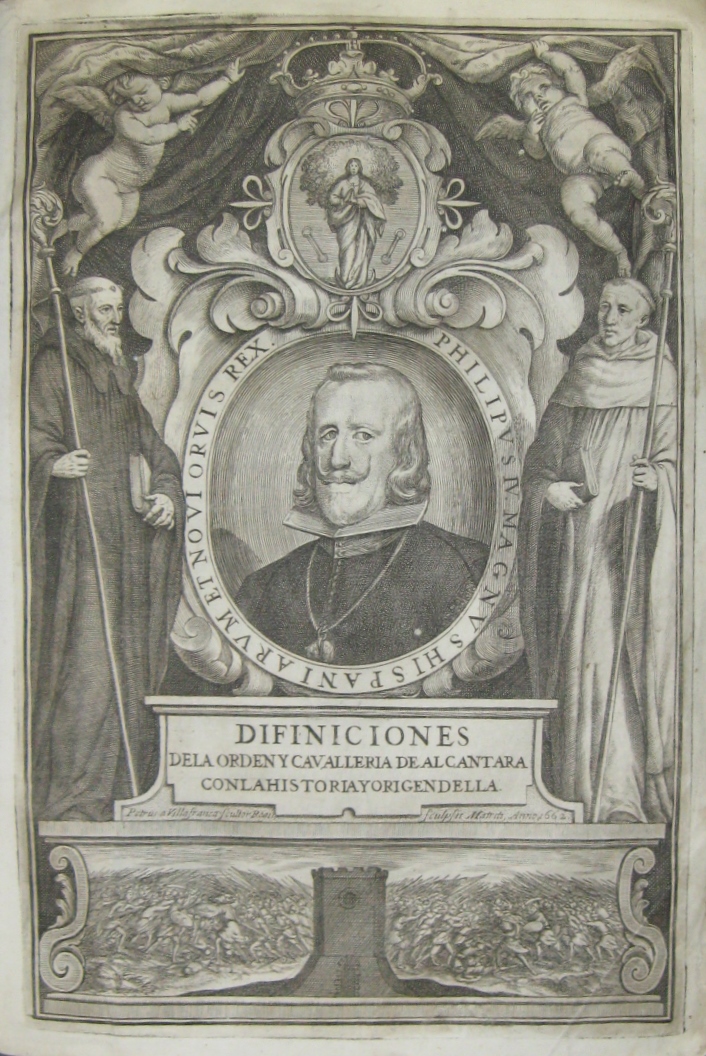
50. ALCÁNTARA, Orden Y Cavallería. Difiniciones De La Orden Y Cavallería De Alcántara Con La Historia Y Origen Della. folio. pp. 566. engraved title & full-page engraving on T2, both by Pedro de Villafranca. engraved arms of the order on A1. woodcut ornaments & initials. contemporary vellum (several old repairs, ties wanting, some scattered foxing & browning). [Colophon on Aaa8r:] Madrid: Diego Díaz De La Carrera, 1663. $2,000
Second Edition (first: 1609).
[BOUND WITH, apparently as issued:] CALDERON DE ROBLES, Juan. Privilegia Selectiora Militiae Sancti Iuliani de Pereiro (hodie de Alcántara) Cisterciensis Ordinis, à Summis Pontificibus hactenus concessa. folio. pp. 236. engraved arms of the order on title. woodcut initials. (some foxing). Madrid: Diego Díaz De La Carrera, 1662.
First Edition.
A history of the Knights of Alcántara, one of the three most ancient orders of Spain, all of which were originally founded as military religious orders to fight against the Moors. They were instituted about 1156 by Don Sanchez and Don Gomez de Barrientos, and confirmed as a religious order of knighthood under Benedictine rule by Pope Alexander III in 1177. Until about 1213 they were known as the Knights of St. Julian de Pereiro, changing their name when entrusted with the defence of the city of Alcántara in the territory of Estremadura. For some time they were subject in some degree to the grand master of the kindred order of Calatrava. The influence and wealth of the order gradually increased until the Knights were almost as powerful as the sovereign. In 1495, the grand mastership of Alcántara was invested in the Catholic King, Ferdinand of Aragon; this arrangement was ratified by Pope Alexander VI, and, in 1523, declared permanent by Adrian VI. Bound herewith is a collection of the various papal privileges granted to the order. The Knights of Alcántara ceased to exist as a spiritual body in 1835.
Goldsmith, BM STC Spanish Books, A102-103. Palau 69844 & 40229.
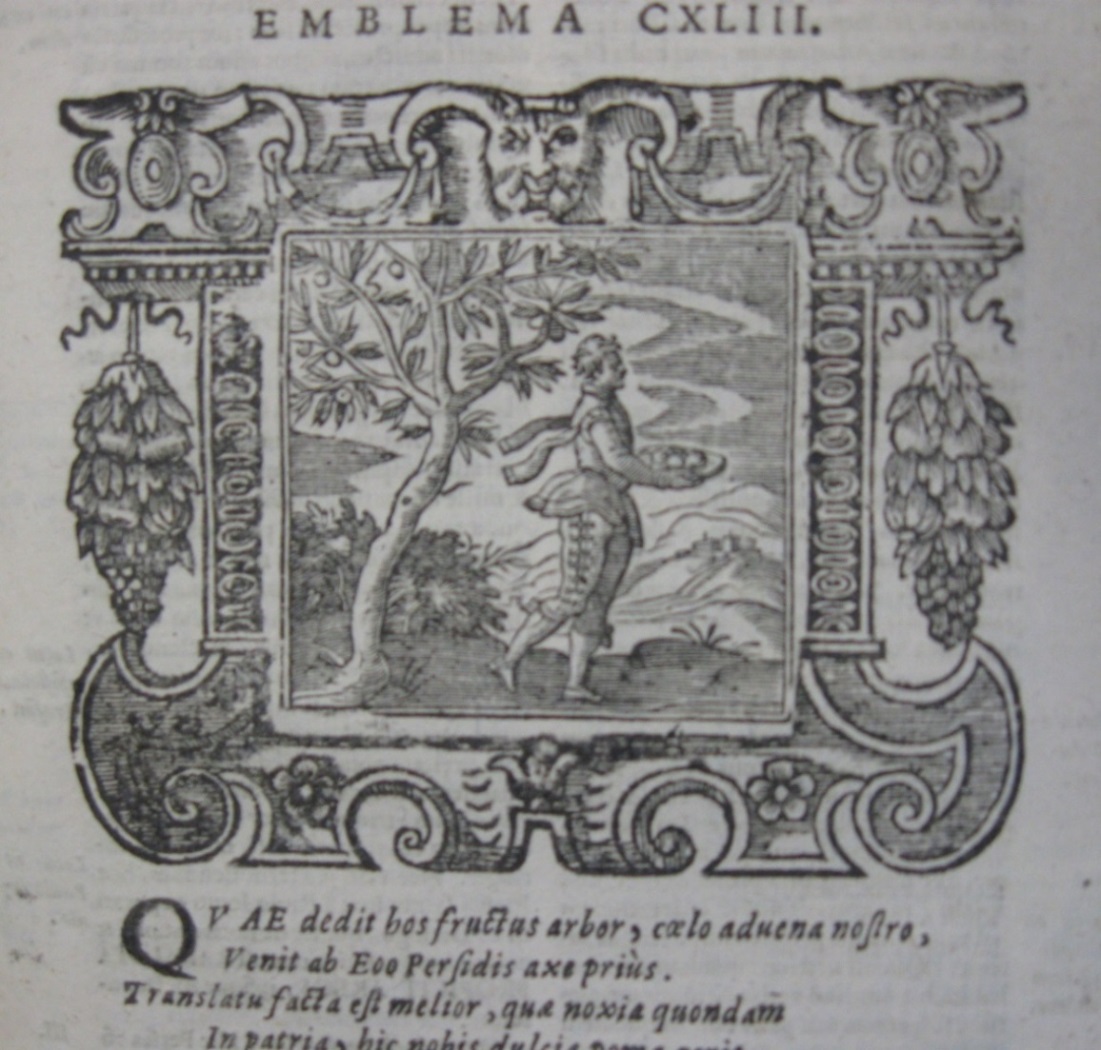
51. ALCIATI, Andrea [1492-1550]. Emblemata Cum Commentariis Claudii Minois I. C. Francisci Sanctii Brocensis & Notis Laurentii Pignorii Patavini…Opera Et Vigiliis Ioannis Thuilii Mariaemontani Tirol… small 4to. pp. lxxx, 1001, [1], engraved title by Ruphenus. 212 woodcut emblems in the text. text in double columns. woodcut device on title. woodcut device on verso of last leaf. woodcut tailpieces. contemporary vellum, rebacked with spine mounted (small hole in Ii1 with loss of a few letters on 4 lines verso & recto, 1 small marginal repair). armorial bookplate of A.L.Eldridge. ownership entry of Dutch art historian & poet Jan Emmens. Padua: Paolo Frambotti, 1661. $2,500
First published in 1531, Alciati’s Emblemata was the most popular and influential of emblem books. The present edition is based on the 1621 Paduan edition, the most extensively commentated of Alciati editions, edited by Joannes Thuilius, professor in Freiburg im Breisgau, who combined also the commentaries by Mignault, Sanchez, and Pignorius. The woodcuts are the same as in the 1618 and 1621 Paduan editions but incorporate new borders. The 1621 edition marked the reintroduction of the offensive emblem LXXX, which had been banished from many previous editions.
Landwehr 103. Green 165. Praz p. 252.
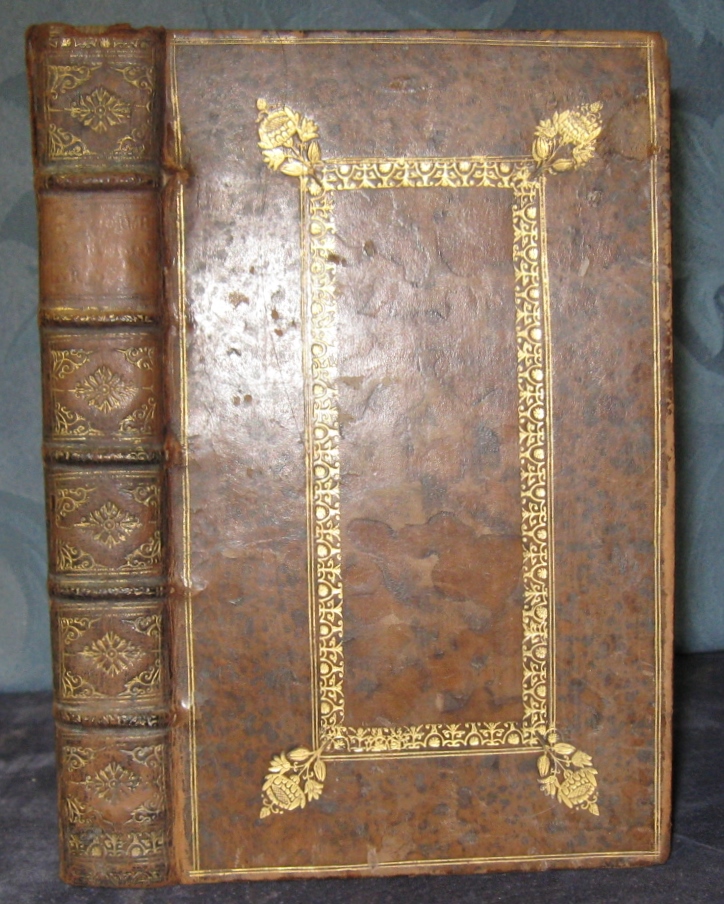
52. [ALLESTREE, Richard] [1619-1681]. The Government Of The Tongue…third impression. 8vo. pp. 8 p.l., 224. complete with initial imprimatur leaf. engraved frontis. woodcut ornaments & initials. contemporary gilt-paneled calf, gilt back (lacking spine label (short splits in upper joints). Oxford: At the Theater, 1675. $750
[BOUND WITH:] [ALLESTREE, Richard]. The Art of Contentment. 8vo. pp. 4 p.l., 214, [1]. engraved frontis. & title vignette of Sheldon Theatre. woodcut ornaments & initials. (frontis. shaved at outer edge). Oxford: At the Theater, 1675.
Third Edition; First Edition. A royalist divine, noted for his rescue of Christ Church plate, Allestree was Regius Professor of Divinity at Oxford and a prolific writer of popular religious tracts on practical conduct.
Wing A1135 & A1085. Madan 3046 & 3043. McAlpin p. 693 (4th Edn. of 1st tract).
The First Great Autobiography
53. AUGUSTINE, Saint. St. Augustine's Confessions: With the Continuation of his Life, Extracted out of Possidius, and the Father's own unquestioned Works. Translated into English. 8vo. pp. 2 p.l., 402, [blank leaf], 425-501, [1]blank, [28]incl. table & errata [pp. 426-500 omitted in pagination]. old calf, rebacked (light dampmark to upper margins of first half). np [Oxford?]: 1679. $2,500
First Complete Edition of this English translation by Roman Catholic controversialist Abraham Woodhead [1609-1678]. The first part, consisting of the Confessions, was first published in 1660 under the title The Life of St. Augustine, while the second, relating Augustine's life after his conversion, is based on the work of his friend and domestic, Possidius, and other of Augustine's works.
"The Confessions is the first great autobiography in which personal confession and revelations are linked with the spirit of Christian piety and devotion. It was written soon after Augustine became Bishop of Hippo in 397, and none of his other writings, apart from The City of God, has been more universally read or admired. Its strength of thought and confession of weakness have been a constant support to Christians ever since." (Printing and the Mind of Man)
Wing A4207. cfPrinting and the Mind of Man 7
54. [BACON], Sir Francis [1561-1626]. The Essayes Or Counsels, Civill And Morall. small 4to. pp. 5 p.l., 340, [38]. with final blank but without the first. woodcut ornaments & initials. contemporary calf, rebacked (few old marginal notes & underlines). London: Printed by John Haviland, 1632. $1,650
“Of Bacon’s literary, as distinct from his philosophical and professional works, far the most popular and important are the Essays…[they] are the most original of all Bacon’s works, those which, in detail, he seems to have thought out most completely for himself, apart from books and collections of commonplaces. The last edition [referring to that of 1625, the first to contain all fifty-eight essays] teems indeed with quotations and illustrations, but they are suggested by his own matter and do not suggest it. Though the Essays have the same title as the larger collection of Montaigne, the two works have little in common, except that rare power of exciting interest and the unmistakable mark of genius which is impressed on them both.” (DNB)
Gibson 16. STC 1150. cfGrolier, Langland to Wither, 14-15. cfPforzheimer 27-31.
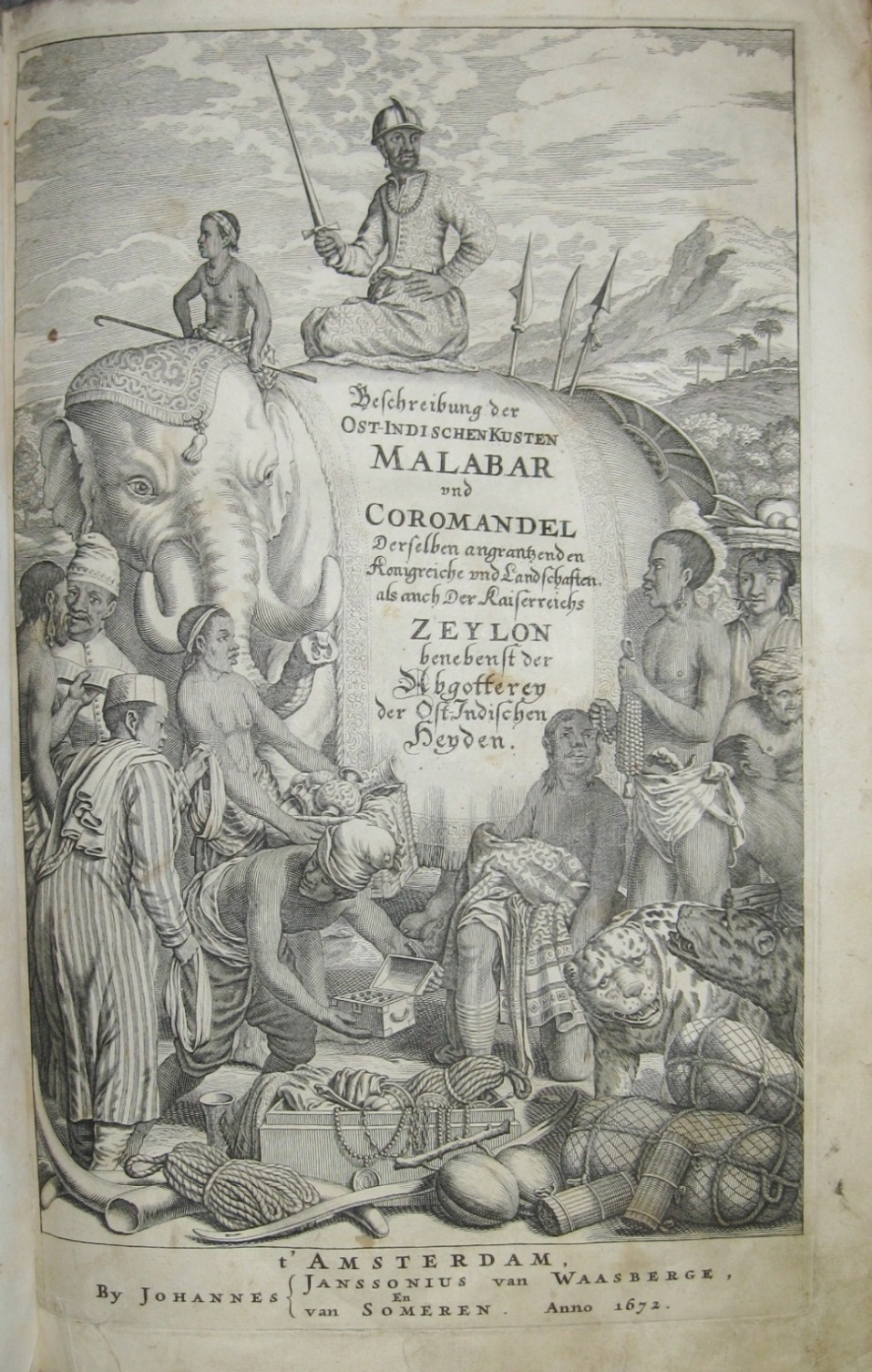
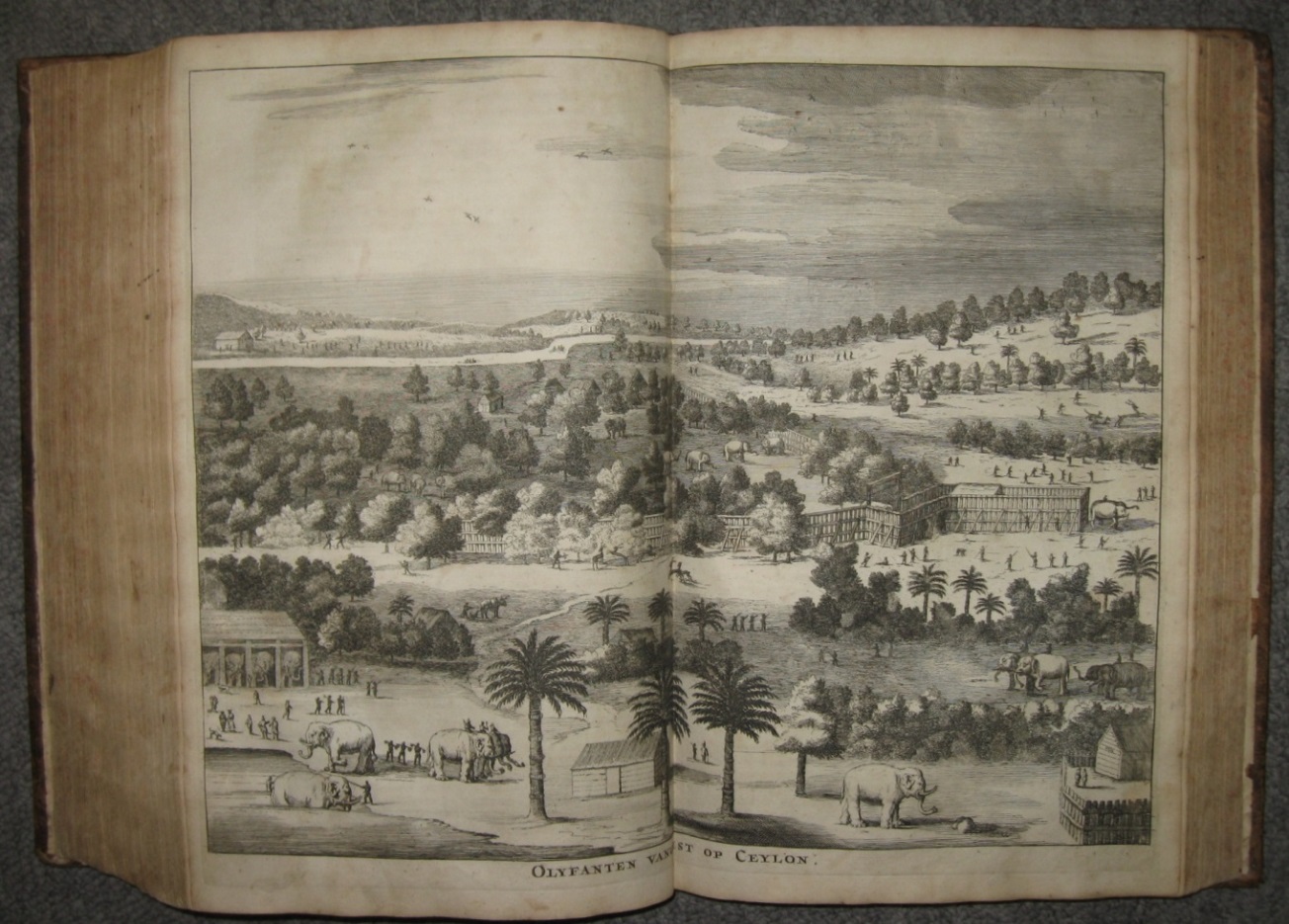
Finely Illustrated Work on Southern India and Ceylon
55. BALDAEUS, Philippus [1632-1672]. Wahrhaftige Ausführliche Beschreibung Der Berühmten Ost-Indischen Kusten Malabar und Coromandel, Als auch der Insel Zeylon… folio. pp. 4 p.l., 610, [2]colophon & plate list, [24]index. additional engraved title, full-page engraved portrait of the author, 34 engraved maps & views (33 double-page, 1 folding), & numerous engravings in the text (several full-page). text in double columns. contemporary calf (corners worn, small tear to head of spine, short tears to lower margin of prelims & 1 map repaired with no loss, scattered light foxing, tears to plan of Negapatam repaired – no loss). Amsterdam: Johannes Jansson van Waasberge & Johannes van Someren, 1672. $7,000
First Edition of the German Translation of this finely illustrated work on Southern India and Ceylon, including extensive descriptions of the geography of the region, the major cities and ports, history and natural history, trade and commerce, government, the manners, customs and Hindu religion of the native inhabitants, the wars between the Portuguese and Dutch, &c. “The author was a Dutch missionary in Malabar and Coromandel districts. His narrative gives considerable information on the Dutch settlements in southern India. He bears witness to the dreaded Malabar pirates who still infested the western coasts of India…”. (Oaten, Early Travellers and Travels in India) The plates include views and plans of Amadabath, Surat, the English fort in Bombay, Cochin, Goa, Negapatam, Masulipatam, Galle, Colombo, Negumbo, Jaffna, &c.
Landwehr, VOC, 557. Howgego B10. cfBell B19. cfCox I 283. cfTiele 70.
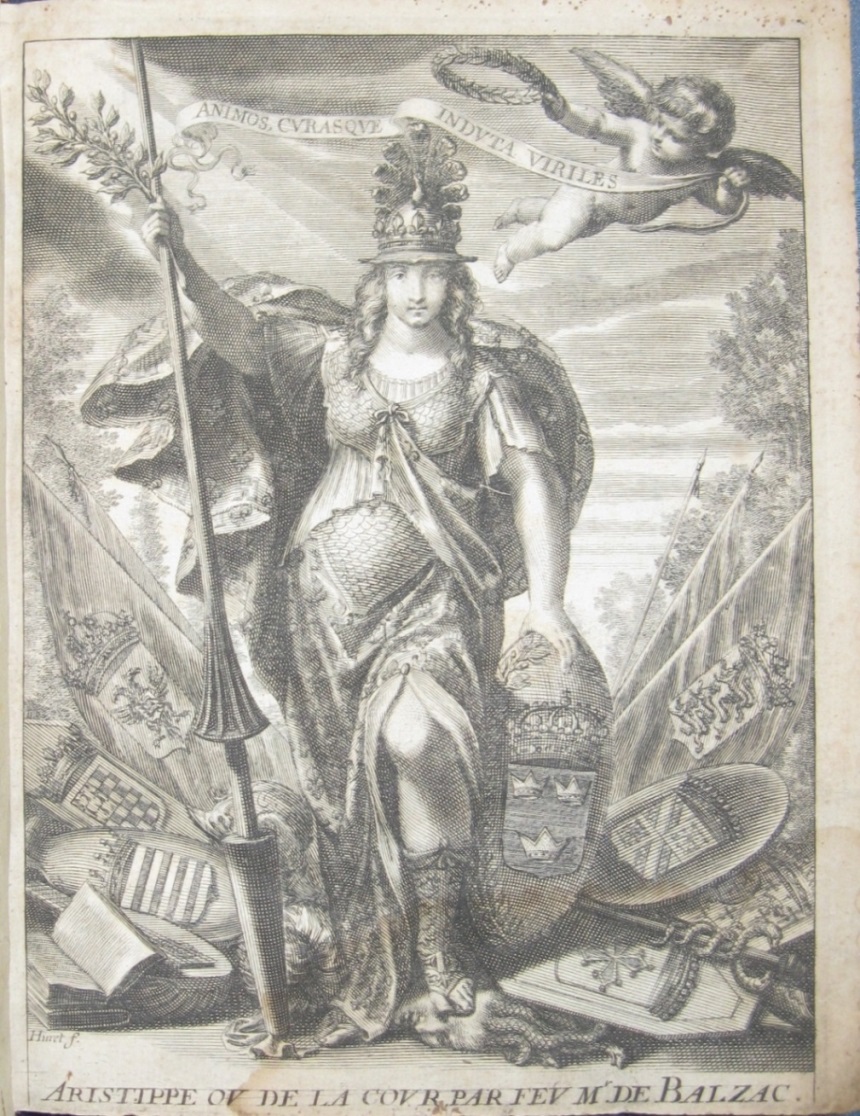
56. BALZAC, [Jean Louis Guez] De [1595-1654]. Aristippe, Ou De La Cour. 4to. pp. 4 p.l., 244, [18]table, [1]privilege. engraved frontis. by Huret. engraved printer’s device on title. woodcut headpieces & initials. contemporary calf (worn but sound, short splits in joints, light dampstaining to lower margin – heavier in first 2 quires, some light foxing & browning). Paris: Augustin Courbé, 1658. $1,200
First Edition. Balzac was one of the writers who contributed the most to the perfection of the French language at the beginning of the seventeenth century, and introduced a masterly clearness, refined elegance and precision based on classical models into French prose style. He is thus credited with having executed in French prose a reform parallel to Malherbe’s in verse. He enjoyed the patronage of the Cardinal de Valette, who brought him to Italy and made him his agent in Rome, and upon his return to France, secured that of the Archbishop of Luçon and Cardinal Richelieu. Esteemed the leading prosaist of his time, he was unanimously elected to the Académie Française in 1634. The present treatise on the duties of sovereigns is dedicated to Christina of Sweden, who was herself an admirer of Balzac.
“Balzac “contributed greatly to the creation of the paradoxically formal colloquial style which still holds sway in French literary and academic circles…[he] wished above all to impose order, regularity, and gravity in prose…”. (New Oxford Companion to French Literature)
Brunet I 632-33.Cioranescu 9682. Goldsmith, BM STC French, G854 [vide GUEZ]. Tchemerzine I 374. Beugnot 126 (incorrect pagination).
57. BALZAC, [Jean Louis Guez] De [1595-1654]. Les Entretiens. 4to. pp. 48 p.l., 477, [1]blank, [20]table, [2]privilege. engraved printer’s device on title. engraved dedication headpiece & initial. woodcut ornaments & initials. contemporary mottled calf, gilt back (spine ends worn, front joint cracked & upper rear joint starting, corners worn, some gatherings lightly embrowned). Paris: Augustin Courbé, 1657. $1,100
First Edition. Edited by G.Girard. The present work was envisioned by Balzac as a modern version of Montaigne’s essay form.
Brunet I 632.Cioranescu 9681. Tchemerzine I 370 (incorrect pagination). Beugnot 121 (incorrect pagination). cfGoldsmith, BM STC French, G864 [vide GUEZ].
58. BALZAC, [Jean Louis Guez] De [1595-1654]. Les Oeuvres Diverses. 4to. pp. 4 p.l., 543, [1]privilege. full-page engraved portrait on ã4v. engraved printer’s device on title. woodcut ornaments & initials. (spine ends & corners chipped, joints partly cracked, light dampstain in upper margin & in lower inner margins through first quarter of text, marginal worming in some gatherings occasionally affecting headline only). Paris: P.Rocolet, 1644. $1,000
First Edition. The collection of essays includes: Le Romain - De la Conversation des Romains - Consolation au Cardinal de La Valette - Réponse à deux questions ou Du caractère & l’instruction de la Comédie - Mécenas - Paraphrase ou De la grande Eloquence - Dissertation sur une Tragédie intitulée Herodes Infanticida - De la Gloire - Dissertation sur une harangue prononcée dans l’Académie de Rome - Lettre au comte Clermont de Lodève - Relation à Ménandre - Passages défendus - Response faite sur le champ.
Brunet I 632.Cioranescu 9655. Tchemerzine I 379. Beugnot 104.
59. [BASSET, Robert]. The Lives Of All The Roman Emperors, being exactly Collected from Julius Caesar, unto the now reigning Ferdinand the second… 8vo. pp. 7 p.l., 384. lacking engraved title. numerous woodcut portraits in the text. woodcut initials. contemporary calf (spine ends & corners chipped, edges of some leaves ragged). London: Printed by N. and I.Okes, and are to be sold by George Hutton, 1636. $750
First Edition. Attributed to Richard Brathwait in Halkett & Laing & Grolier.
STC 1558. Grolier, Wither to Prior, 73.
60. BIBLE. ENGLISH. The Holy Bible, Containing The Old Testament and the New… 3 Volumes in 1. with Book of Common Prayer (with separate title, bound first). 4to. unpaginated. titles to OT & NT within elaborate woodcut borders. woodcut ornaments & initials. black letter. 17th century calf, rebacked (closely trimmed sometimes affecting sidenotes, foliation or catchwords, outer margin of 2 leaves in OT ragged with some loss of text, few tears with no loss). ownership entries of Mary Rowney, dated Jan. 24, 1768, and Mary Gatley (left her by her Aunt Mary Rowney), dated Jan. 1812 & notes on verso of NT title. London: Printed by Robert Barker, And by the Assignes of John Bill, 1639. $2,400
Darlow & Moule 417. Herbert 539. STC 2336.
61.BIBLE. ENGLISH. The Holy Bible: Containing The Old Testament And The New...8vo. bound without the Apocrypha. unpaginated. first title & title to the New Testament both within elaborate woodcut border. woodcut royal arms on verso of title. 2 woodcut headpieces, ornaments & initials. ruled in red throughout. contemporary gilt-paneled black morocco, gilt edges (head of spine torn, scar on upper cover, some gatherings sprung, some marginal soiling & occasional stains, edges of first few leaves frayed). ms. notes on outer blanks. London: Printed by Robert Barker and by the Assigns of John Bill, 1642. $1,500
Darlow & Moule 439. Herbert 565. Wing B2201.
[BOUND WITH:] DOWNAME, John [d. 1652].A BriefConcordance, Or Table to the Bible Of The Last Translation…Carefully perused and enlarged… unpaginated. woodcut headpiece & initial. ruled in red throughout. London: Printed for N.Bourn and F.Young, and are to be sold by Charles Green, 1646.
Wing B2066.
62. BIBLE. ENGLISH. The Holy Bible, Containing the Old Testament And The New… 2 Volumes in 1. 8vo. unpaginated. titles within typographic border & with typographic ornament. ruled in red throughout. (title backed repairing tear with slight loss to inner & lower borders, tear in first leaf of Apocrypha with some loss of text. A pretty copy in 18th century dark blue morocco, gilt back, all edges gilt. London: Printed by Henry Hills and John Field, 1660. $1,500
Darlow & Moule 526. Herbert 669 (without Apocrypha). Wing B2256.
63. BOSSUET, Jacques Bégigne [1627-1704]. Discours Sur L’Histoire Universelle… 4to. pp. 1 p.l., 561, [1]blank, [6]. engraved head & tailpiece & initial by Jolain after Le Pautre. contemporary sprinkled calf, gilt back (wear to extremities, short splits in joints, internally very good). Paris: Sebastien Mabre-Cramoisy, 1681. $1,500
First Edition. “This Treatise on World-History is the last noteworthy exercise in that type of universal history which, beginning with St. Augustine, interpreted the course of human history as a continuous manifestation of divine providence leading mankind towards salvation. Bossuet was the most famous court-preacher of Louis XIV…He wrote the Discours for the instruction of the Dauphin, whose tutor he was from 1670 to 1679; for history, Bossuet declared, is ‘the counsellor of princes’…a noble specimen of French prose.” (PMM)
“[Cet] ouvrage excita, dès qu’il parut, une admiration universelle que le temps n’a pas affaiblie; et il est impossible, en effet, de trouver dans aucune oeuvre humaine plus de force, de grandeur et d’éclat, une plus constante élévation de pensée avec une telle magnificence de langage.” (Nouvelle Biographie Générale)
Brunet I 1134. Cioranescu 14031. Goldsmith, BM STC French, B1513. Le Petit p. 420. Printing and the Mind of Man 157. Quérard I 427-28. Tchemerzine II 365-66.
64. BREREWOOD, Edw[ard] [1565?-1613]. Enquiries Touching the diversity of Languages, and Religions, through the chief parts of the World. small 4to. pp. 12 p.l., 203. woodcut ornaments & initials. 19th century half morocco (very worn, front joint cracked & weak, outer pages soiled, light foxing to outer leaves, dampstain in upper margin through first gatherings). London: Printed by John Bill, 1622. $1,250
Second Edition (first: 1614) of this early English work on comparative religion and linguistics by the English antiquary and mathematician. “Besides presenting the religions of the world and the areas dominated by them, Brerewood discusses the size and populations of little-known regions and even speculates on the size of the Great Southern Continent.” (Bell) “Includes reports on New World religious practices encountered by Spanish and Portuguese explorers.” (Alden) Brerewood’s is the earliest book to suggest the now accepted theory of the Asiatic origin of the American aborigine. This second edition contains five additional pages on the languages of Europe from Joseph Scaliger.
STC 3619. Alden 622/24. Bell B489. JCB II p. 162. Sabin 7732.
65. BURNET, Gilbert [1643-1715]. The Life And Death Of Sir Matthew Hale, Ktd. Sometime Lord Chief Justice Of His Majesties Court Of Kings Bench. small 8vo. pp. 9 p.l., 218. engraved frontis. portrait. modern morocco (frontis. backed & outer edge shaved & chipped with loss of several letters in caption, marginal repairs to K3, outer edges of last leaf chipped & with marginal notes, some light foxing). London: Printed for William Shrowsbery, 1682. $450
Second Edition (first: 1681).“The best life of Hale…based largely on information supplied by Robert Gibbon of the Middle Temple, a confidential servant of Hale’s and one of his executors…”. (Marke) Included at the end are a catalogue of books written by Hale and printed and sold by William Shrowsbery, a list of manuscripts not yet published, and catalogues of manuscripts and books bequeathed by Hale to the Society of Lincolns-Inn.
Wing B5828. cfMcAlpin IV 88 & cfMarke p. 1087 (different pagination).
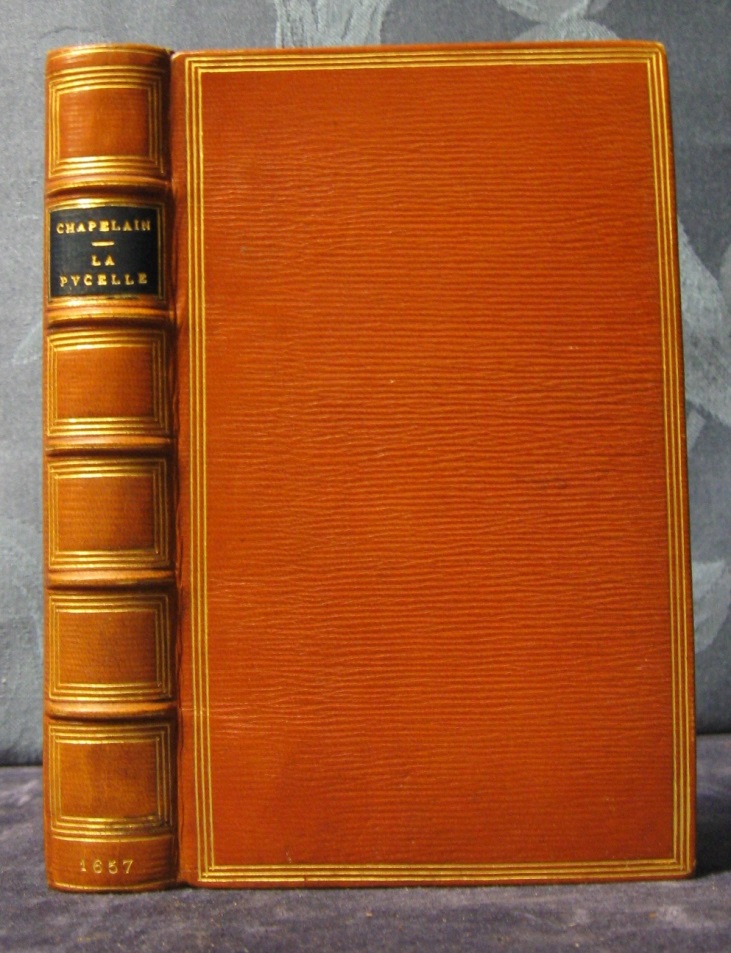
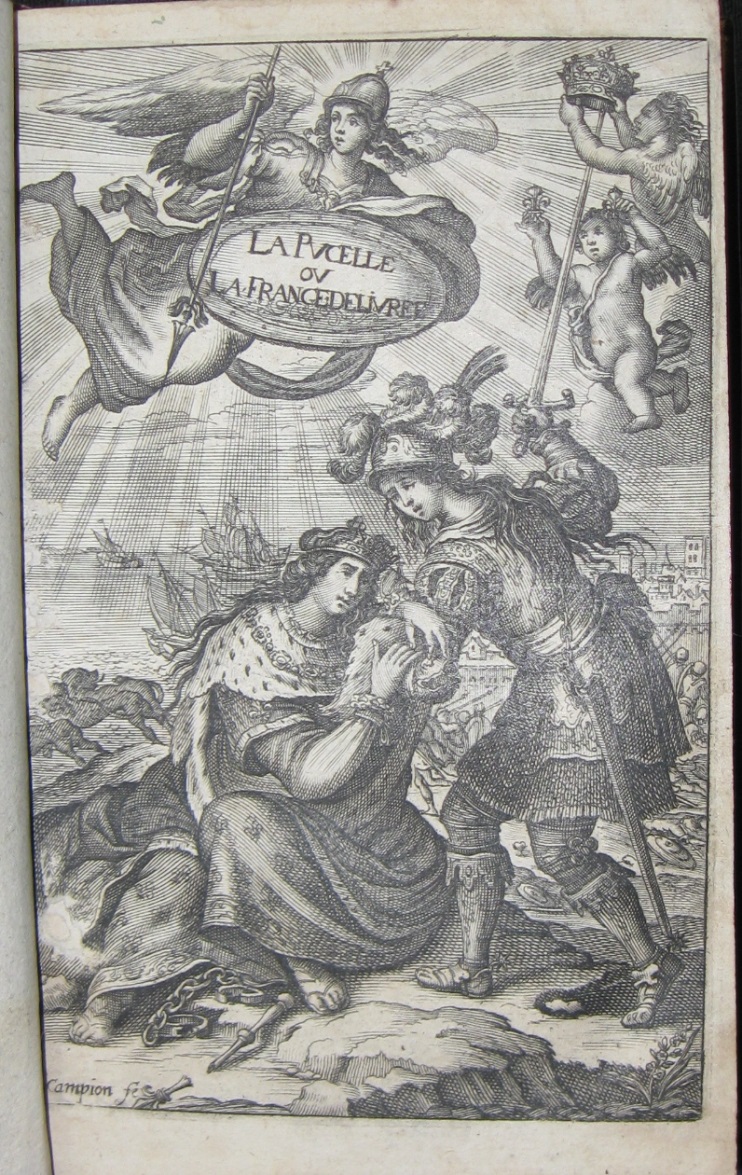
66. CHAPELAIN, [Jean] [1595-1674]. La Pucelle Ou La France Délivrée. Poëme Heroïque…Troisième Édition, reveue & retouchée. 12mo. pp. 34 p.l., 399, [1]blank, [30]table. 13 full-page engravings (incl. frontis.) by Campion & Humbelot. woodcut ornaments & initials. An appealing copy in 19th century straight-grained morocco (faint dampstaining at foot of text, several engravings shaved at outer margin). Paris: Augustin Courbé, 1657. $500
Third Edition. While his epic poem on Joan of Arc, first published amid great anticipation in 1656, was attacked and ridiculed by Boileau, Chapelain’s grand reputation as a literary critic and theorist was undisputed. He occupied a pivotal position in literary France for many years, being a founding member of the Académie Française, author of the plan of the Academy’s grammar and dictionary, principal author of the Academy’s critique of Le Cid, and subsequently Colbert’s main literary agent, in which capacity he was responsible for securing royal pensions for Corneille, Racine and many other French writers. Only the first twelve books of his poem were published, the other twelve remaining in manuscript.
Brunet I 1794. cfCioranescu 18494-95. cfGraesse II 119. cfTchemerzine III 239-40.
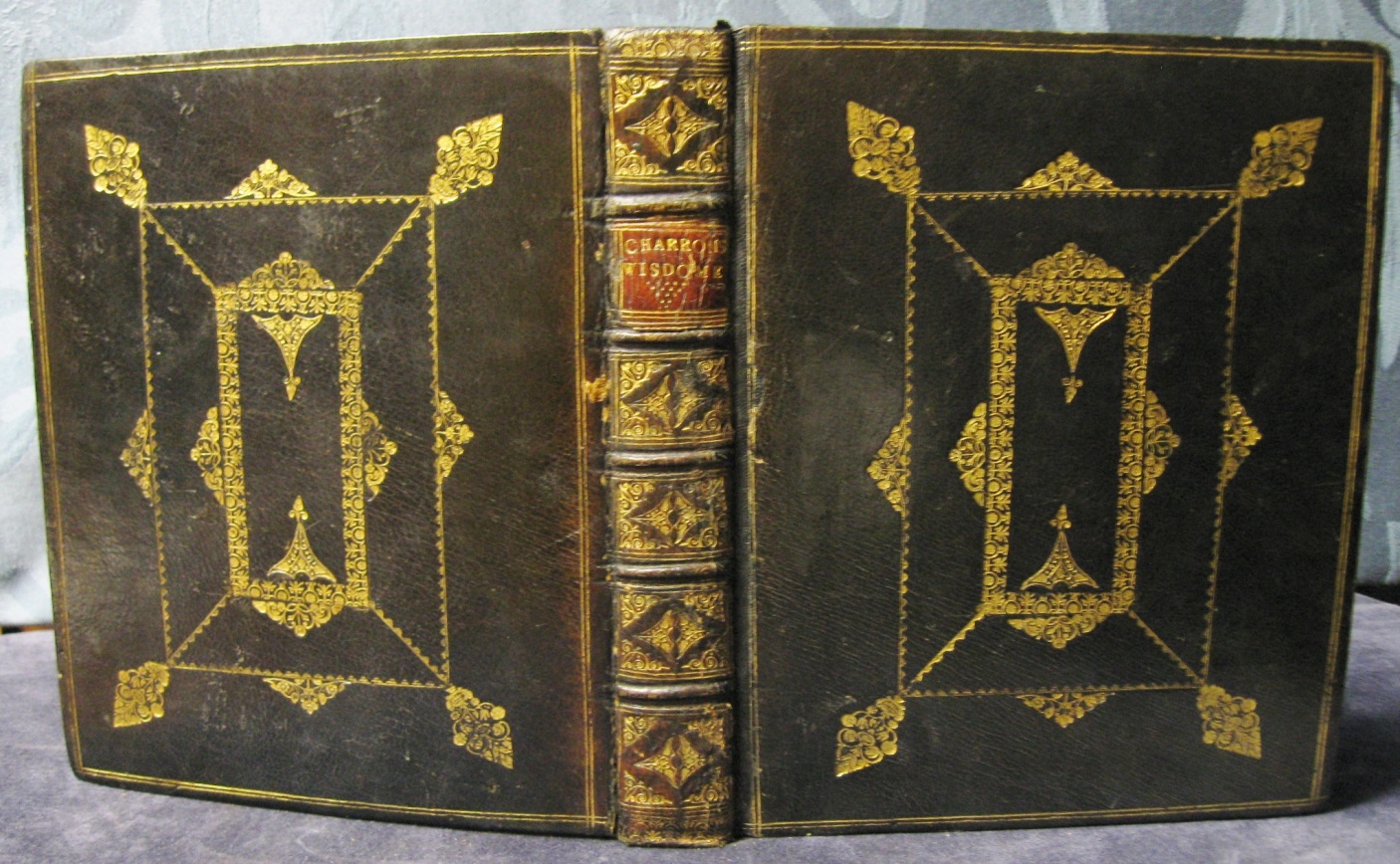
67. CHARRON, Pierre [1541-1603]. Of Wisdome Three Bookes Written In French... small 4to. pp. 14 p.l., 524, [18]index, [1 leaf]ads. engraved title. An attractive copy in full gilt-paneled black morocco, gilt back & inside dentelles, all edges gilt (front joint repaired, occasional light foxing). London: Printed for Nathaniel Ranew and Jonathan Robinson, 1670. $1,650
Eighth Edition of the English Translation by Samson Lennard (first: c1608) of Charron’s most famous treatise, in which he presents a complete popular theory of moral philosophy. De La Sagesse, first published in 1601, was “one of the first important philosophical works to be written in a modern language and to present a moral theory apart from religious considerations.” (Popkin, Encyc. of Philosophy) It “was highly influential in disseminating sceptical views and arguments into philosophical and theological discussions and played an important role in the development of modern thought, libertinism, and fideism.” (Ibid.) The sceptic philosopher and theologian Charron was the disciple and intellectual heir of Montaigne, who adopted him as his son.
Wing C3719. cfRand I p. 144.
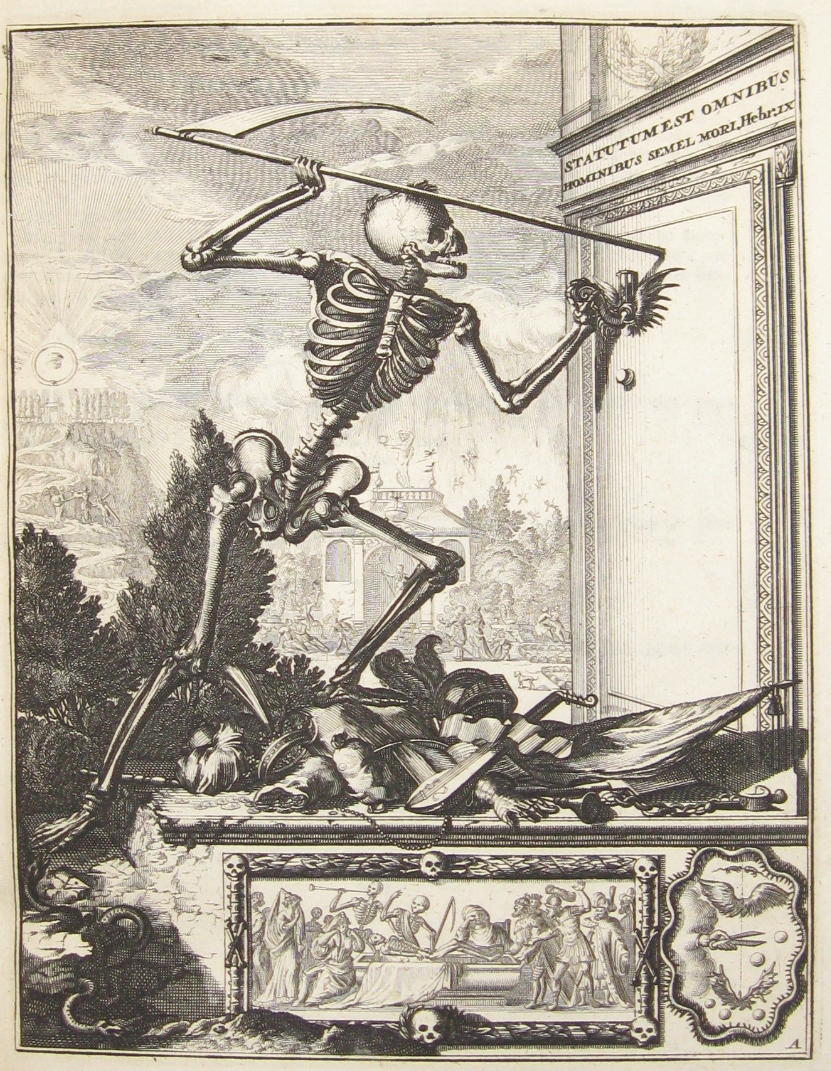
Death Bed Scenes
68. CHERTABLON, M. De. La Manière De Se Bien Préparer À La Mort Par des considerations sur la Cène, la Passion, & la Mort De Jésus-Christ... 4to. pp. 63, [1], [10 leaves of Dutch text containing the explanation of the plates). title in red & black. 42 engraved plates after designs by Romeyn De Hooghe. late 19th century quarter chagrin. Antwerp: George Gallet, 1700. $2,000
David De La Vigne'sMiroir de la Bonne Mort, with etchings by Dutch master Romeyn de Hooghe, was first published in French at Amsterdam in 1673, and then in Dutch translation. According to Landwehr, the plates in the present work and in a Dutch version of 1694, are reversed and engraved copies of the original De Hooghe illustrations. Virtually all of the engravings are death bed scenes, in which the soon to be departed is attended by priest and friends, and counseled by angels to contemplate scenes (represented in the form of oil paintings) from the last supper, passion, and death of Christ. Chertablon's religious reflections on death and his interpretations and elucidations of the spiritual significance of the engravings (pp. 63) appear here for the first time.
Brunet I 1834. Cohen-De Ricci 232-33. Goldsmith, BM STC French C873. Landwehr, Romeyn de Hooghe as Book Illustrator, 84 (apparently without the 10 leaves of Dutch text).
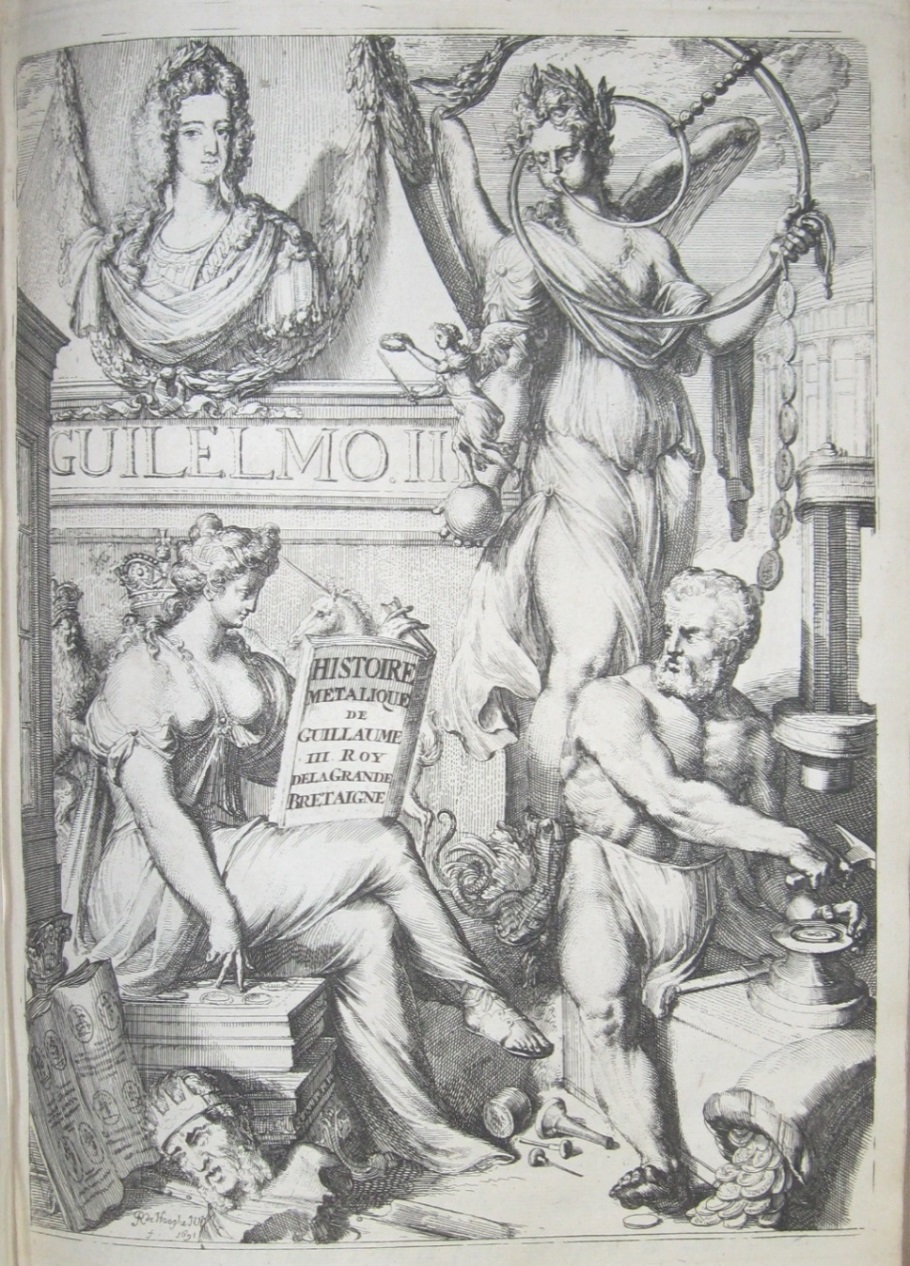
69. CHEVALIER, N[icolas] [1650-1720]. Histoire De Guillaume III. Roy D’Angleterre, D’Écosse, De France, Et D’Irlande, Prince D’Orange, &c. Contenant ses Actions les plus memorables…Par Médailles, Inscriptions, Arcs de Triomphe, & autres monumens Publics, Recueillis par N.Chevalier. folio. pp. 6 p.l. 232. etched title & 12 full-page etchings by Romeyn De Hooghe. etched title or half-title & 119 smaller etchings in the text, etched headpieces, initials & title vignette by Schoonebeek. title in red & black. 18th century sprinkled calf, rebacked (some light foxing). Amsterdam: [Marc Huguetan?], 1692. $2,400
First Edition of this handsomely illustrated work, a review of the major events and memorable accomplishments in the life of King William III of England, as recorded in numismatic and epigraphic tributes. The one hundred and nineteen etched text illustrations depict both the obverse and reverse of various commemorative medals struck in honour of the monarch. The significance of each medal with transcription is fully explained in the accompanying text by Nicolas Chevalier. In addition to the title-page, the twelve full-page etchings were executed by Dutch designer and etcher Romeyn De Hooghe. Two of these portrait William’s ceremonial procession through a triumphal arch into The Hague; the majority of the others depict various arches and monuments.
This is a variant and presumably later issue, with four preliminary leaves not mentioned in the bibliographies, comprising a Preface, Explicatio Tituli, and Privilège, recording Chevalier’s cession of privilege to Marc Huguetan.
Brunet I 1838. Graesse II 132. Landwehr, Romeyn De Hooghe as Book Illustrator, 81. Landwehr, Splendid Ceremonies, 148.
70. [COTOLENDI, Carlo]. Arliquiniana Ou Les Bons Mots, Les Histoires Plaisantes Et Agréables. Recueillies Des Conversations d’Arlequin. 12mo. pp. [42], 271, [9]table, [2]privilege. woodcut frontis. woodcut ornament & initial. contemporary sprinkled calf (extremities worn, covers bowed, scattered light foxing). Paris: Florentin & Pierre Delaulne & Michel Brunet, 1694. $300
First Edition. Witticisms and anecdotes of Domenico Biancollelli [1640-1688], who brought the Commedia dell’Arte and its most famous character, Arlecchino, to Paris in 1662. He dominated the role in France, endowing the character with even greater wit, and became a personal favourite of Louis XIV. It was Biancollelli who earned for the Italian acting troupe the right to perform in French rather than in Italian.
Barbier I 275. Brunet I 480. Cioranescu 22080. Goldsmith, BM STC French, A697.
71. (DARIEN COLONY). AN ENQUIRY Into The Causes of the Miscarriage Of The Scots Colony at Darien. Or An Answer To A Libel Entituled A Defence of the Scots Abdicating Darien. Submitted to the Consideration of the Good People of England. 8vo. pp. 4 p.l., 112. stitched, as issued. in folding cloth box. Glasgow: 1700. $1,550
First Edition. A reply to a pamphlet attacking the ill-fated Darien colony in America, written by James Hodges (Defence of the Scots Abdicating Darien, Including an Answer to the Defence of the Scots Settlement There, 1700). George Ridpath is suggested as the probable author in the Kress Library Catalogue. The writer attempts to discredit Hodges as a 'monster, renegade and traitor' and dismisses his charges against the 'Company of Scotland trading to Africa and the Indies' ('Darien Company') as malicious calumnies. In turn, he attributes the failure of the colony to the commercial jealousy and opposition of the English Crown, which from the outset sought to ruin the venture, threatening legal action against the directors of the company, prohibiting the subscription of English capital, actively hindering German and Dutch subscriptions, and forbidding the English colonies in America to afford any manner of assistance to the Scots at Darien.
Wing I213. Scott, Bibliography of the Darien Company, 104. Bell E90. Goldsmiths' 3654. Kress 2220. Sabin 18552. Winsor VIII p. 266.
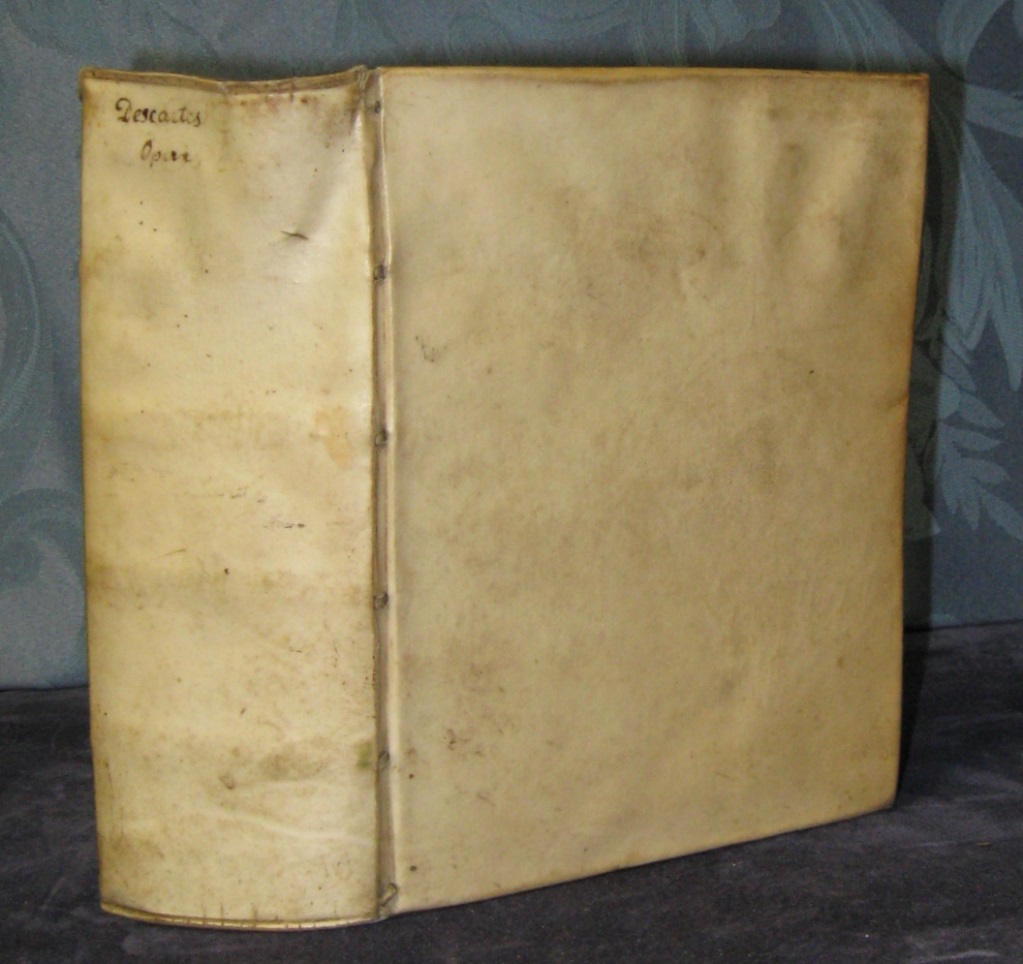
72. DESCARTES, René [1596-1650]. Opera Philosophiae. Editio Ultima, nunc demum hac Editione diligenter recognita, & mendis expurgata. [General Title]. 5 Parts in 1. 4to. pp. 22 p.l.(the last blank), 222, [blank leaf]; [8 leaves], 248; [12 leaves], 92, [4]; [8 leaves – the last blank], 191; 164, 88. engraved frontis. portrait. numerous woodcuts in the text. woodcut device on titles. woodcut ornaments & initials. contemporary vellum. Amsterdam: Blaeu, 1685. $3,000
Seventh Edition. Descartes’ philosophical works, comprising: Principia Philosophiae; Specimena Philosophiae: Seu Dissertatio De Methodo…Dioptrice, Et Meteora…; Passiones Animae…; Meditationes De Prima Philosophia…; and Appendice Continens Obiectiones Quintas & Septimas In Renati Descartes Meditationes De Prima Philosophia… by Gisbert Voet, which contains Descartes’ Epistola…Ad celeberrimum Virum D. Gisbertum Voetium…
“It is no exaggeration to say that Descartes was the first of modern philosophers and one of the first modern scientists; in both branches of learning his influence has been vast…The revolution he caused can be most easily found in his reassertion of the principle (lost in the Middle Ages) that knowledge, if it is to have any value, must be intelligence and not erudition. His application of modern arithmetic to ancient geometry created the analytical geometry which is the basis of the post-Euclidean development of that science. His statement of the elementary laws of matter and movement in the physical universe, the theory of vortices, and many other speculations threw light on every branch of science from optics to biology…”. (Printing and the Mind of Man)
Guibert p. 232. cfBrunet II 609. cfPrinting and the Mind of Man 129. cfQuérard II 497. cfRand I 173.
73. DESCARTES, René [1596-1650]. Les Passions De L’Âme. 12mo. pp. xlviii, 282. woodcut ornaments, initials & title vignette. contemporary calf, gilt back (head of spine worn). Paris: Théodore Girard, 1679. $750
Later edition ofDescartes’ exposition of the causal relations between mind (soul) and body. “Descartes believed the soul [which he situated in the pineal gland] to be a definite entity, giving rise to thoughts, feelings, and acts of volition. He was one of the first to regard the brain as an organ integrating the functions of mind and body.” (Garrison & Morton)
Guibert pp. 168-69. cfBrunet II 611. cfCioranescu 23946. cfGarrison & Morton 4965. cfGraesse II 364. cfHunter & Macalpine pp. 133-34. cfRand I p. 174. cfTchemerzine IV 302. cfWellcome II p. 453.
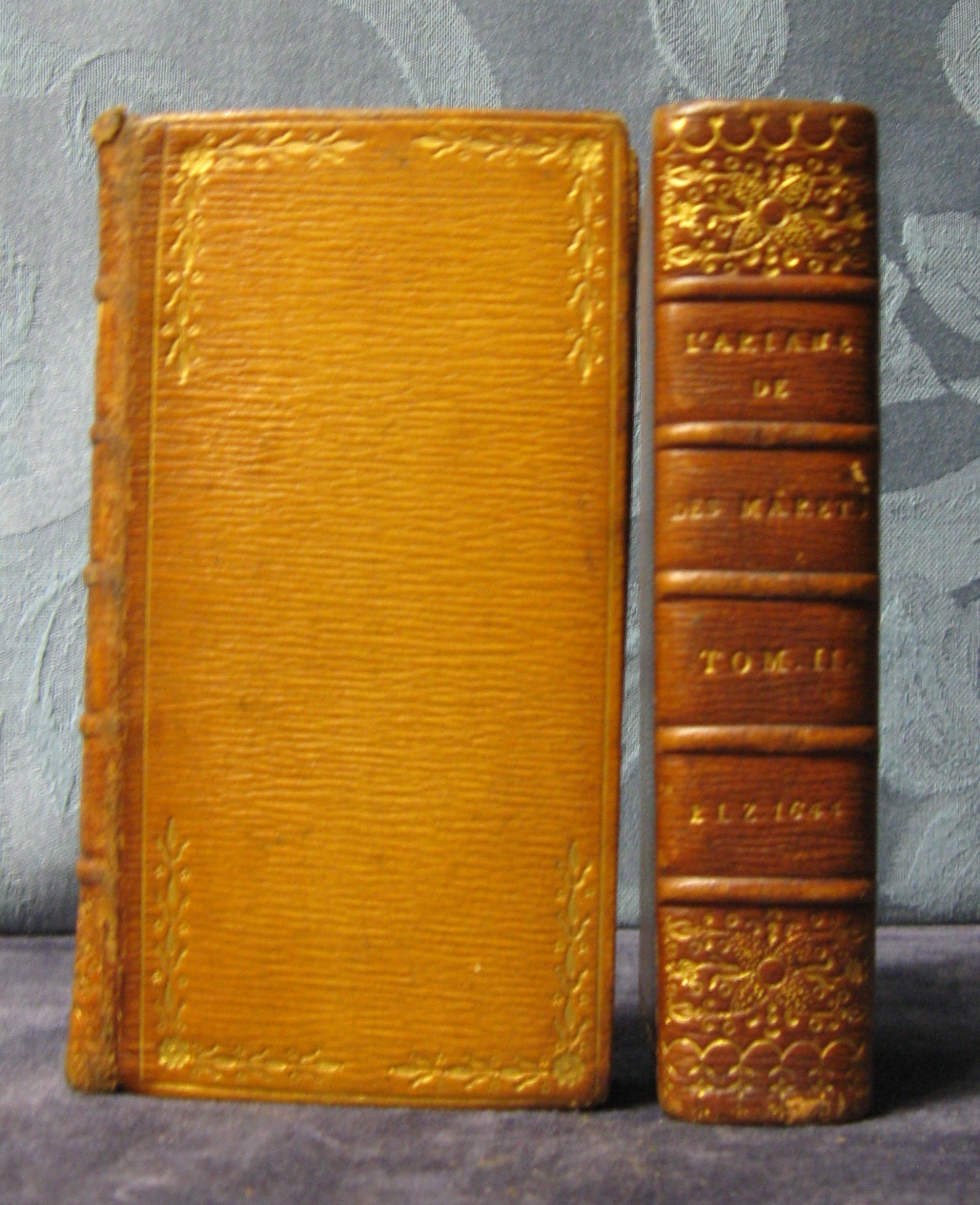
74. DESMARETS [DE SAINT-SORLIN, Jean] [1595-1676]. L’Ariane…De nouveau reveue, & augmentée de plusieurs Histoires par l’Autheur. 2 Parts in 2 Volumes. 12mo. pp. 6 p.l., 488; 565. additional engraved title & 16 full-page engravings. woodcut printer’s device on title. woodcut ornaments & initials. A pretty copy in 19th century English gilt-tooled straight-grained morocco, gilt backs, all edges gilt (little rubbed). ownership entry of scholar and book collector Henry Joseph Thomas Drury [1778-1841], who numbered Byron among his pupils at Harrow. Leyden: François de Hegher, 1644. $600
One of only two novels written by Desmarets, who is best known for his poetry, plays, and religious writings (he was a violent opponent of the Jansenists). Desmarets was a founding member and first chancellor of the Académie Française, and was appointed conseiller du roi, contrôleur-général de l'extraordinaire des guerres, and secretary-general of the fleet of the Levant. It was Desmarets who initiated the lengthy literary battle known as the ‘Querelle des Anciens and des Modernes’ by declaring that the true models for modern French literature were Romance legends and the Bible rather than classical Greek and Roman authors.
Berghman 1170. Brunet II 633. Goldsmith, BM STC French, D481. Graesse II 370. Rahir 1939. Tchemerzine IV 327n. Willems 1631. cfCioranescu 25661.
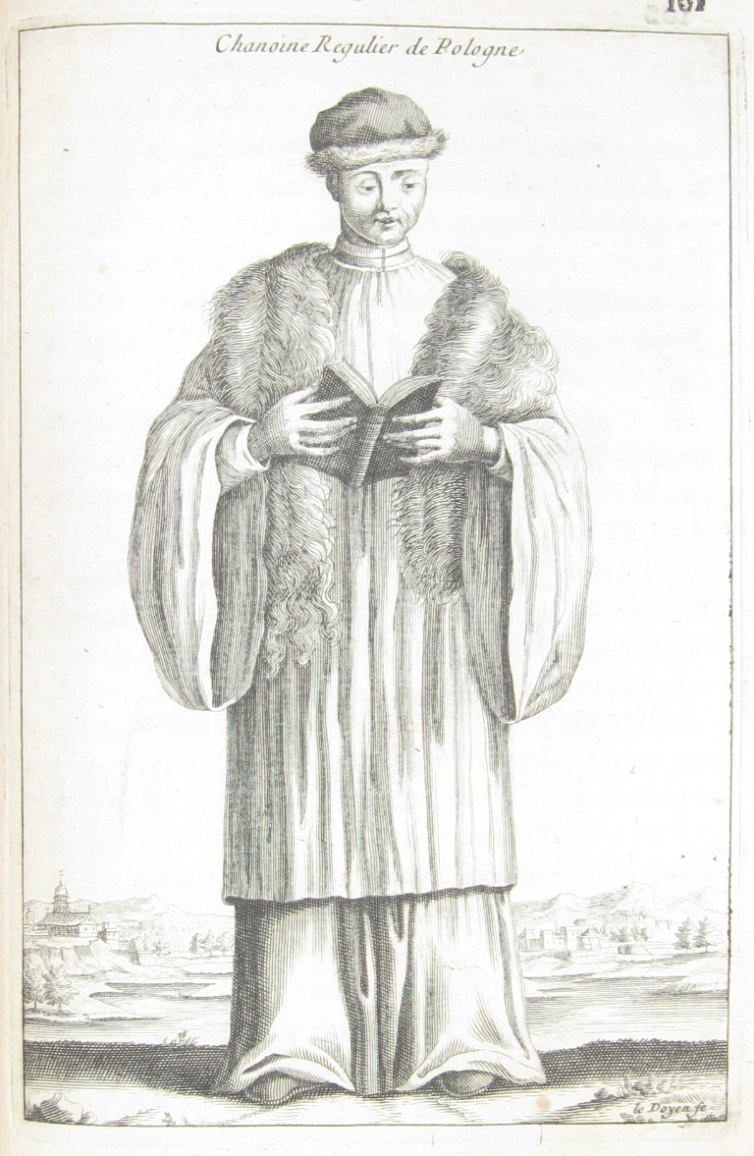
75. DU MOLINET, C[laude] [1620-1687]. Figures Des Différents Habits Des Chanoines Reguliers En Ce Siècle. Avec un discours sur les habits anciens et modernes des chanoines tant Seculiers, que Reguliers. 4to. pp. 4 p.l., 144 [i.e. 148], [3]. engraved title & 31 engraved plates (incl. in pagination) by Le Doyen. engraved head & tailpiece & initial. paste-over cancel on p. 31. contemporary sprinkled calf, gilt back (corners & head of spine worn, some light browning & marginal staining). Paris: Simeon Piget, 1666. $2,500
First Edition of this illustrated work on ecclesiastical costume. Although largely devoted to the religious orders of France, it also includes orders from Italy, Portugal, Poland, Austria and Germany.
Lipperheide 1856. Colas 911. Graesse IV 569.
76. [FERMANEL DE FAVERY, Luc]. Relation Des Missions Des Évêques François Aux Royaumes De Siam, de la Cochinchine, de Camboye, & du Tonkin… 8vo. pp. 8 p.l., 367, [1]privilege. woodcut printer’s device on title. woodcut ornaments & initials. contemporary calf, gilt back (corners worn, spine ends chipped, front joint cracked but firm, last leaves with light stain & small wormtrack affecting some letters). Paris: Pierre Le Petit, Edme Couterot, Charles Angot, 1674. $1,800
First Edition. Scarce account of the early activities of the Missions Étrangères in Siam, Cochin-China, Cambodia and Vietnam. The Society of Foreign Missions of Paris was established in 1658-63, its chief founders being Mgr. François Pallu, Bishop of Heliopolis, Vicar Apostolic of Tongking, and Mgr. Pierre Lambert de la Motte, Bishop of Bertyus, Vicar Apostolic of Conchin-China.
Cordier, Sinica, 826 (no author attribution). cfBell F44 (Italian translation).
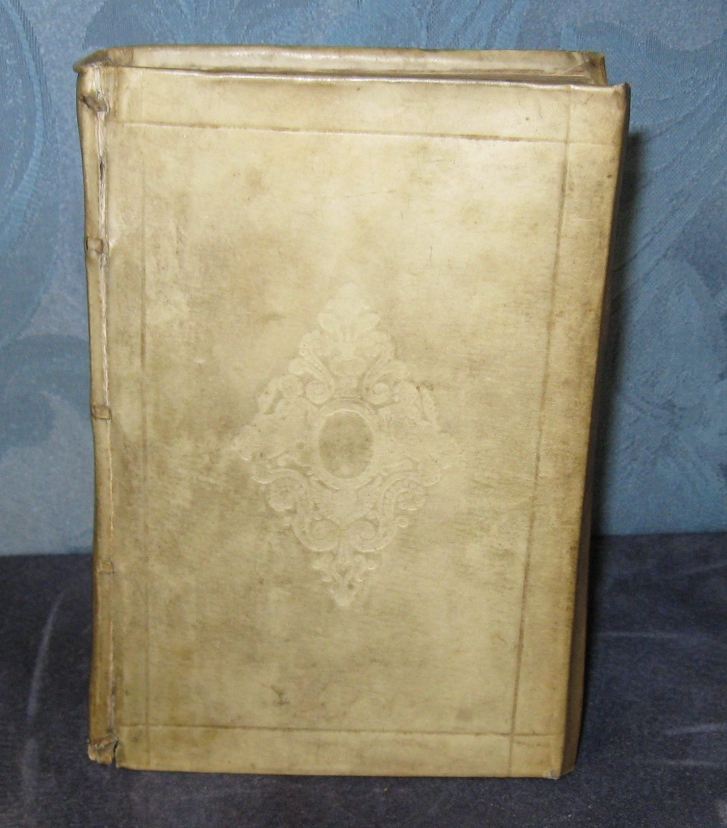
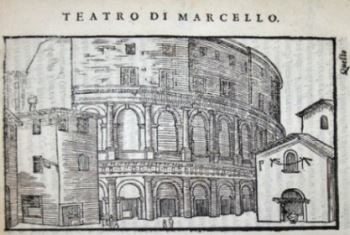
77. GAMUCCI, Bernardo. Le Antichità Della Città Di Roma. 8vo. ff. 192. numerous full-page woodcuts. woodcut initials. 17th century blind-tooled vellum, overlapping fore-edges (front joint split, lower portion of title with imprint supplied). Venice: Gio. Battista Ciotti, 1615. [Colophon: Venice: Giovanni Varisco & compagni, 1588]. $2,000
Reissue of the Second Edition Edited by Tommaso Porchacchi of this popular Roman guide book. The rather simple woodcuts depict the ancient architectural monuments of the city. This is an unusual copy, the lower half of the title being neatly supplied before binding, suggesting that Ciotti may have bought copies of the book from Varisco to distribute under his own imprint.
See BM STC Italian p. 290.
78. GOMBAULD, [Jean Ogier De] [c1570-1666]. Les Poésies. 4to. pp. 4 p.l., 304, [3]table. engraved printer’s device by J.Picart. woodcut ornaments & initials. contemporary sprinkled calf (slight staining to covers, short splits in joints, corners worn, light foxing to outer leaves). Paris: Augustin Courbé, 1646. $1,200
First Edition. “Of French Huguenot origin, [Gombauld] was a minor favourite of Queen Marie de Médicis, who gave him a pension. As a friend of Conrart he belonged to the founding nucleus of the Académie Française, and helped to compile its statutes. He was also a friend of Malherbe, whose mantle as literary and linguistic censor he to some extent inherited. His poetry, first collected and published in 1646, is appropriately meticulous, but the result is frigid...” (New Oxford Companion to Literature in French)
Brunet II 1656. Cioranescu 33516. Goldsmith, BM STC French, G534. Graesse III 114. Picot 828. Tchemerzine V 439.
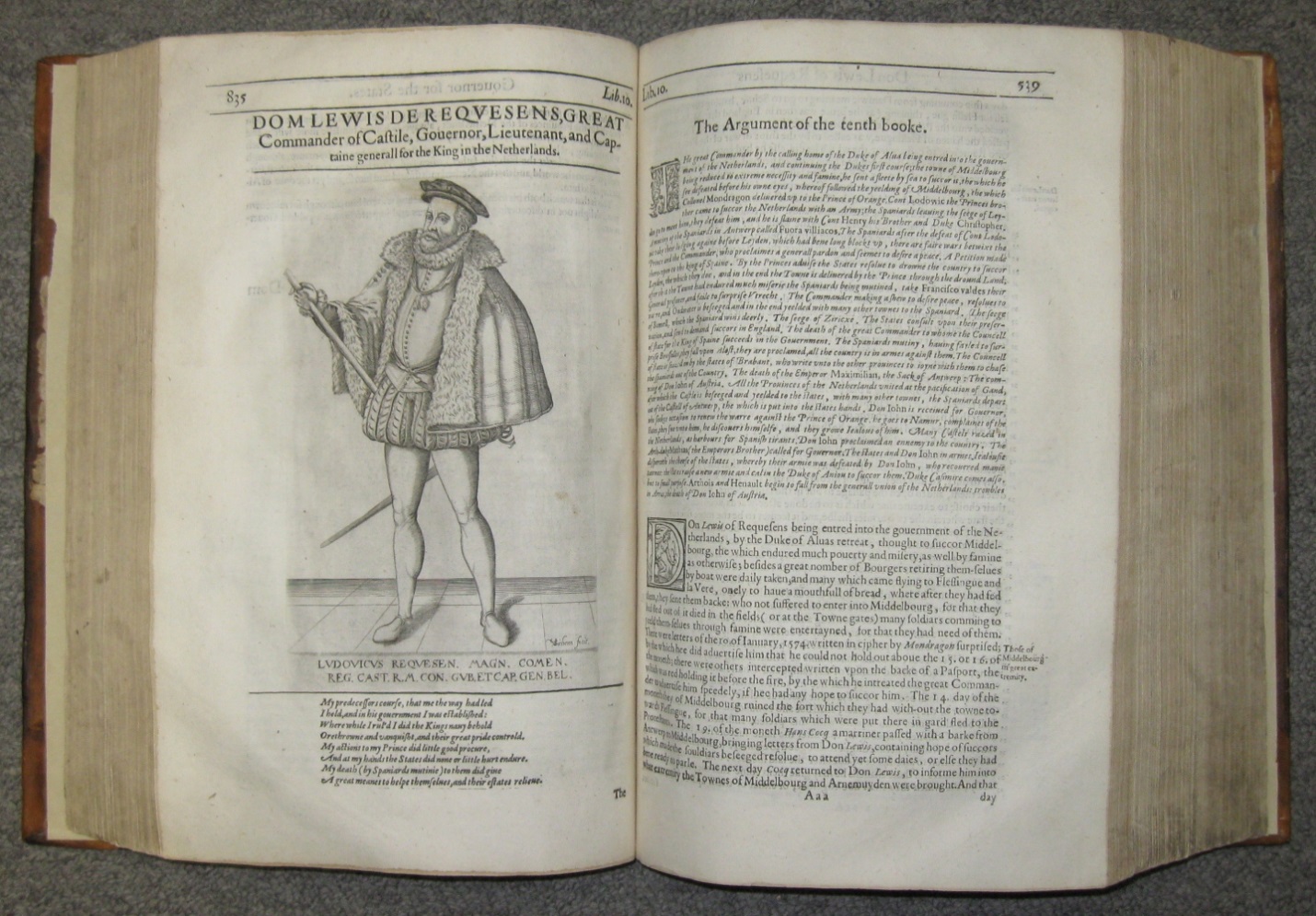
79. GRIMESTON, Edward [d. 1640]. A General Historie Of The Netherlands. Wih the genealogie and memorable acts of the Earls of Holland, Zeeland, and west Friseland… folio. pp. 13 p.l., 1415 [i.e. 1403], [17]index & errata (last page misnumbered & pp. 300-309 omitted in pagination). engraved title border & 57 full-length portrait engravings in the text by Christoffel von Sichem. woodcut ornaments & initials. A nice copy in contemporary calf, gilt arabesque ornament on centre of covers, rebacked, corners renewed (title backed, occasional marginal stains). early ownership entries of John Lamott Honeywood [1647-1694], A. Garway (dated 1616), and Powle Garway. London: Printed by A.Islip, and G.Eld, 1608. $3,000
First Edition, First Issue. The work is largely a translation from J. F. Le Petit, La grande chronique ancienne et moderne (Dordrecht: 1601), and utilizes the same plates by Christoffel von Sichem for the engraved title border and engraved portraits. Grimeston includes a translation of Le Petit’s preface and indicates that most of the continuation is derived from Emanuel van Meteren. This is one of several large and influential European histories which Gimeston translated or derived from foreign sources, the others devoted to France, Spain, and Venice.
STC 12374.
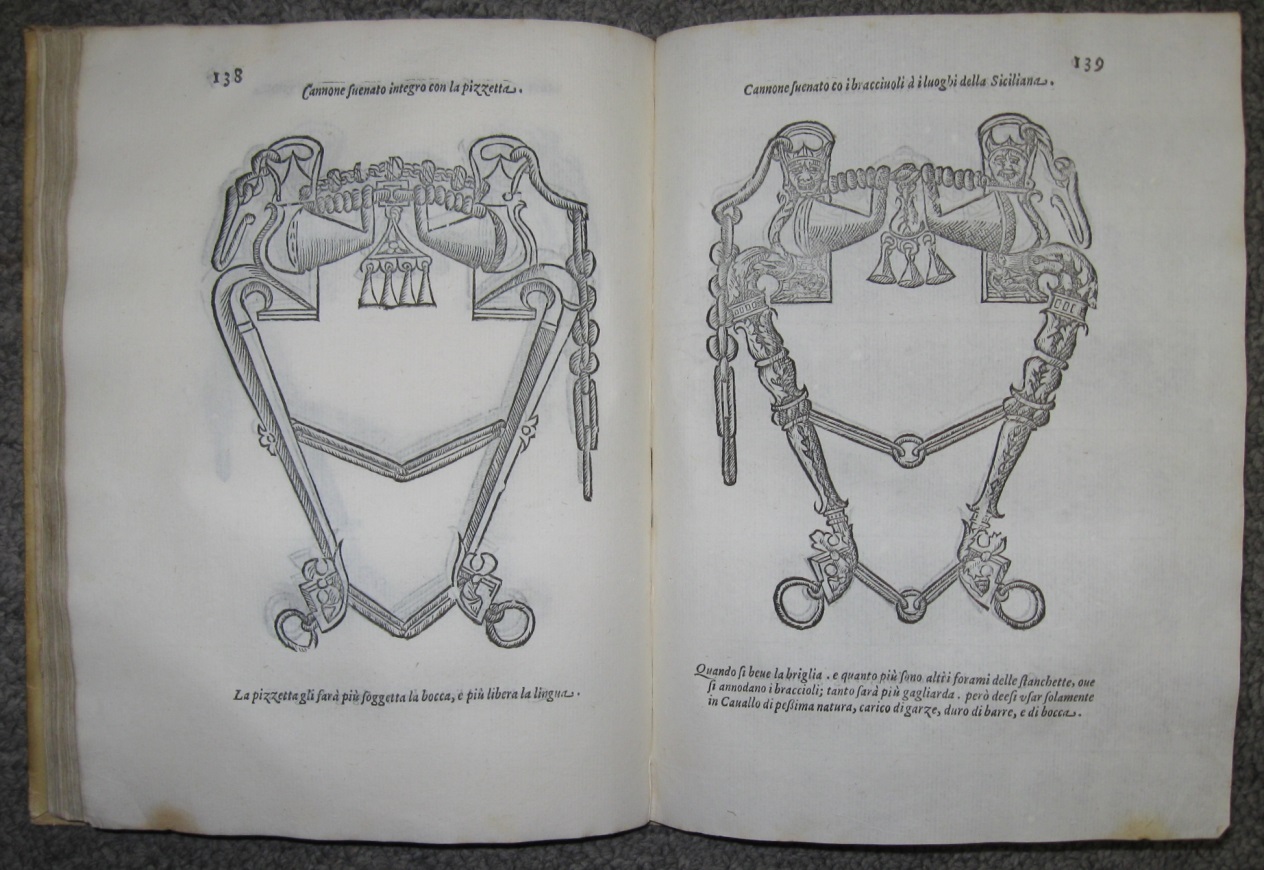
80. GRISONE, Federico. Ordini Di Cavalcare, Et Modi Di Conoscere Le Nature De Cavalli… 2 Parts in 1. 4to. pp. 6 p.l., 163, [1]; 70, [blank leaf], [11]. 51 full-page text woodcuts & 2 diagrams. woodcut ornaments & initials. woodcut printer’s device on titles. contemporary limp vellum (paste-downs defective, marginal repairs to title). Venice: Andreas Muschio, 1610. $1,900
One of the major early works on horses and horsemanship written by a Neapolitan nobleman and master horseman who operated his own academy. It was first published in 1550. The second part deals with equine anatomy, common maladies afflicting the horse, their proper treatment and cure, and is illustrated with a full-page woodcut. The other fifty full-page cuts in the text depict different kinds of bridles.
Graesse III 160. Huth p. 7. cfBrunet II 1759. cfPodeschi 7.
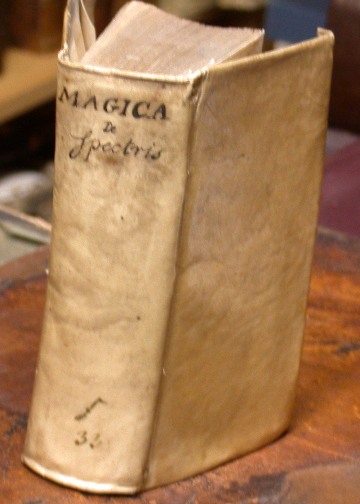
Magical 'Precedent Cases'
81. [GROSSE, Henning] (Editor).Magica De Spectris Et Apparitionibus Spiritum, De Vaticiniis, Divinationibus, &c. 16mo. pp. 12 p.l.(incl. engraved title), 536, [33]. woodcut ornaments & initials. contemporary vellum, overlapping fore-edges (title stained, with institutional rubberstamp in lower margin). Leyden: Franciscus Hackius, 1656. $1,800
Second Edition (first: 1597) of this intesting comilation on apparitions and demons. "Grosse's Magica is an exceedingly extensive and learned compilation of magical 'precedent cases', and his sources extend from Homer to Petrarch, Luther and Melanchthon. He seems to be mainly interested in showing that demons are essentially swindlers who, although really of a satanic nature, pretend to be angels in order to entice ignorant, unsuspecting, and credulous people into Satan's net." (Faber du Faur) "C'est, avec celui de Lavater, l'ouvrage le plus complet sur les spectres et les revenants." (Dorbon) This important work was apparently overlooked by Thorndike. Grosse drew his material from a variety of sources, a listing of which is given following the dedicatory epistle. Caillet remarks that this edition is attractive and relatively rare.
Caillet II 4788. Dorbon, Biblioteca Esoterica, 1995. Willems 1689. cfFaber du Faur 1249.
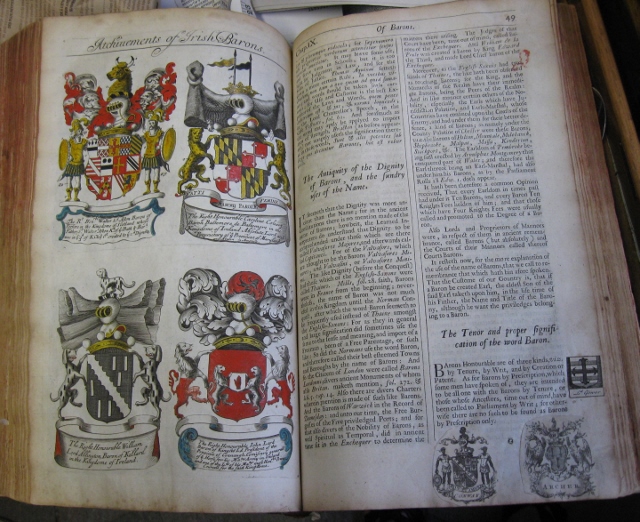
Grangerized Copy
82. GUILLIM, John [1565-1621]. A Display Of Heraldry…To which is added a Treatise of Honour Military and Civil, According to the Laws and Customs of England, collected out of the most Authentick Authors, both Ancient and Modern, by Capt. John Logan… 2 Volumes in 1. folio. pp. 10 p.l., 317, [2]; 159, [1 leaf], 161-181, [1]blank, [8]index. lacking pp. 283-84 of the Display (divisional title to Part VI) & pp. 17-18 of the Analogia Honorum. title in red & black. text in double columns. engraved frontis. by Richard Blome, 16 engraved portraits by R.White, A. Bloteling, &c. (Lowndes calls for 15), & 107 engraved plates of coats of arms (counting double-sided plates as 2). numerous woodcut arms & heraldic devices in the text, many with old hand-colouring. 1 engraved headpiece. woodcut ornaments & initials. a heavily grangerized copy with numerous engraved coats of arms & heraldic devices mounted in the text in the margin & in the text, sometimes over the original text & cuts. 19th century diced calf, rebacked & recornered (some wear to covers, besides the 2 missing leaves & the covered over engravings in the text there are also a number of cutouts with loss of text &/or illustrations, few marginal repairs, occasional stains & foxing). armorial bookplate on verso of title of Sir John Ligonier, 1st Earl Ligonier [1680-1770], French-born British officer, a leading official of the Pitt-Newcastle Ministry and Commander-in-Chief of the British land forces during the Seven Years’ War. old ownership entry of Horatio Heard. London: Printed by S.Roycroft for R.Blome; and are sold by Francis Tyton, Henry Brome, Thomas Basset, Richard Chiswell, John Wright, and Thomas Sawbridge, 1679. $3,000
Seventh Revised and Enlarged Edition (called Fifth Edition on title), the first edition to incorporate the Analogia Honorum.The author was an English antiquarian and officer of arms at the College of Arms in London. This, his major work, was first published in 1610 and went through seven further editions by 1724. It is regarded as the first systematization and illustration of the whole science of heraldry. Some historians have attributed the Display to a clergyman named John Barkham while the Analogia Honorum is said to have been written by Richard Blome.
Wing G2222 (incorporating L2834).
83. HALE, Matthew [1609-1676]. The Primitive Origination Of Mankind, Considered And Examined According to The Light Of Nature. folio. pp. 5 p.l., 380. engraved frontis. portrait of Hale by Van Houe. woodcut title vignette. contemporary calf, rebacked (frontis. trimmed & mounted, dampstain to lower inner portion of frontis.). Moore armorial bookplate. London: Printed by William Godbid, for William Shrowsbery, 1677. $1,400
First Edition. Hale devoted much of his leisure time to scientific and philosophical concerns. The Origination was written over a period of years when Hale was lord chief baron of the exchequer, but the work was not published until a year after his death. In it Hale defends the Mosaic account of the single origin of all peoples in response to Isaac de la Peyrere’s writings advocating the theory of polygenesis, modifying the account in light of the discovery of America. The work includes passages relating to the geography, wild life and native races of the Americas as well as discussion of the Greek philosophers and the scientific discoveries of Copernicus, Harvey, and others.
Anticipating Malthus, Hale seems to be the first to use the expression “geometrical proportion” for the growth of population from a single family, especially insects; various natural calamities reduce the numbers to low levels intermittently, so maintaining a balance of nature. This is the earliest work relating to evolution cited by Garrison and Morton. Hunter and MacAlpine quote from it for Hale’s humanist approach to psychiatry.
Wing H258. McAlpin III 748. Alden 677/101. JCB II 1677. Garrison & Morton 215. Hunter & MacAlpine p. 204.
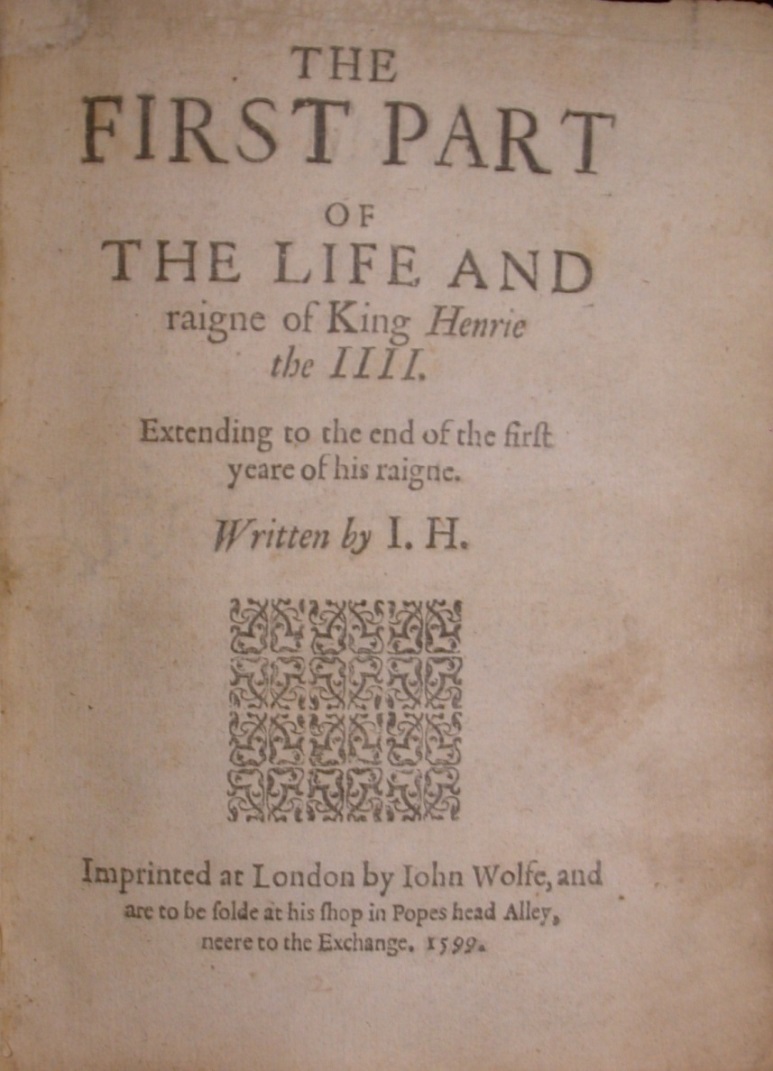
84. [HAYWARD, Sir John] [1564?-1627]. The First Part Of The Life And raigne of King Henrie the IIII. Extending to the end of the first year of his raigne. Written by I.H. small 4to. pp. 4 p.l., 149, [1], [blank leaf]. woodcut headpiece & initials. full morocco (c1900) (bit rubbed, some light staining). London: Imprinted by John Wolfe, 1599 [i.e. Bernard Alsop and T.Fawcett, 1629?]. $1,600
Third Edition. Hayward was imprisoned by Queen Elizabeth, 1599-1601, for publishing the present work, which he had dedicated to Essex. According to Pforzheimer, Elizabeth was apparently only dissuaded from hanging Hayward by Bacon’s comment, after reading the book, that the author was not guilty of treason but only of felony since he had stolen the better part from Tacitus. Following the accession of James I, Hayward secured a large practice in the court of arches, and in 1610 was named historiographer of the newly founded Chelsea College.
STC 12997. Grolier, Wither to Prior, 431n. Pforzheimer 458.
85. [HAYWARD, Sir John] [1564?-1627]. The Lives Of The III. Normans, Kings Of England: William the first. William the second. Henrie the first. small 4to. pp. 4 p.l., 314. [i.e. 306; pp. 33-40 omitted in pagination]. woodcut ornaments & initials. 18th century mottled calf, rebacked (some wear to covers, title lightly soiled). armorial bookplate of Algernon Capell, Earl of Essex, Viscount Malden & Baron Capell of Hadham, dated 1701 on vero of title. London: Imprinted By R.B[arker], 1613. $1,350
First Edition. Hayward had previously been imprisoned by Queen Elizabeth, 1599-1601, for publishing First Part of the Life and Raigne of Henrie the IIII, which he had dedicated to Essex. Following the accession of James I, he secured a large practice in the court of arches, and in 1610 was named historiographer of the newly founded Chelsea College. The present work was written at the suggestion of Prince Henry and is dedicated to Charles, Prince of Wales.
STC 13000. Grolier, Wither to Prior, 432. Pforzheimer 460.
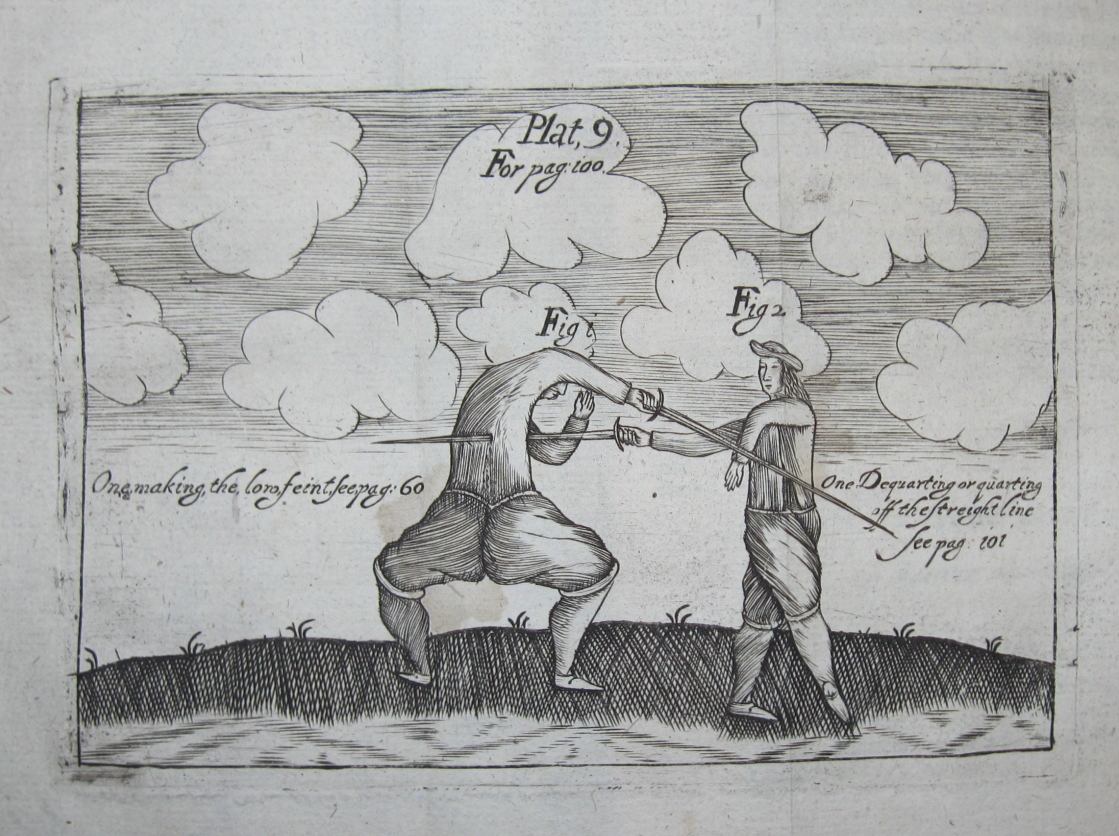
Early English Fencing Manual
86. HOPE, W[illiam]. The Compleat Fencing-Master: In which is fully Described the whole Guards, Parades and Lessons, Belonging to the Small-sword…Second Edition. 8vo. pp. 11 p.l., 197 [i.e. 167], [17]. 12 folding engraved plates. contemporary calf (small surface abrasions on rear cover, title fore-margin cut into with loss of a letter on 4 lines & 2 letters on 1 line of imprint, light dampstain to lower outer corner of some leaves & plates, but overall a very good copy). London: Printed for Dorman Newman, 1692. $8,500
Second Edition, a reissue of the first of 1691 with cancel title, of this early English fencing manual. Apparently the text is essentially the same as the author’sope’st The Scots Fencing-Master which was published at Edinburgh in 1687. Hope’s work was a basic instructional guide to Small-sword fencing in the new French style, which had replaced the former Rapier or Italian technique. The rapier, which was wide and heavy, was replaced about 1550 by the very thin and light small-sword. This resulted in more reliance on thrusts as opposed to edge-blows, creating a back and forth motion and emphasizing the importance of speed. This is essentially the technique of modern fencing. The charming plates illustrate various positions.
Wing H2712. Thimm p. 86.
87. HUME, David [1560?-1630?].The History Of The Houses Of Douglas And Angus. 2 Volumes in 1, with continuous pagination. folio. pp. 9 p.l., 211, [1]blank; [203]-440. several woodcut initials. contemporary calf, artlessly rebacked (lacking front paste-down, title soiled, marginal repairs to 3 prelims with loss of part of ornament at head of second leaf, light dampstain to upper inner corner in first gatherings, a few sidenotes shaved). single leaf (poem) from another copy/edition or a different source inserted after title (the bottom third of which, presumably blank, is wanting). Edinburgh: Printed by Evan Tyler, 1644-43. $1,500
Second Edition. An “imposing family history” (DNB), beginning with Sholto Douglas, conqueror of Donald Bane, and concluding with Archibald Douglas, eighth earl of Angus [1555-1588], for whose life in particular it remains an important source of information. Hume had served for a time as the eighth earl’s private secretary. “…legendary in some respects.” (Encyc. Brit., 11th Edn.)
Aldis 1141.Wing H3658.
88. JACKSON, Thomas [1579-1640]. A Treatise Of The Consecration Of The Sonne Of God to his everlasting Priesthood. And The Accomplishment of it by his glorious Resurrection and Ascention. Being The Ninth Book of Commentaries upon the Apostles Creed. Continued By… small 4to. pp. 12 p.l., [355]. woodcut headpiece & initials. contemporary paneled calf (worn, joints cracked, spine ends chipped, lacking front free-endpaper, some foxing & browning, light dampstaining to some leaves). Oxford: Printed by Leonard Lichefield, 1638. $1,200
[BOUND WITH:] JACKSON, Thomas. The Knowledge Of Christ Jesus. Or The Seventh Book Of Commentaries Upon The Apostles Creed: Containing The first and generall Principles of Christian Theologie…Continued By… small 4to. pp. 6 p.l., 441, [2]. woodcut headpiece & initials. (some foxing & browning, light dampstaining to some leaves). London: Printed by M. F. for John Clarke, 1634.
First Editions. Jackson was president of Corpus Christi College, Oxford from 1630 to 1640. He was a syncretic Platonist and a strong opponent of the Catholic doctrine of transubstantiation and the views of John Calvin, particularly the doctrine of predestination. His chief work, Commentaries on the Apostles’ Creed, was designed to fill twelve books, nine of which were published in separate volumes during his lifetime. “[Jackson’s] theological works rank high. His views were at first decidedly puritanical, but they changed under the influence of Neile and Laud, and he ultimately incurred the wrath of the Presbyterians, and especially of Prynne, who attacked him in Anti-Arminianism and Canterburie’s Doom…Southey described him as ‘the most valuable of our English divines,’ and insisted on the soundness of his philosophy and the strength of his faith…His theology powerfully commended itself to modern high church divines, as recent reprints abundantly prove. Pusey asserted that his was ‘one of the best and greatest minds our church has nurtured.’” (DNB)
STC 14317 14313.
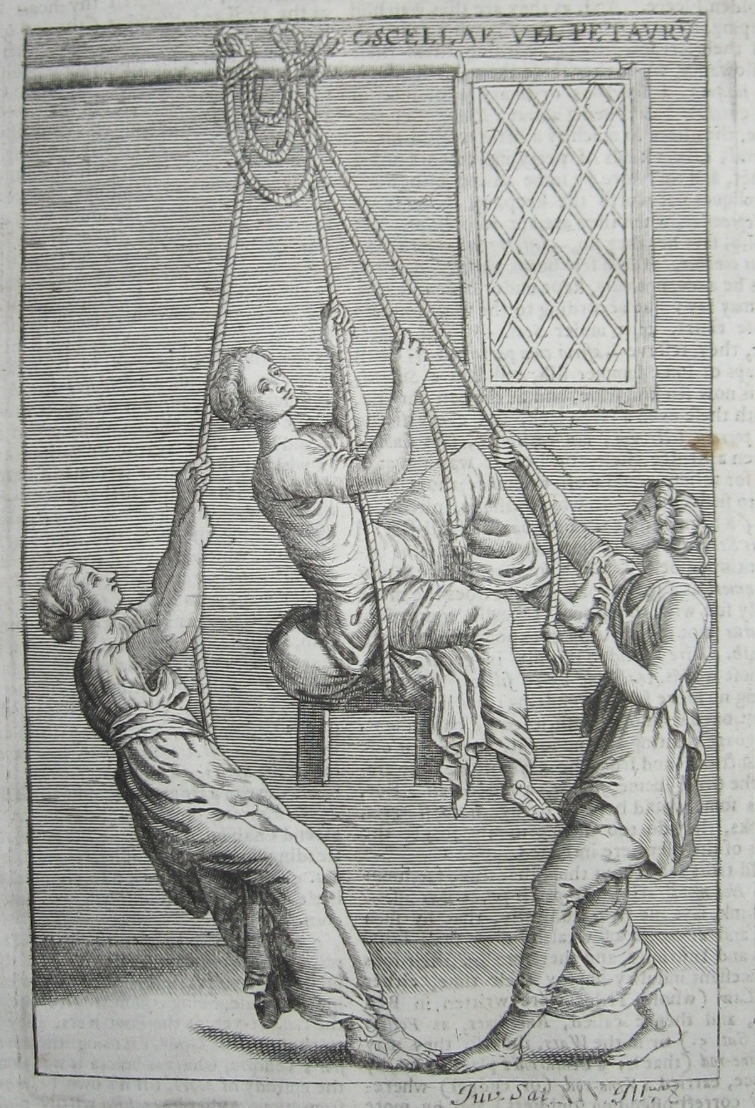
89. JUVENALIS, Decimus Junius & Aulus PERSIUS FLACCUS. Decimus Junius Juvenalis And Aulus Persius Flaccus Translated And Illustrated As well with Sculpture as Notes. By Barten Holyday. [the Satires of Perseus with separate title]. folio. pp. 6 p.l., 341. without the last leaf containing the longitudinal title, as usual. first title in red & black. 4 engraved plates (incl. 1 map, 1 folding, & 1 of a manual counting system) & 48 engravings & woodcuts in the text (incl. 1 map). woodcut title vignettes. 19th century half calf (rubbed, 2 plates shaved at upper & lower edges, 1 text illus. shaved at outer edge, dampstain to outer margin in first gatherings, occasional stains). Oxford: Printed by W.Downing, for F.Oxlad Senior, J.Adams, and F.Oxlad Junior, 1673. $900
First Edition of the English Translation, with extensive commentary, by Barten Holyday of the satires of Juvenal, incorporating the fourth edition of Holyday’s translation with commentary of the satires of Persius Flaccus. This is also the first English translation to be illustrated, most of the engravings being the work of David Loggan.Prefixed are testimonials by scholars Thomas Farnaby and John Selden.Holyday [1593-1661] was chaplain to Sir Francis Steuart and afterwards to Charles I. Before 1626 he became archdeacon of Oxford, and in 1642 was created D.D.
“A translation noted for ‘rigid fidelity’. Holyday was ‘a writer of great learning, and even of critical acuteness, as the excellent commentary on the author fully shews.’ – Tytler. Dryden observes, Holyday’s ‘interpretation and illustrations of Juvenal are as excellent as the verse of his translation and his English are lame and pitiful.’ ‘The most literal translation; and certainly the most learned notes are contained in this volume of all the translations of these caustic authors.’ - Heath.” (Lowndes)
Juvenal inspired many authors including Samuel Johnson, who modeled his ‘London’ on Satire III and his ‘The Vanity of Human Wishes’ on Satire X. He is also the source of many well-known maxims, including that men should pray for ‘mens sana in corpore sano’ rather than wealth, power or children, that a perfect wife is a ‘rare bird’ (‘rara avis in terres nigroque simillima cycno’), and that power corrupts (‘quis custodiet ipsos custodes’).
Brueggemann pp. 659-60 & 680. Wing J1276. Madan 2927.
90. [LA BRUYÈRE, Jean De] [1645-1696]. Les Caractères De Théophraste Traduits Du Grec, Avec Les Caractères Ou Les Moeurs De Ce Siècle. Huitième Édition, Reveuë, corrigée & augmentée. 12mo. pp. 16 p.l., 716, xliv, [8]table & privilege. title in red & black with woodcut vignette. engraved portrait. woodcut ornaments & initials. 19th century quarter calf, gilt back (scattered light foxing, repaired tears in Cc7-8 with no loss of text). Paris: Estienne Michallet, 1694. $1,250
Eighth Enlarged Edition: the first complete edition of the text, containing a total of 1120 characters, 46 more than the previous edition. Also included here for the first time is La Bruyère’s discourse of admission to the Académie Française’ in 1693, preceded by an apologetic preface. This is the second issue, with corrected text and the added portrait of Theophrastus.
La Bruyère’s scarcely veiled sarcastic portraits of his contemporaries brought him many readers and many enemies. “The short paragraphs of which his chapters consist are made up of maxims proper, of criticisms literary and ethical, and above all of the celebrated sketches of individuals baptized with names taken from the plays and romances of the time. These last are the great feature of the work, and that which gave it its immediate if not its enduring popularity. They are wonderfully piquant, extraordinarily life-like in a certain sense, and must have given great pleasure or more frequently exquisite pain to the originals, who were in many cases unmistakable and in most recognizable…His abundant wit and his personal “malice” have done much to give him his rank in French literature, but much must also be allowed to his purely literary merits. With Racine and Massillon he is probably the very best writer of what is somewhat arbitrarily styled classical French.” (Encyc. Britann., 11th Edn.)
Brunet III 720. Cioranescu 37514. Goldsmith, BM STC French, T275 [vide THEOPHRASTUS]. Tchemerzine VI 322-24. cfQuérard IV 381.
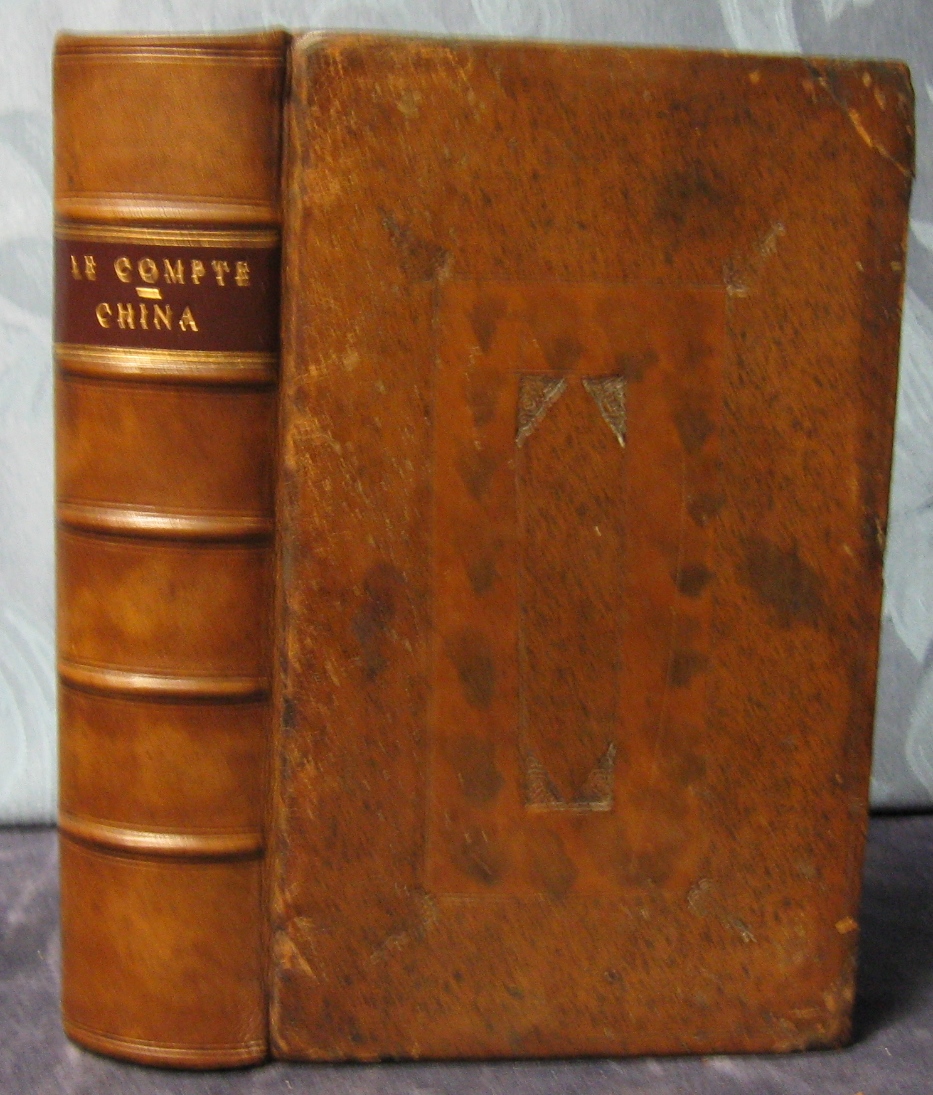
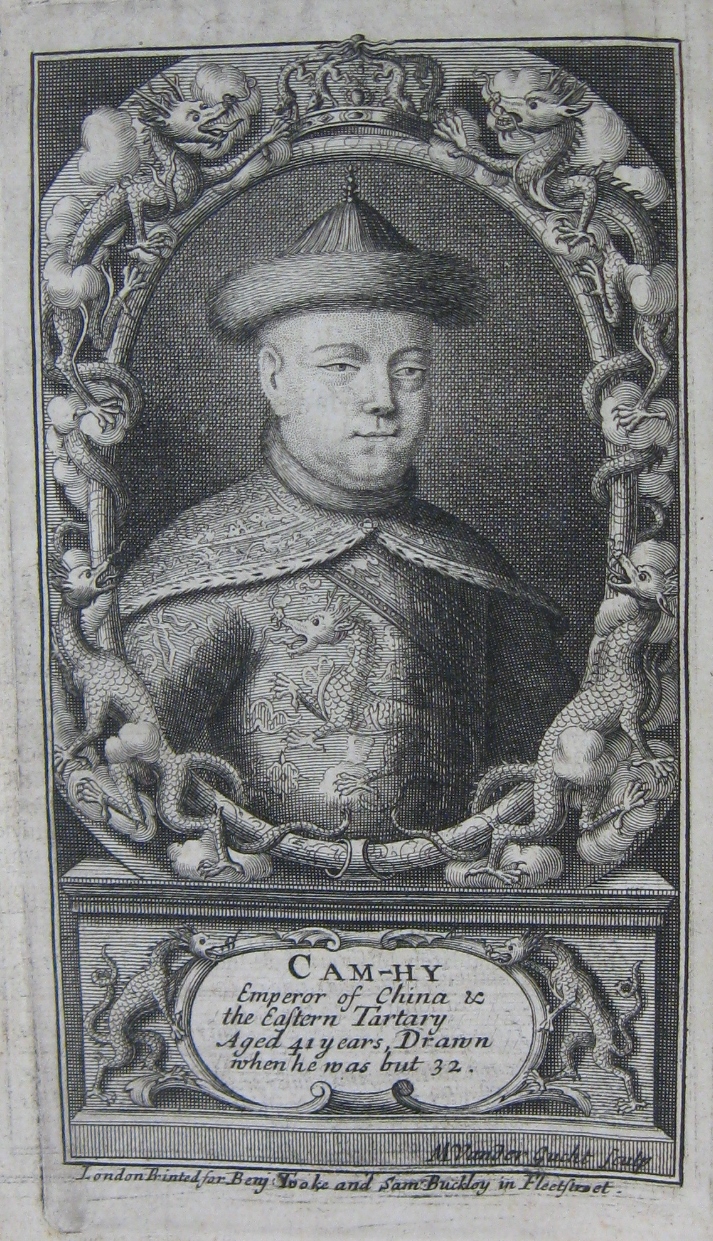
91. LE COMTE, Louis [David] [1655-1728]. Memoirs And Observations Topographical, Physical, Mathematical, Mechanical, Natural, Civil, and Ecclesiastical. Made in a late Journey Through the Empire Of China… 8vo. pp. 12 p.l., 527, [1]ad. engraved frontis. portrait of Cam-Hy, the Emperor of China, 3 engraved plates (2 folding), 1 engraving in the text, & 1 folding table. contemporary paneled calf, rebacked (last gathering browned). London: Benj. Tooke and Sam. Buckley, 1697. $2,500
First Edition of the English Translation. The French missionary was one of six Jesuit mathematicians who accompanied Ambassador Chaumont to Siam in 1685, remaining there for two years. From 1687 to 1692 Le Comte was in China where he fulfilled the functions of apostolic minister and made numerous astronomical observations (one of the folding plates in the present work depicts the Peking Observatory). At the time a quarrel arose between the Jesuits, who tolerated local religious ceremonies, and the missionaries of the Missions Étrangères who rejected the practices as idolatrous. Le Comte was censured for certain of his writings relating to these issues.
The present work includes descriptions of the travellers’ reception by the Emperor, Chinese cities and buildings, climate and natural resources, manners and customs, economy, language, books, morals, wit and genius, government, and religion, and an account of the progress of the Christian missions.
Cordier, Sinica, 40-41. Lust 51. Wing L831.
92. LOCKE, John [1632-1704]. A Letter To the Right Reverend Edward Ld Bishop of Worcester, Concerning some Passages Relating To Mr. Locke's Essay Of Humane Understanding: In A Late Discourse of his Lordships, In Vindication of the Trinity. 8vo. pp. 2 p.l., 227, [1]ad. complete with half-title. contemporary paneled calf, rebacked & recornered, endpapers preserved. armorial bookplate of Sir Henry Seton Bart. ownership entry on title of James Hood, dated 1728. London: Printed by H.Clark, for A. and J.Churchill and Edw. Castle, 1697. $2,500
First Edition, Second Issue, State III.
[BOUND WITH:] LOCKE, John. Mr. Locke's Reply to the Right Reverend the Lord Bishop of Worcester's Answer to his Letter, Concerning some Passages Relating To Mr. Locke's Essay Of Humane Understanding: In A Late Discourse of his Lordships, In Vindication of the Trinity. 8vo. pp. 2 p.l., 174, [1 leaf], 7, [1]errata, [4]ads. complete with half-title. London: Printed by H.Clark, for A. and J.Churchill and E.Castle, 1697.
First Edition, First Issue. In 1696, deist John Toland published his Christianity not Mysterious, a work professing to be a strict theological application of Lockean philosophy. It drew immediate response from Edward Stillingfleet, Bishop of Worcester, who in his Vindication of the Doctrine of the Trinity, attacked Toland and Locke alike, and charged Locke with disallowing mystery in human knowledge. A heated controversy ensued, Locke responding with a Letter and two Replies, the second of which appeared in 1699.
Yolton 248B.III & 249. Wing L2749 & L2753. Pforzheimer 604 & 606. NCBEL II 1837. Christophersen pp. 37-41. Rand I 342.
93. LUCANUS, [Marcus Annaeus]. La Pharsale…Ou Les Guerres Civiles, De César Et Pompée. En Vers François Par Mr De Brébeuf. 6 Parts in 1 Volume. 4to. pp. 8 p.l.(the last blank), 91; 5 p.l., 106, [blank leaf]; 2 p.l., 47; 2 p.l., 49-100, [blank leaf]; 3 p.l., 123; 2 p.l., 96. woodcut royal arms on title. woodcut ornaments & initials. contemporary mottled calf, gilt back (extremities worn, short split in upper front joint, free-endpapers removed, ms. notes on front paste-down & few leaves at beginning, lower outer corner of title torn away with loss of last two letters of the word ‘Roy’ in phrase ‘Avec Privilege Du Roy’). Paris: Antoine De Sommaville, 1656-54-55. $750
First Edition, Second Issue(?), with first title dated 1656 (the second is dated 1654, and the others 1655). This issue is not mentioned in any of the bibliographies consulted. In this copy, the privilege to the second part is signed in manuscript ‘Louis de France’ by his counsellor Habert and by the printer Sommaville.
Georges de Brébeuf’s [1618-1661] verse translation of Lucanus’ great epic poem on the civil war between Pompey and Caesar was well received by his contemporaries, but was severely criticized for its precious language by Nicolas Boileau in the latter’s Art poétique. Boileau did, however, allow that “Malgré son fatras obscur,/ Souvent Brébeuf étincelle.”
cfBrunet III 1202. cfCioranescu 16301 (1654-55). cfGoldsmith, BM STC French, L2063. cfGraesse IV 275. cfQuérard V 383.
94. MACHIAVELLI, Niccolò [1469-1527]. Les Discours De L’Estat De Paix Et De Guerre…Sur la première Décade de Tite-Live…Plus un Livre du mesme Autheur, Intitulé le Prince. 12mo. pp. 719, [4]. woodcut ornaments, initials & title vignette. contemporary vellum, overlapping fore-edges (head of spine chipped & headband sprung, text waterstained, former owner’s name excised from title). Paris: Jean Houzé, 1606. $800
Collected French edition of the two works which established Machiavelli as the founder of modern political theory: his historical essay on the first ten books of Livy, in which he discusses the concept of a republic, and The Prince, in which he outlines the practical attributes (including deceitfulness and unscrupulousness) required of a monarchical prince. “Politics was a science to be divorced entirely from ethics, and nothing must stand in the way of its machinery. Many of the remedies he proposed for the rescue of Italy were eventually applied. His concept of the qualities demanded from a ruler and the absolute need of a national militia came to fruition in the monarchies of the seventeenth century and their national armies.” (PMM)
This edition not in Goldsmith, BM STC French. cfPMM 63.
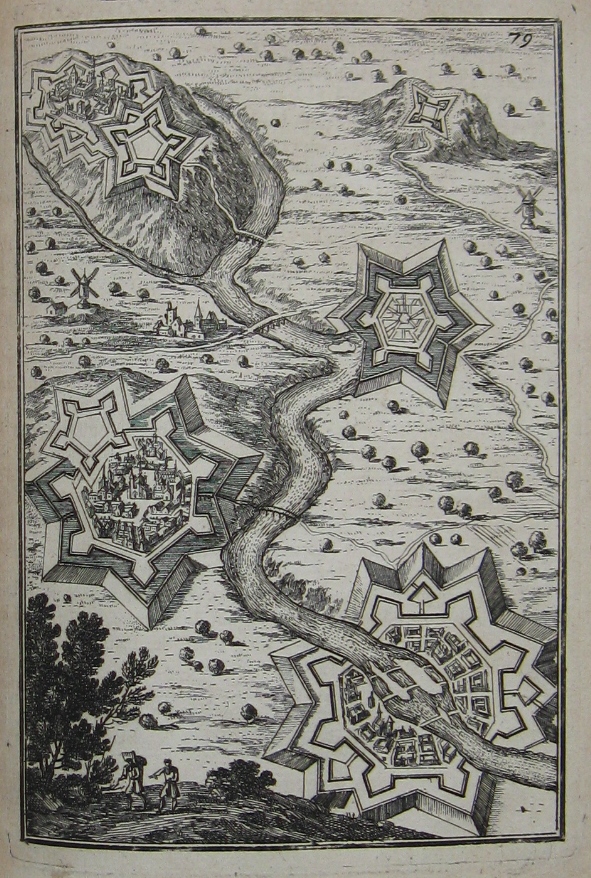
95. MALLET, Allain Malleson [1630-1706]. Les Travaux De Mars, Ou L’Art De La Guerre. Divisé En Trois Parties… 3 Volumes. 8vo. pp. 11 p.l., 222 [i.e. 220], [12 numbered 222a-222m], [223]-363, [5]; 6 p.l., 83-82, 341, [3]; 5 p.l., 387, [8]. 3 additional engraved titles, 414 engraved full-page plans & diagrams, & 2 engraved portraits. woodcut ornaments & initials. contemporary calf, gilt backs (corners & spine ends worn & chipped, occasional browning and marginal staining; engraved title of Volume I backed repairing long tear; a few scattered stains repaired tear to one plate; but overall a good clean copy). Paris: Denys Thierry, 1684-85. $4,000
Second and Best Edition, enlarged and revised, of this profusely illustrated military treatise. The author was a French mathematician and military engineer, who was formerly in the service of Alfonso VI of Portugal. The first two volumes are devoted to an analysis of fortification, with particular emphasis on the geometrical elements. Mallet discusses various fortification methods and systems, including those developed by Dögen, Freitag, Errard De Bar Le Duc, Marolois and Sardi. The third volume contains chapters on infantry and cavalry manoeuvres, sieges, defense methods and Turkish warfare (pp. 317-387). The full-page engravings variously depict firearms, artillery, battle formations, and plans of the fortifications of many European cities (Douay, Arras, Lisbon, Brest, Barcelona, La Rochelle, Landrecy, Geneva, &c.).
Spaulding & Karpinski 188. Goldsmith, BM STC French, M273. Graesse IV 354.
96. MARGUERITE [D’ANGOULÊME, QUEEN OF] NAVARRE [1492-1549]. L’Heptameron Ou Histoires Des Amans Fortunez…Remis en son vray ordre…Par Claude Gruget, Parisien. 12mo. pp. 12 p.l., 537, [1]blank, [8]table. woodcut headpiece & initials. 19th century calf, rebacked with gilt spine mounted, all edges gilt (repairs to title & last 2 leaves affecting 2 digits in imprint date & with loss of a few words on final leaf, title faded). Paris: Jacques Bessin, 1615. $1,500
Constructed on the lines of the Decameron of Boccaccio, the work consists of seventy-two stories told to each other by a company of ladies and gentlemen while resting on a journey home. It was originally published anonymously with a different format and only 67 stories as Histoire des amans fortunez in 1558; the first edition to contain the 72 stories and to bear the title L’Heptameron was published in 1559.
The Queen of Navarre was the sister of the future François I and the mother of the future Henri IV. “She was a prolific writer, leaving a voluminous correspondence and numerous poetic and dramatic works, though her most lasting achievement is undoubedly the cycle of 72 tales known as the Hemptameron.” (The New Oxford Companion to French Literature) “It is a delightful book, and strongly characteristic of the French Renaissance. The sensuality which characterized the period appears in it, but in a less coarse form than in the work of Rabelais; and there is a poetical spirit which, except in rare instances, is absent from Pantagruel. (Encyc. Britann., 11th Edn.)
Of special note is tale 67, pp. 538-42, which relates a story told to the narrator by Captain Roberval, who was appointed viceroy of New France in 1540 and directed to sail with Jacques Cartier to establish a colony on the St. Lawrence River. The story concerns a relation of Roberval, an unnamed young woman (Marguerite de la Roque), whose conduct leads him to abandon her together with her lover on an island called Île des Démons on the St. Lawrence.
Brunet III 1417. European Americana 615/80. Tchemerzine VII 395. cfGay IV 391. cfQuérard V 530.
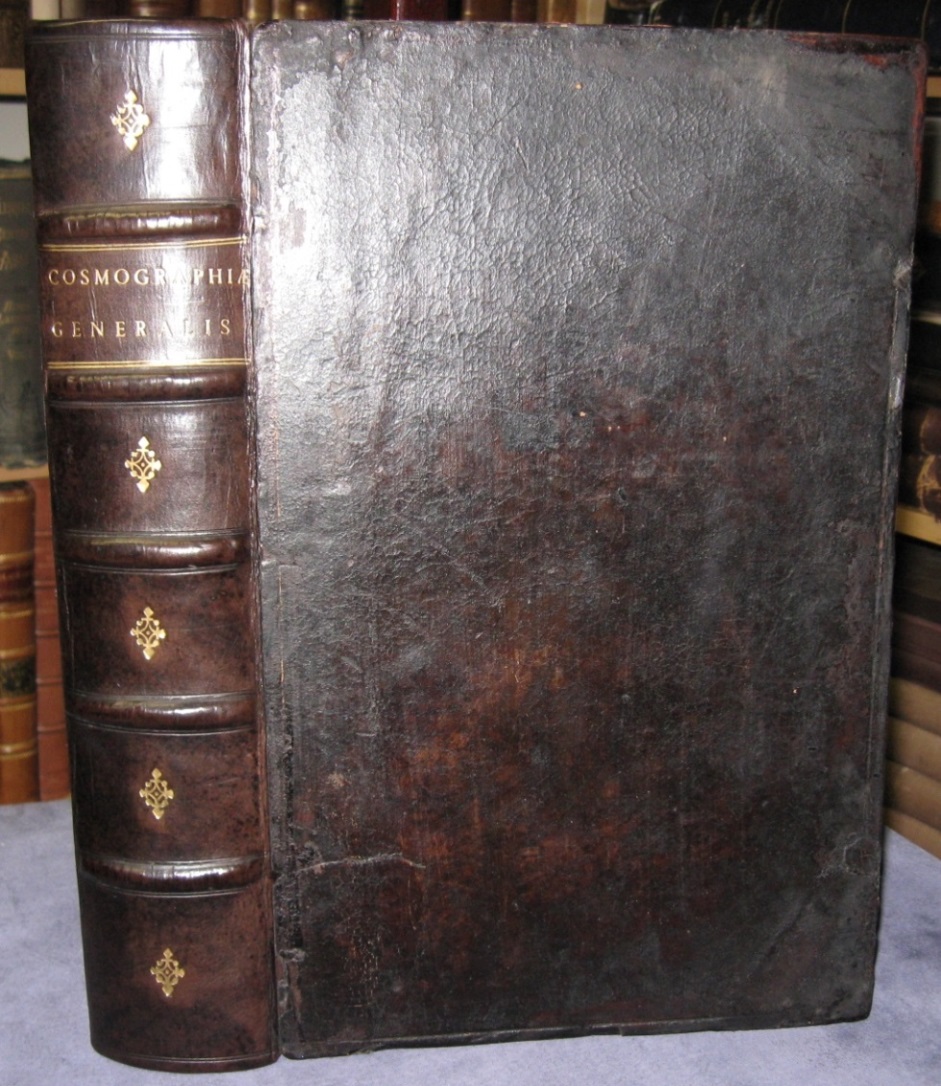
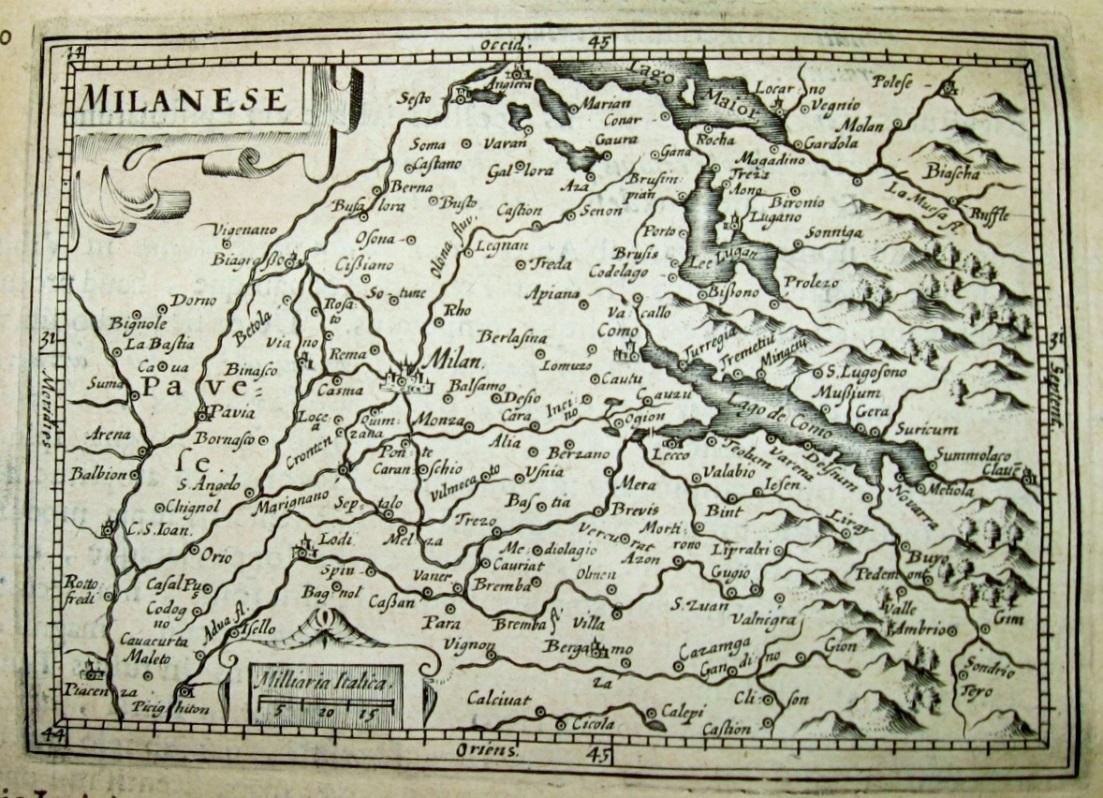
97. MERULA, Paulus [1558-1607]. Cosmographiae Generalis Libri Tres: Item Geographiae Particularis Libri Quatuor: Quibus Europa In Genere, Speciatim Hispania, Gallia, Italia Describunter... folio. pp. 8 p.l., 1075 [ie. 1065], [1]. with half-title. engraved title. 57 engraved maps & 1 woodcut view in the text. contemporary calf, rebacked (small hole in title repaired with 3 letters & tiny portions of border supplied in facsimile, minor worming in upper blank margin near end, some light browning & foxing). Amsterdam: Henricus Hondius, 1621 [Colophon: Leyden: Isaac Elzevier, 1620]. $6,000
Second Dutch Edition of this treatise on the geography of the Mediterranean and the Ancient World. This edition eliminates the large maps present in the first edition of 1605, but the small maps in the text, based on those in Bertius' Tabularum Geographicarum, were corrected by Jodocus Hondius. They comprise a world map, a map of Europe, twelve maps of Spain and Portugal, twenty-four of France and nineteen of Italy. The author, a Dutch jurist, was appointed to the chair of history at the University of Leyden in 1592. In addition to the present geography, he wrote many treatises on laws and history.
Koeman III 1. Willems 188.
98. [MEYERBERG, Augustin MAYER, Freiherr von] [1612-1688]. Voyage En Moscovie D’Un Ambassadeur, Conseiller de la chambre Impériale, Envoyé par L’Empereur Léopold Au Czar Alexis Mihalowics, Grand Duc de Moscovie. 12mo. pp. 1 p.l., 381. woodcut title vignette & initials. contemporary calf, gilt back (light wear to spine ends). Leyden: Friderik Harring, 1688. $1,150
First Edition of the French Translation (originally published in Latin in c1668). The author, a German diplomat, was sent as an envoy by the Emperor Leopold I to the Court of Czar Alexei Michaelovitch in 1661 to re-establish peace between Poland and Russia. Mayerberg, together with his colleague Calvucci and seventeen attendants, experienced great difficulty in obtaining entry into the country. Once there, they were prevented from all external communication, finally being allowed to return to Vienna in March of 1663. Mayerberg’s account of his experiences contains much useful information on seventeenth century Russian manners and customs. The section on Russian laws is omitted in this edition.
Brunet III 1557. Graesse IV 456.
99. [MURCHIO, Antonio, known as Father] VINCENZO MARIA DI S. CATERINA DA SIENA. Il Viaggio All’Indie Orientali Del Padre F. Vincenzo Maria Di S. Caterina Da Siena Procurator Gener. de’ Carm. Scalzi… small 4to. pp. 12 p.l., 516, [19]. woodcut ornaments & initials. Uncut in contemporary vellum over paste-board (few pieces of vellum chipped from paste-board, first gathering partly sprung, few wormholes touching several letters on 3 leaves of index at end). Venice: Giacomo Zattoni, 1678. $2,500
Second Edition (first: 1672). Account of the Carmelite’s voyage to India via Turkey and the Middle East. The primary purpose of the expedition was to win back to the fold of Rome the ‘Christians of Saint Thomas’, the vast majority of whom had broken away in the great schism of 1653. The work contains a particularly extensive account of India, its flora and fauna, politics and government, religion and ceremonials, &c. Goa, Persia, Arabia, Turkey, Babylon, and Syria are also described with some detail.
Bell M545. Streit V 538.
100. [PERRINCHIEF, Richard] [1623?-1673]. The Royal Martyr: Or, The Life and Death Of King Charles I. 8vo. pp. 7 p.l., 311, [9]. engraved frontis. portrait. contemporary mottled calf (short splits to joints & some wear to spine ends, endpapers split along inner front hinge). London: Printed by J.M. for R.Royston, 1676. $650
First Separate Edition.
Wing P1601. McAlpin III p. 735 (lacking frontis.).
101. PETIT, Samuel [1594-1643]. Leges Atticae Sam Petitus Colligit, Digessit, Et Libro Commentario Illustravit. Opus Iuris, Literarum, Et Rei Antiquariae studiosis utilissimum… folio. pp. 5 p.l., [1]blank, 55, 557, [4]index. title in red & black with large engraved vignette. woodcut ornaments & initials. contemporary paneled calf, rebacked & restored (marginal tear in last leaf of index – no loss). from the library of Thomas Cushing Aylwin [1806-71], lawyer, politician and high court justice of Lower Canada, with his signature on front paste-down. Paris: Charles Morel, 1635. $1,350
First Edition. An important work on ancient Greek law by the learned French orientalist and protestant minister. Petit was highly admired by such distinguished scholars as Selden, Gassendi and Vossius.
Camus-Dupin 417. Graesse V p. 220. cfBrunet VI 2448. Not in BM STC French.
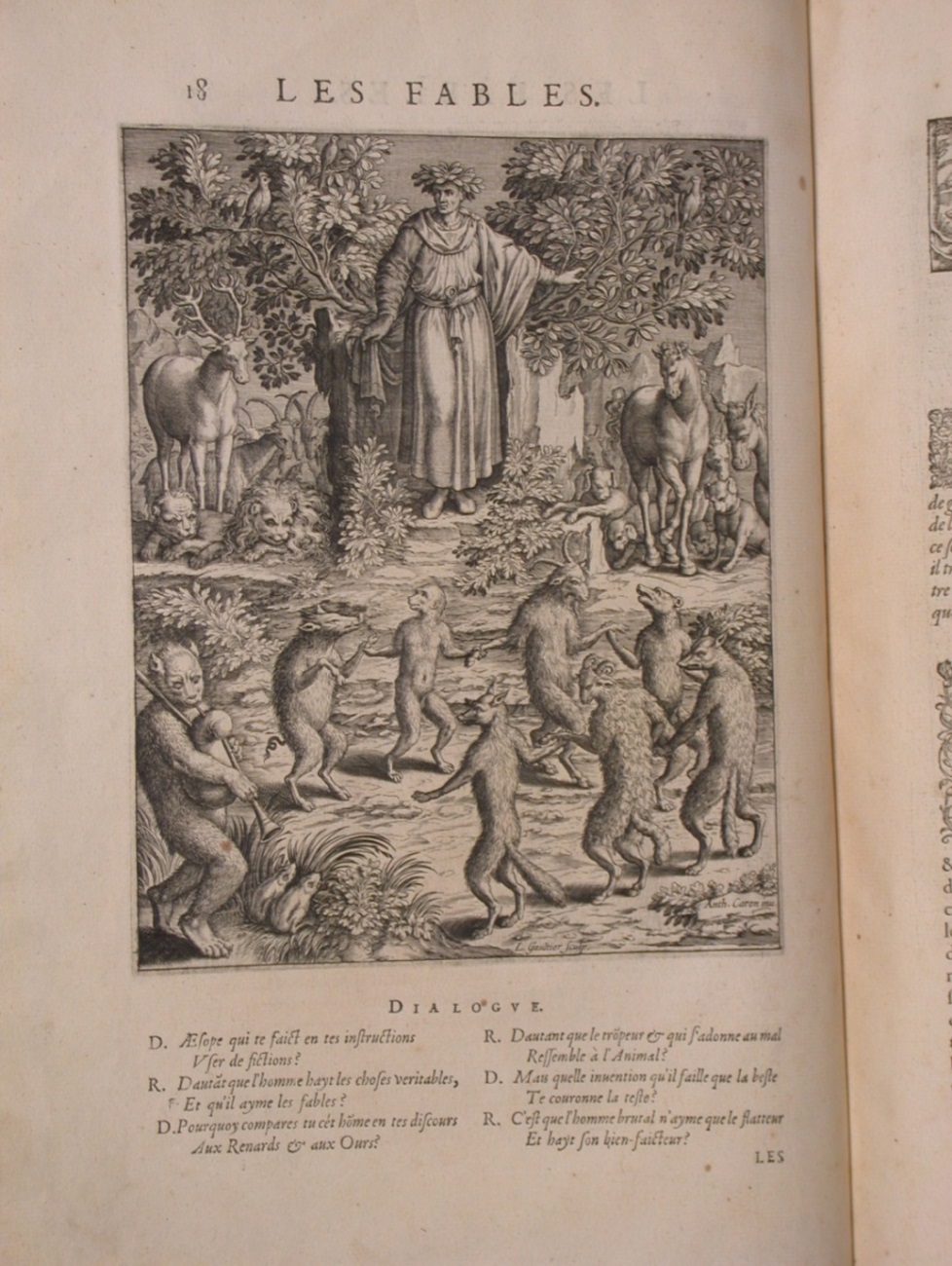
An important Baroque Iconographical Source Book
102. PHILOSTRATUS, Flavius. Les Images Ou Tableaux De Platte Peinture Des Deux Phikostrates Sophistes Grecs Et Les Statues De Callistrate Mis en François par Blaise de Vigenère. Avec des Épigrammes par Artus Thomas Skieur D'Embry. folio. pp. 18 p.l., 921 [ie. 925], [1]privilege, [46]index. engraved title by Jaspar Isac. 68 large (almost full-page) engravings in the text by L.Gaultier & T. de Leu after designs by A.Caron & J.Isac. 2 small text engravings of musical instruments & numerous woodcut ornaments & initials. early 18th century speckled calf, spine richly gilt, covers with gilt arms of Philippe Lefèbvre de Plainval, director of the Royal farms at Rouen, 1710, & gilt cherub cornerpieces (binding restored, joints partly cracked, title backed, Gg5 partly silked repairing several tears - no loss, a few marginal repairs, some damp & brownstaining to outer & lower margins, scattered spotting). Paris: the widow of Abel Angelier & the widow of Matthieu Guillemot, 1614. $5,750
First Illustrated Edition of Blaise de Vigenère's French translation of the Imagines of the Philostrati, two Greek sophists of the Roman imperial period. The Imagines of the elder Philostratus purports to be a description of sixty-four pictures in a gallery at Naples, that of his grandson a description of seventeen pictures done in the same manner. Vigenère's French translation with commentary was first published in 1578. The present edition is embellished with fine large engravings by Léonard Gaultier and Thomas de Leu after designs by Jaspar Isac and Antoine Caron, who had worked under Primaticcio at Fontainebleau. Hofer notes that the engravings of mythological and allegorical subjects were "much admired and imitated throughout the century." An important Baroque iconographical source book. In some copies the title is dated 1615; the reference in Brunet to a 1609 edition appears to be an error.
Brunet IV 620. Goldsmith, BM STC French P983 (title dated 1615). Hofer, Baroque Book Illustration, 23. Landwehr, Romanic Emblem Books, 586. Praz pp. 453-54 (title dated 1615, mistakenly calling for 64 copperplates).
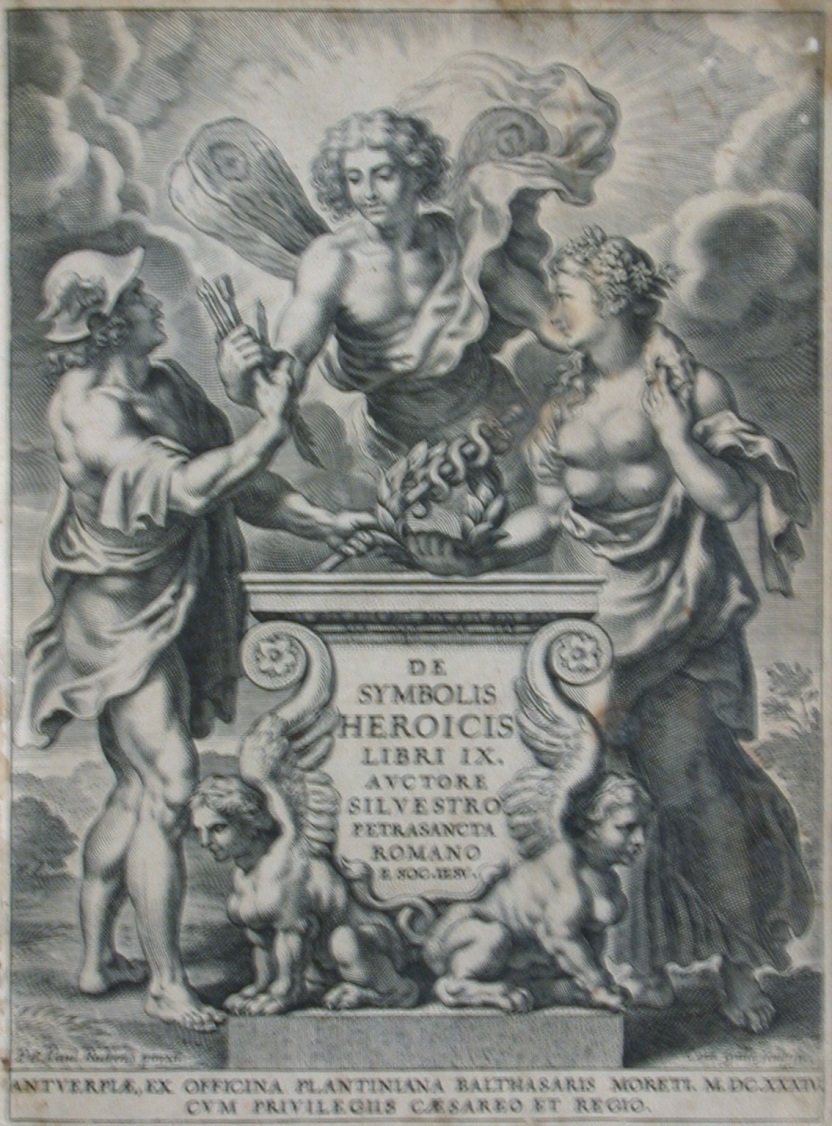
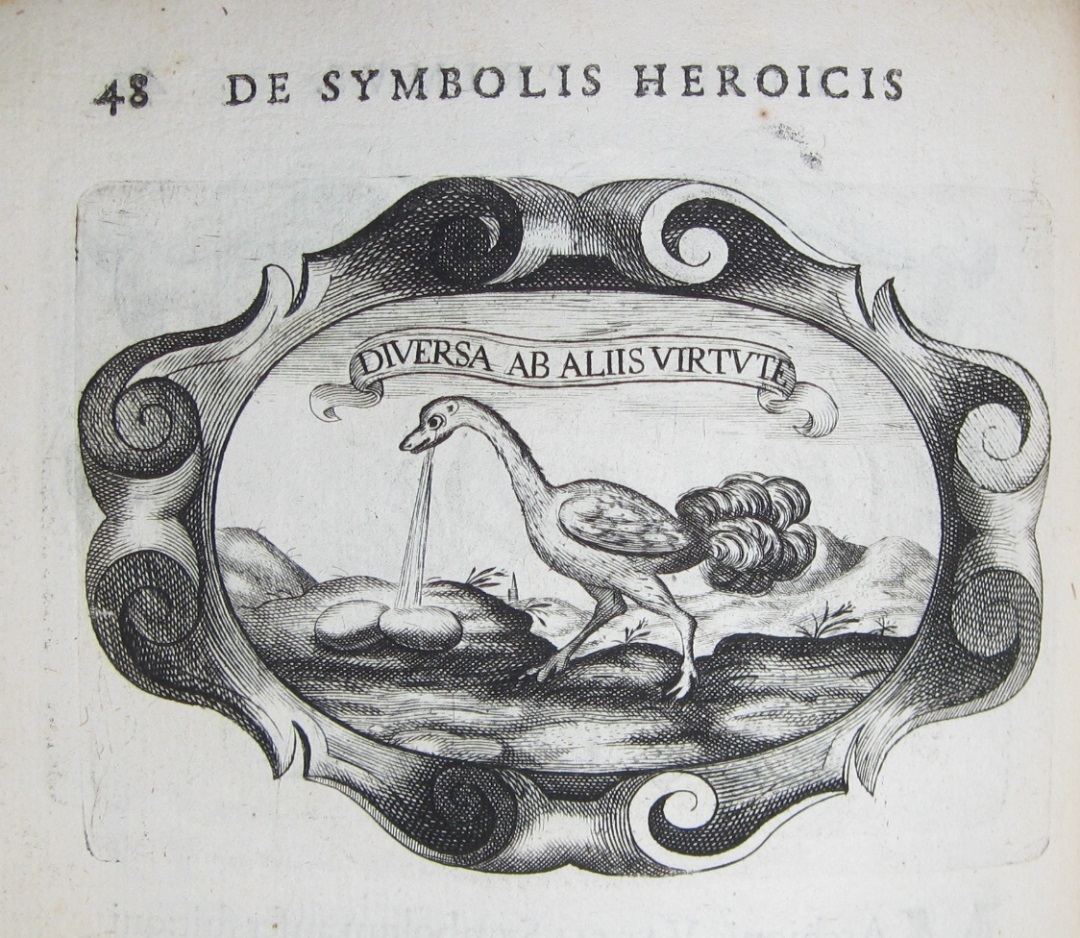
Plantin Press Emblem Book
103. PIETRASANTA, Silvestro [1590-1647].De Symbolis Heroicis Libri IX. small 4to. pp. lxxx, 480, [34]index, errata & privilege, [1 leaf]colophon. engraved allegorical title by Cornelis Galle after a design by Peter Paul Rubens, a full-page engraved portrait of dedicatee Cardinal Pietro Luigi Carafa & another full-page engraving of his coat of arms, 7 full-page engravings of blazons & genealogy relating to the Carafa family, 268 half-page engraved devices within borders of varying designs, 13 other text engravings & a few small woodcuts. woodcut ornaments & initials. contemporary vellum, overlapping fore-edges (vellum soiled, marginal wormtrack filled in in last gatherings, few tiny wormholes in 1st 2 leaves, occasional minor spotting). Antwerp: Balthasar Moretus, Plantin Press, 1634. $4,000
First Edition. “Balthasar Moretus I (d. 1641) was the grandson of Christopher Plantin and worthily carried on the printing traditions of the great Antwerp firm after the death of his father, Jan Moretus, in 1610. This well-written emblem book dates from the period when both Catholics and Protestants had realized that this type of book, formerly produced for the frivolous pleasure of courtiers, was equally suitable for the allegorical interpretation of spiritual truths. The frontispiece, as in many books printed by Moretus, is engraved by Cornelis Galle the Elder after a design by Rubens, but the Plantin-Moretus archives reveal that the emblems which are exhibited were evidently originally engraved on copper by artists in the employ of the Jesuit fathers and then re-worked for Moretus between December 1633 and June 1634 by the skilled hand of André Pauwels.” (PMM) Among the emblems of the famous and virtuous appears the Plantin Press compass device with motto ‘Labore et Constantia’ (p. 382), and among the illustrations is a depiction of the magnetic clock constructed by the English Jesuit scientist, Francis Line, at Liège (p. 146).
The work is dedicated to Pietro Luigi Carafa, papal nuncio at Cologne, by the author, a Jesuit priest who was Carafa’s confessor. There follows a long preface with an extensive genealogical account of Carafa’s family.
Landwehr, Low Countries, 498. Printing and the Mind of Man (Fine Printing) 86. Praz p. 455. De Backer-Sommervogel VI 740. Vinet 867.
104. PLAZZONI, Francisco [d. 1624].De Partibus Generationi Inservientibus... 12mo. pp. 4 p.l., 184. engraved frontis. woodcut initial. contemporary vellum, overlapping fore-edges (vellum soiled, one item removed from binding at end, rear hinge broken). bookplate of the Library of the Royal College of Physicians, Edinburgh & printed label of J.W.Ballantyne. Leyden: Felicis Lopez De Haro, 1664. $900
[BOUND WITH, as issued:] ARANZI, Giulio Cesare [1530?-1589]. De Humano Foetu Libellus. 12mo. pp. 50. woodcut title vignette & initial. Leyden: Felicis Lopez De Haro, 1664.
[BOUND WITH, as issued:] NYMANN, Gregor [1594-1638]. Dissertatio De Vita Foetus In Utero... 12mo. pp. 4 p.l., 84. woodcut initial. Leyden: Felicis Lopez De Haro, 1664.
[BOUND WITH:] BARTHOLIN, Caspar [1655-1738].De Ovariis Mulierum Et Generationis Historia Epistola Anatomica... 12mo. pp. 69, [2]. woodcut title vignette, headpiece & initial. Amsterdam: J. Henr. Wetstenius, 1678.
Collection of four sixteenth and seventeenth century tracts dealing with human generation, the reproductive organs, and the life of the foetus in utero. The second, by Aranzi, was first published in 1564. "Aranzi believed the maternal and foetal circulations to be separate. He described the ductus arteriosus and ductus venosus of the foetus, and the corpora Arantii in the heart valves. Incidentally, he was the first to record a pelvic deformity." (Garrison & Morton)
Waller 7516, 447, 6929, & 707. Wellcome IV 400, I 52, IV 253, & I 107. cfGarrison & Morton 464 (Aranzi).
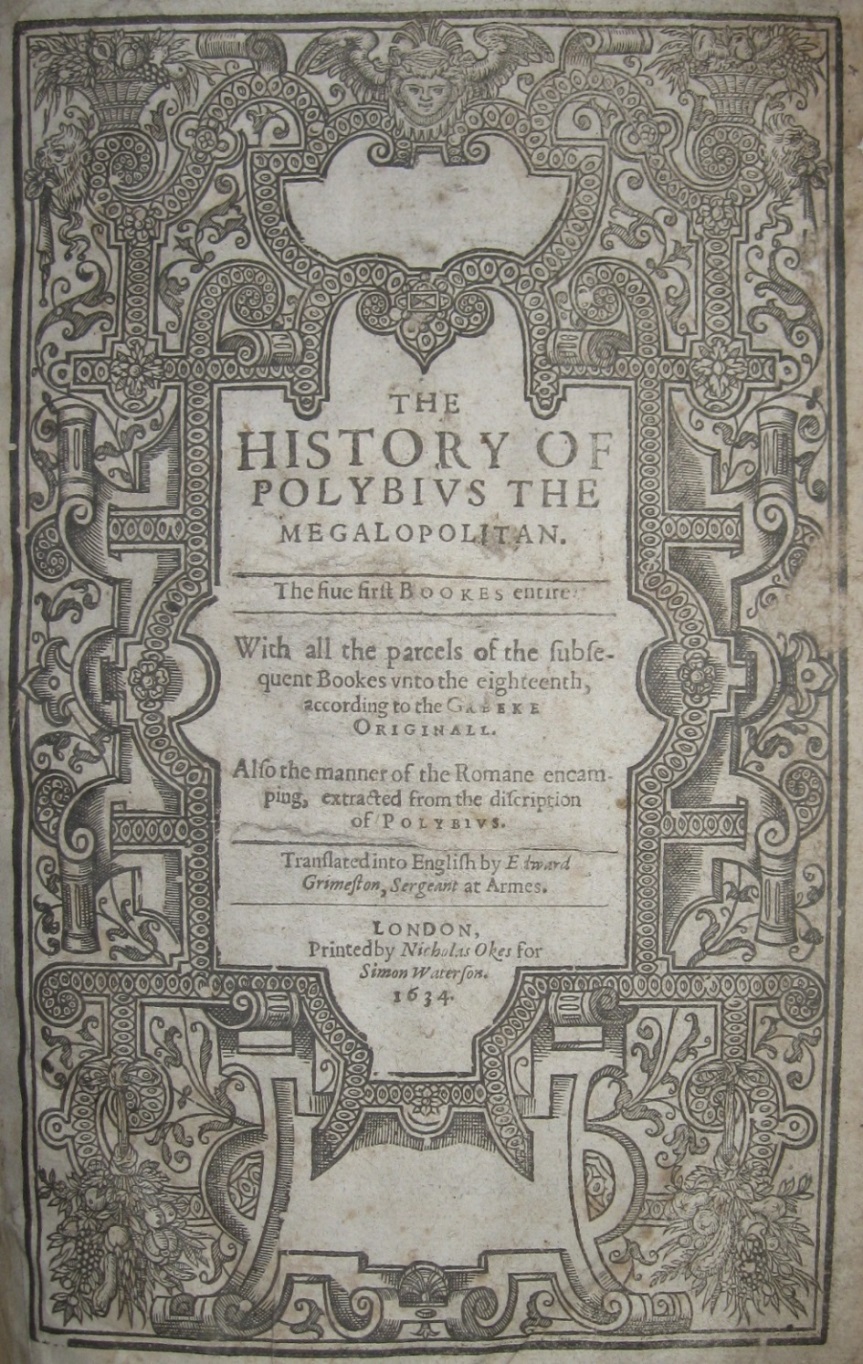
105. POLYBIUS. The History Of Polybius The Megalopolitan… folio. pp. 8 p.l., 480, [14]index. with initial blank. title within elaborate woodcut border. folding table. woodcut ornaments & initials. contemporary calf, rebacked, re-edged & recornered (N gathering misbound, inner margin of title renewed, title with 2 abrasions which slightly affect woodcut border, 3 leaves with marginal defects, scattered light to moderate foxing, some dampstaining in last gatherings mainly affecting margins, marginal repairs to title & last 2 leaves). London: Printed by Nicholas Okes for Simon Waterson, 1634. $1,750
First Edition of the English Translation by Edward Grimeston, preceded by C.Watson’s translation of 1568. STC notes 3 variants, one with earlier imprint (1633).
STC 20099. Brüggemann p. 241. Moss II p. 529.
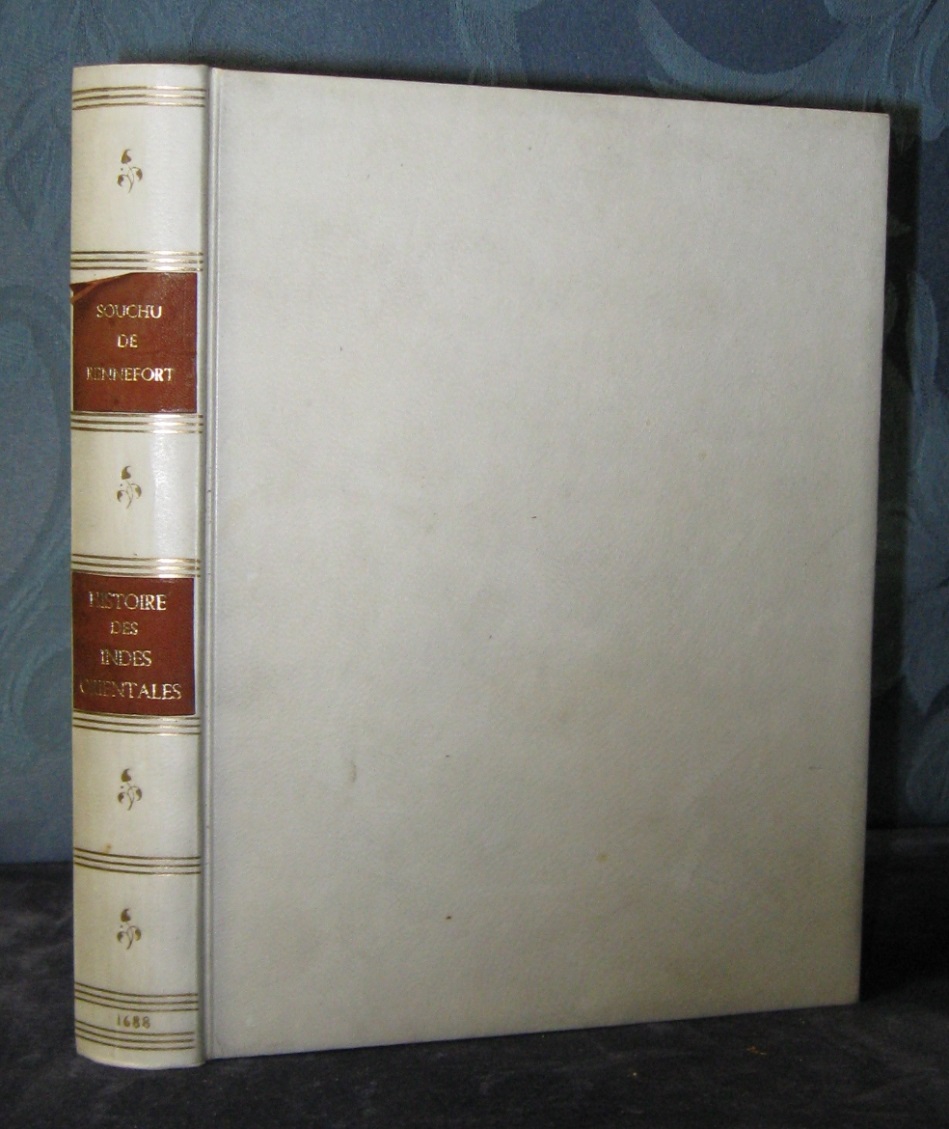
Important Source for Madagascar
106. [RENNEFORT, Urbain Souchu de] [c1630-1689]. Histoire Des Indes Orientales. small 4to. pp. 8 p.l., 402, [2]privilege. 3 engraved headpieces. woodcut title vignette, ornaments & initials. modern vellum bds. (2 headpieces shaved, repaired tear in Hh2 – no loss). Paris: Arnoul Seneuze and Daniel Hortemels, 1688. $3,000
First Collected Edition. Rennefort was secretary of the Compagnie Française de L’Orient. In 1665 he was charged with provisioning and inspecting the colony of Fort-Dauphin, governed since 1663 by Chamargon. Rennefort arrived to find the colony in desolation and misery and vainly attempted to re-establish order and peace with the natives. His account was originally published in 1668 under the title Relation du Premier Voyage de la Compagnie des Indes Orientales en L’Île des Madagascar ou Dauphine. It has here been greatly expanded to include an account of a subsequent French voyage to Madagascar undertaken by Mondevergue, Governor-General and Admiral of ‘La France Orientale’, with a description of the latter’s visit to Brazil (Pernambuco and Olinda), and an account of a further voyage by de Faye from Madagascar to Ceylon, Goa, Calcutta and Surat. Together the accounts provide an important history of the first efforts of the French to establish themselves in Madagascar as a base for their East India operations, and contain interesting details regarding the religion, manners and customs of the native inhabitants of the country and the establishment and history of the Compagnie Française de L’Orient.
Bell R226. Borba de Moraes p. 820. cfGay 3256. cfJCB p. 197.
107. [RETZ, Jean François Paul De Gondi, Cardinal De] [1613-1679]. La Conjuration Du Comte Jean-Louïs De Fiesque. 12mo. pp. 136. woodcut sphere device on title. woodcut headpiece & initial. contemporary mottled calf (spine dull & headpiece worn). Cologne [i.e. Amsterdam]: [Daniel Elzevier], 1665. $450
First Elzevir Edition, issued the same year as the Paris first.An historical work concerning the failed conspiracy by Gian Luigi Fieschi against the doge Andrea Doria in 1547, the object of which was to place Genoa under a French protectorate. It exhibits remarkable style, and was written when Retz was only eighteen years of age, although it was anonymously published much later.
Barbier I 691. Berghman 1718. Brunet IV 1252. Graesse VI 94-5. Rahir 1403. Tchemerzine IX 393. Willems 1352. cfQuérard VII 548.
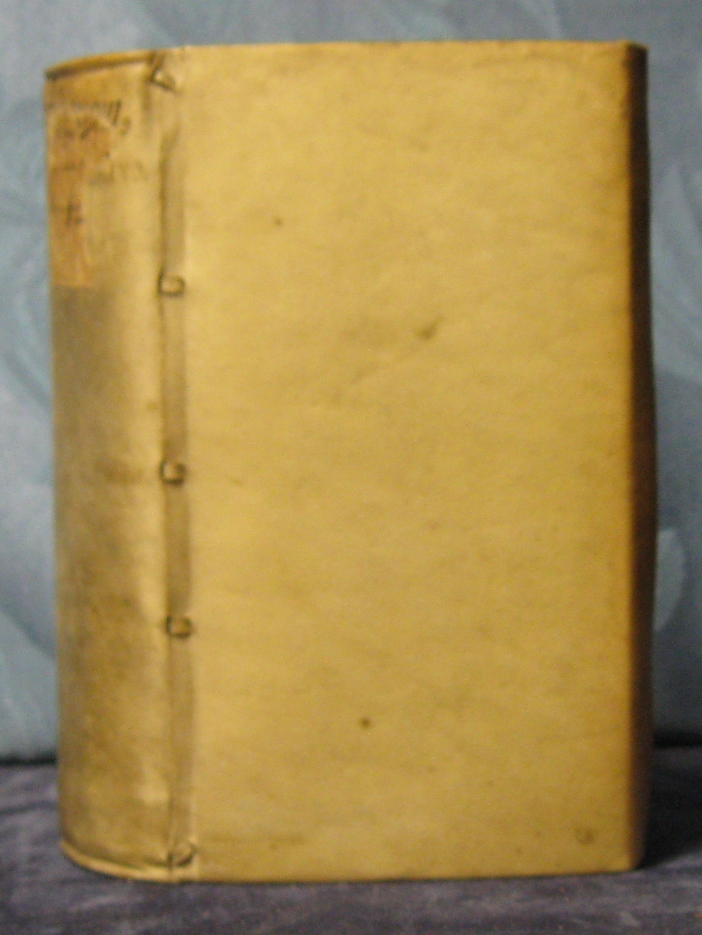
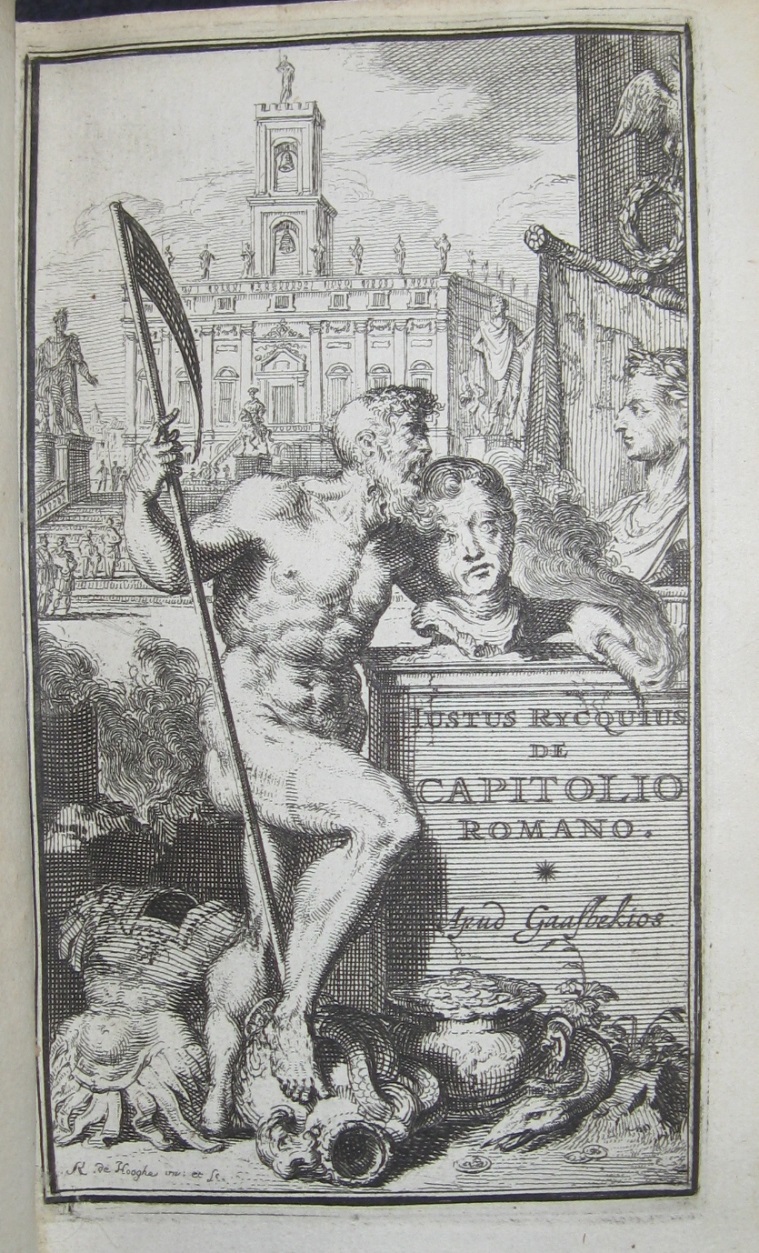
108. RYCKE, Josse de [1587-1627]. De Capitolio Romano Commentarius… 12mo. pp. 16 p.l., 562, [29]index. additional engraved title by Romeyn de Hooghe, 1 engraved floor plan & 14 engraved plates. A nice copy in contemporary vellum (scoring on a few pages at beginning). Leyden: Daniel, Abraham & Adrian à Gaasbeeck, 1669. $1,100
Second Edition (first: 1617) of Rycke’s guide to the architectural antiquities of Rome. The Belgian poet and antiquary spent some time in Rome as librarian to the comte Louis Sarego. He returned to Italy in 1624 and was given a chair at the University of Bologna by Urbain VIII. “Ce commentaire est curieux et savant.” (Nouvelle Biographie Générale). Gronovius edited a third edition with a supplement and notes that was published at Leyden in 1696.
cfCicognara 3870.
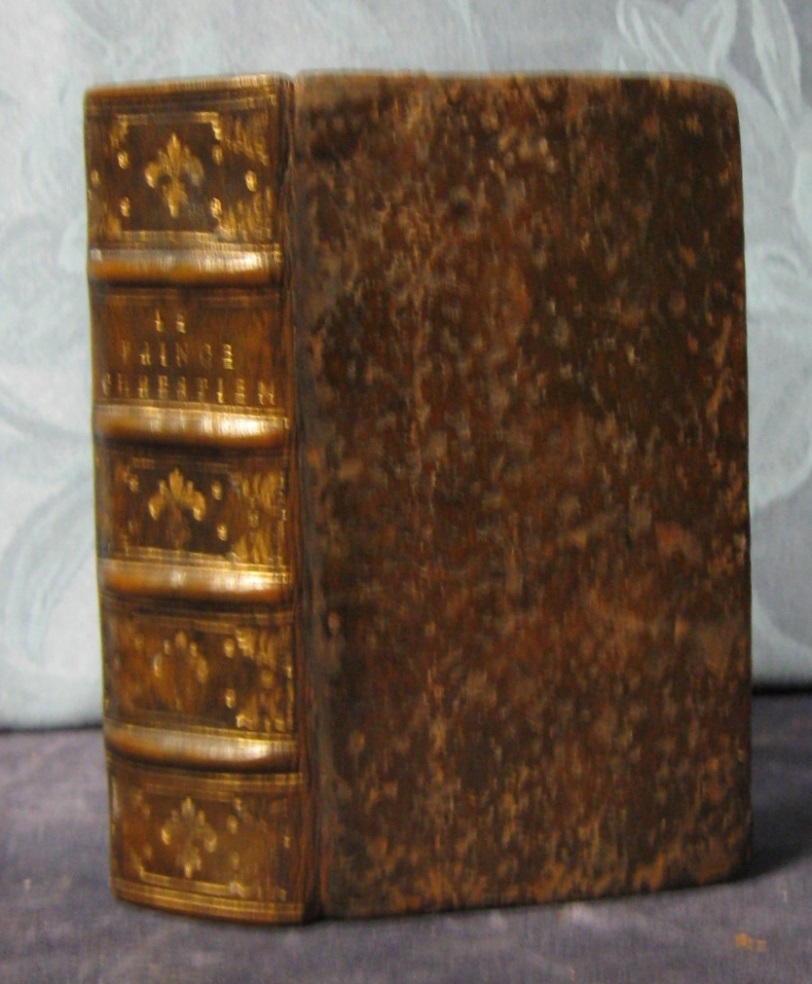
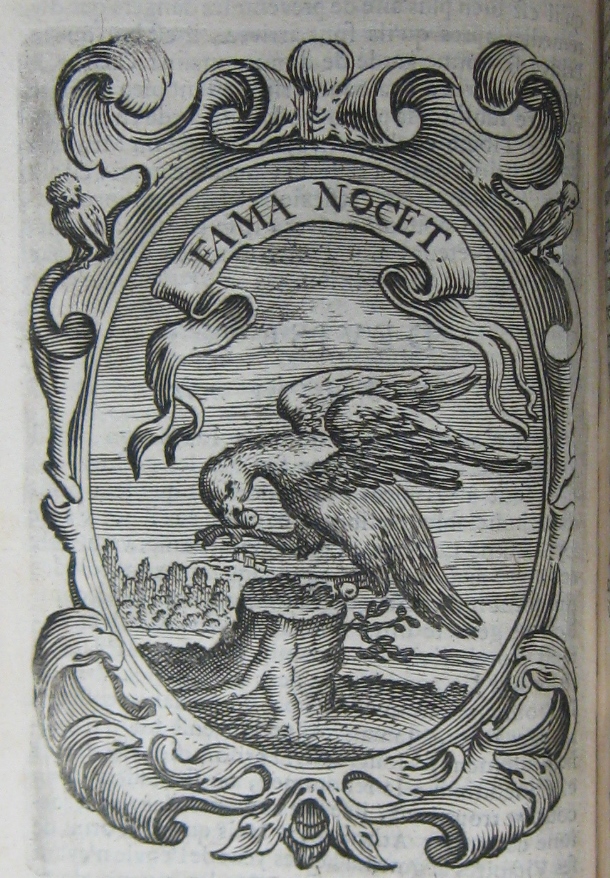
109. SAAVEDRA FAJARDO, Diego De [1584-1648]. Le Prince Chrestien Et Politique… 2 Vols. in 1. 12mo. pp. 12 p.l., 423; 4 p.l., 432. engraved frontis./dedication plate. 101 engraved emblems in the text. contemporary calf, rebacked, all edges gilt (some gatherings with light dampstaining). Amsterdam: Jean Schipper, 1670. $1,500
This popular and influential guide to princely conduct was written for the edification of Infante Baltasar, son of Philip IV of Spain, who unfortunately died young at the age of sixteen. It was first published in Spanish in 1640. The author, Saavedra Fajardo, was educated at Salamanca and enjoyed a long and successful career in the diplomatic service.
“The most remarkable treatise of political devices for the use of a prince was written by a pious layman, the Spaniard Diego Saavedra Fajardo…The hundred devices and discourses with the maxims of statecraft begin with Hercules strangling the serpents in his cradle, and end with an emblem worthy of the macabre imagination of Valdés Leal: a skull covered by a spider’s web standing upon a cracked sarcophagus at whose feet lie a broken capital, a sceptre and a crown upturned…Fajardo’s work was translated into various languages, and had very many imitators…”. (Praz) The French translation, edited by J.Rou, was first published in 1668 and was dedicated to the Dauphin.
Landwehr 675.Praz pp. 191-93.cfBrunet V 3.
110. SAINT-ÉVREMOND, [Charles de Marguetel de Saint-Denis, Seigneur] De [1613-1703]. Oeuvres Meslées. 2 Volumes. 4to. pp. 2 p.l., 540, [2]; 4 p.l., 488, [4]. woodcut ornaments, initials & title vignettes. contemporary sprinkled calf, gilt backs (some wear to lower corners). armorial bookplate of Rodolph de Castella, a Swiss officer in the French service. Paris: Claude Barbin, 1690-92. $750
Including poetry, three comedies, historical essays, and miscellaneous works on morality and religion that were much admired by the author’s contemporaries for their wit and graceful style. Saint-Évremond “is an aristocratic disciple of Montaigne, an Epicurean, and a libertin. For him, religion and philosophy are uncertain, tolerance is the only reasonable attitude, and sociability, politeness, and the pleasures of body and mind are better than stiff and strenuous verse.” (New Oxford Companion to Literature in French)
cfBrunet V 38.cfCioranescu 60795 & Cioranescu 60796. cfQuérard VIII 332.
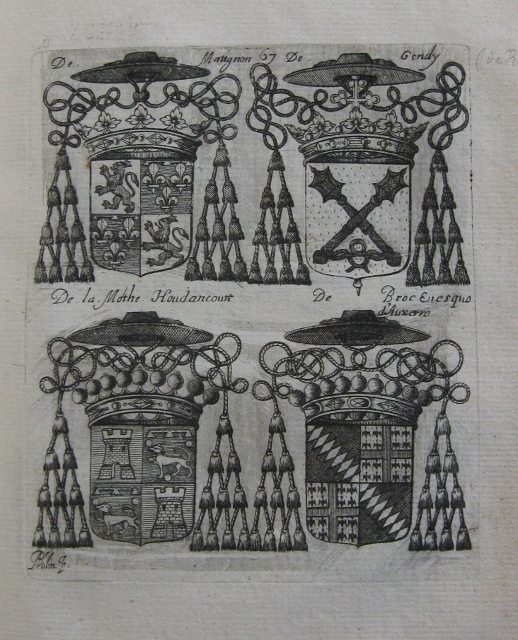
111. SEGOING, C[harles]. Armorial Universel Contenant Les Armes des principales Maisons Estatz et Dignitez des plus considerable Royaumes de l’Europe… small folio. engraved title, engraved dedication, 2 plates of engraved text, [pp. 12](printed table) & 201 (of 206?) engraved plates of coats of arms (incl. 7 bis plates). lacking 5 bis plates. old vellum over paste-board (covers bowed, upper margin of plate 1 replaced, mild staining in upper margin). Ex-libris L. Gidel. some early ms. additions in the table. Paris: N.Berey, 1654. $2,000
First Edition of this handsome early European armorial.
Brunet V 261. Graesse VI 341.
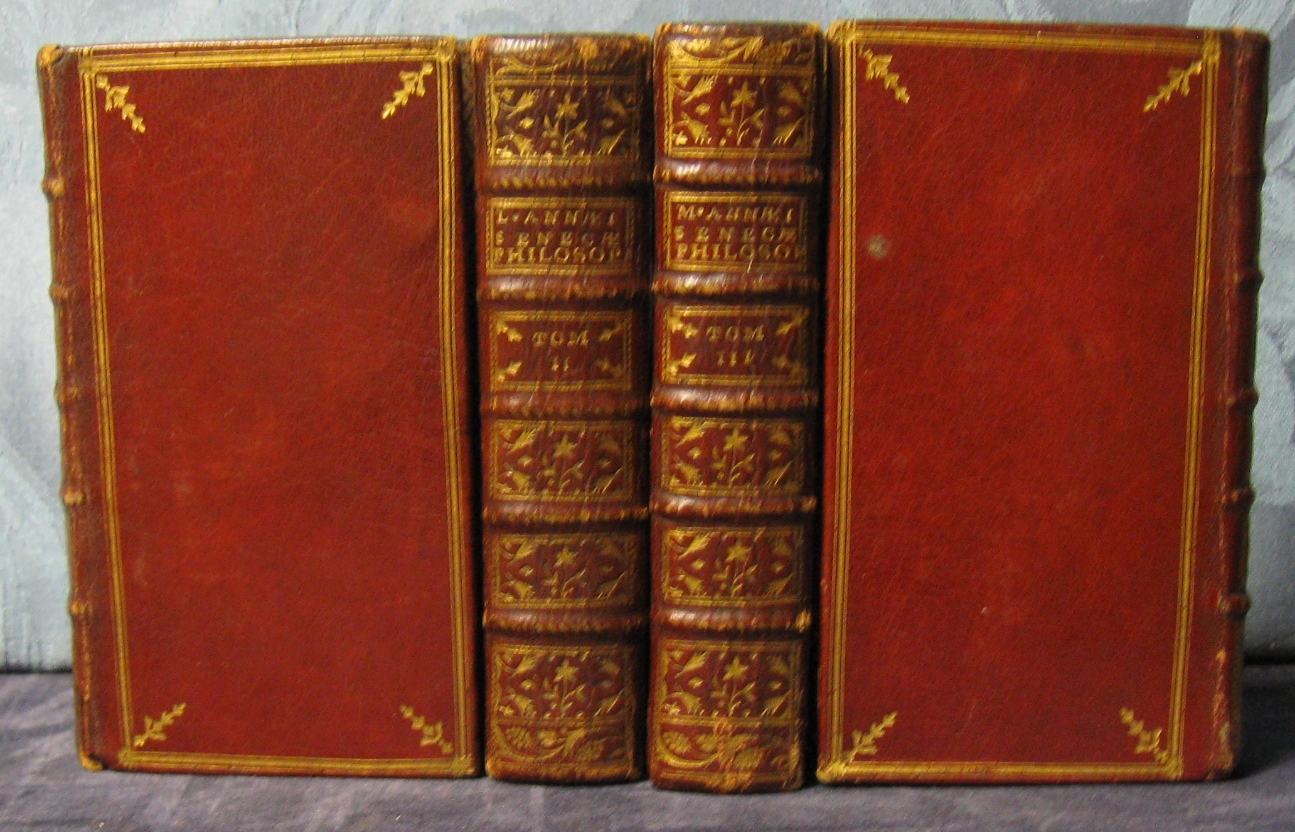
112. SENECA, L[ucius] Annaeus. Opera Omnia Ex ult. I.Lipsii emendatione et M.Annaei Senecae Rhetoris quae exstant; Ex. And. Schotti recens. [WITH:] GRONOVIUS, Johann Friedrich. Ad L. & M. Annaeos Senecas Notae. 4 Volumes. 12mo. pp. 12 p.l., 552; 718; 442, [153]index; 12 p.l., 490, [25]index. engraved title in Vol. I & 2 full-page engravings (incl. portrait). woodcut printer’s device on titles to Vols. II-IV. woodcut ornaments & initials. A handsome set in 17th century red morocco, gilt backs, all edges gilt (light rubbing to joints). amorial bookplate of Viscount Birkenhead. Leyden & Amsterdam: Elzevier, 1640-49-39-58. $1,200
First Elzevier Edition of Vols. I & III, Second Elzevier Edition of Vol. II & IV. “An accurate and elegant little edition.” (Moss); “The best duodecimo Elzevir edition.” (Dibdin) (both referring to the first Elzevier edition of all of the volumes).
Willems 508, 672, 1228. Rahir 505, 671, 1257. Berghman 2134, 2135, 1280. Dibdin (4th Edn.) II pp. 397-98. Moss p. 578.
113. STOW, John [1525?-1605]. Annales, Or A General Chronicle Of England. Begun by John Stow: Continued And Augmented with matters Forraigne and Domestique, Ancient and Moderne, unto the end of this present yeere, 1631. By Edmund Howes, Gent. The Appendix with separate title dated 1632. folio. pp. 10 p.l.,. 1087, [3], [26]index. title within elaborate woodcut border. woodcut ornaments & initials. black letter. text in double columns. later diced calf, rebacked (some foxing & browning, occasional spotting, a few marginal defects, light dampstain in upper margin, some sidenotes shaved). London: Printed by Richard Meighen, 1631-32. $2,500
Second Howes Edition. Stow is regarded as the most accurate and impartial of the English chroniclers of the sixteenth century. His Annales originally appeared in 1580 as The Chronicles of England from Brute, and was first published under its familiar title in 1592, with a short appendix on the universities of Britain. It was essentially an expansion of his earlier Summarie of Englyshe Chronicles. It was re-edited, continued, and considerably altered in 1615 by Edmund Howes, with an added description by Sir George Buc on the ‘University of London’ (i.e. the Inns of Court and other educational establishments of the metropolis). This edition brings the history forward to 1631.
The work is listed in European Americana as it includes references to the voyages of Frobisher (1576, 1577 and 1578), Francis Drake (1580), and Thomas Cavendish (1586), and includes a description of the English settlements in North America (1615). and an account of Virginia with mention of tobacco (1618).
A member of the Society of Antiquaries, and friend and contemporary of William Lambarde, Camden and Fleetwood, Stow was also a zealous collector of printed books and manuscripts, and amassed a valuable library. His collecting pursuits aroused the suspicion of the authorities, and he was charged several times with being in possession of dangerous and ‘popish’ writings. In later years he was reduced to living on charitable contributions.
European Americana 631/109. STC 23340. Arents 176. Read 317.
Charter of the Swedish 'Söder Compagniet'
114. ([USSELINX, Willem] [1567-1647]). SWEDEN. SOVEREIGNS, &c., 1594-1632, (Gustavus II Adolf). Octroy Eller Privilegium Som...Gustaff Adolph...Thet Swenske nyys uprättadhe Söder Compagniet nädigst hafwer gifwit och bebrefwat. small 4to. [ff. 8]. woodcut arms on title. modern bds. (lower & inner margin of title repaired). Stockholm: Ignatius Meurer, 1626. $5,000
"Charter of the Swedish Söder Compagniet, [or South Company], drafted by Willem Usselinx, granting it commercial and navigational rights in 'Africa, America and Magellanica'. (Alden) Desirous of securing for his country a share in the spoils of the New World, King Gustavus of Sweden invited Usselinx, chief organizer of the Dutch West India Company, to establish a general trading company in Sweden in October of 1624. Shortly thereafter Usselinx's draft of the charter was prepared, a prospectus for the company, originally known as the 'Australian Company', was issued, and royal assent was given. The Company played a fundamental role in the establishment of the colony of New Sweden in Delaware.
Alden 626/130. Bell S689. Jameson 17. Sabin 98202. Winsor IV pp. 443-502.
TERMS OF BUSINESS
All prices are net in US dollars and subject to change; shipping and handling charges are extra. Visa and Mastercard are accepted.
Canadian residents are subject to an additional 5% GST.
All items are returnable within 72 hours of receipt, with prior notification, if found not to be as described; safe return shipment is the client's responsibility.
New customers are requested to remit payment upon receipt of a pro forma invoice or to supply suitable trade references.
Usual payment terms are extended to libraries.
All items are in very good condition unless otherwise stated; major defects are noted.
D & E Lake Ltd. retains title to all goods until full payment has been received.
D & E LAKE LTD.
239 King Street East, Toronto, Canada. M5A 1J9
Telephone (416)863-9930; Fax (416)863-9443
e-mail: rarebooks@delake.com
www.delake.com